What is the Best Way to Do 1 Day Trip to Kyoto from Tokyo?
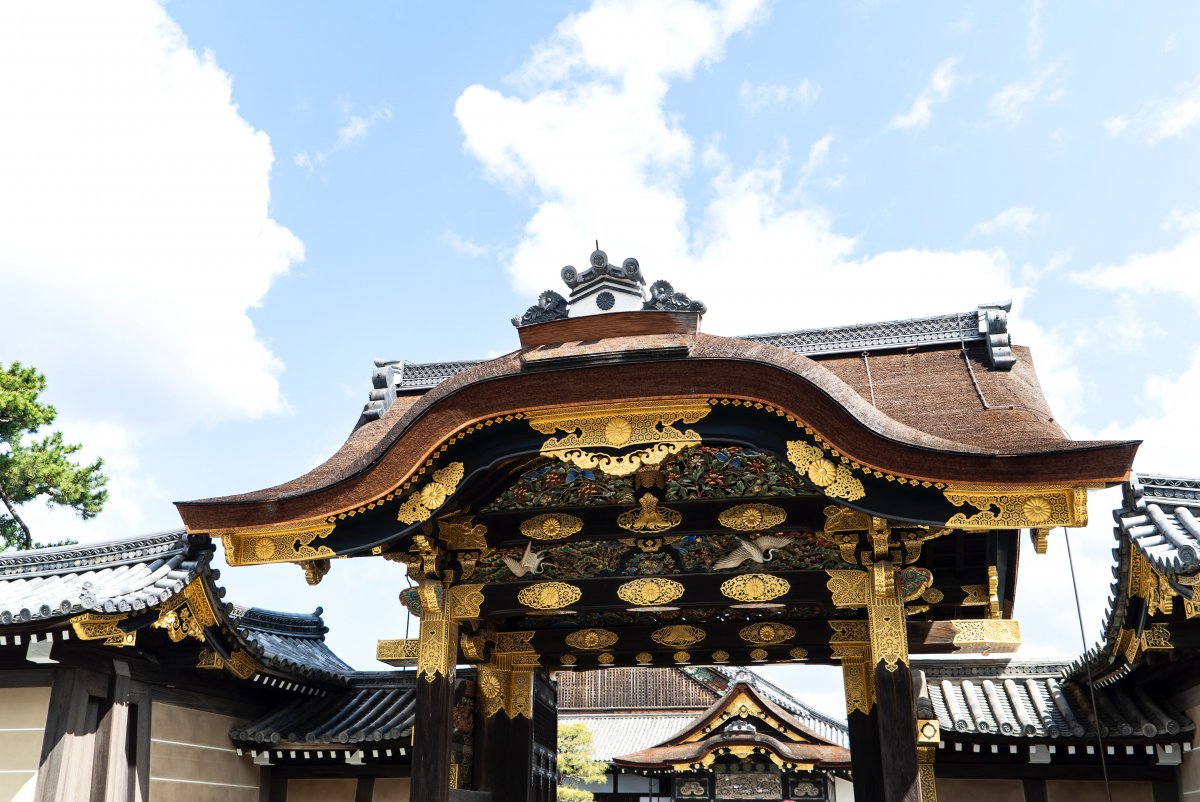

How far is Kyoto from Tokyo?
Private tours in kyoto from tokyo, shinkansen bullet train: fastest and comfortable, bus: cheapest, 1. comfortable plan: bullet train round-trip, 2. make the most out of your day: go by bullet train and return by night bus, 3. budget plan: round-trip by night bus, comparative table, you may also like the following articles.
Tokyo and Kyoto are the two most famous cities in Japan, and many tourists visit both cities. Even if you visit only Tokyo for a short period of time, it is still possible to visit Kyoto from Tokyo. In fact, if you have the time we recommend you to visit Kyoto. Even if you go there for one day, it will enrich your experience of Japan.
Kyoto is 2-3 hours away from Tokyo by Shinkansen, the actual time depends on which Shinkansen you take. It takes about 5-7 hours if you travel by bus or car and there are overnight buses as one of the options too. If you want to travel in the cheap way, you can get on the night bus around midnight and you will get to Kyoto early in the morning! Kyoto and Tokyo are very different cities and with visiting them both you will experience Japan ‘one step deeper’. You might not have thought of it, but you can even visit Kyoto from Tokyo for one day.
The easiest way for you would be our day-trip tour from Tokyo to Kyoto. This full-day guided tour allows you to see the best highlights of Kyoto in one day including Kinkakuji Temple (the Golden Pavilion), Fushimi Inari Taisha and Kiyomizudera Temple. The only thing you have to do is get to Kyoto yourself, which we can also arrange for you. But when you have a JR Pass, like many tourist have the Shinkansen in included. Check the link below for more details about the guided day-trip tour to Kyoto from Tokyo!
Kyoto 1–Day Private Walking Tour from Tokyo (8 Hours Tour in Kyoto)
Transportation to Kyoto
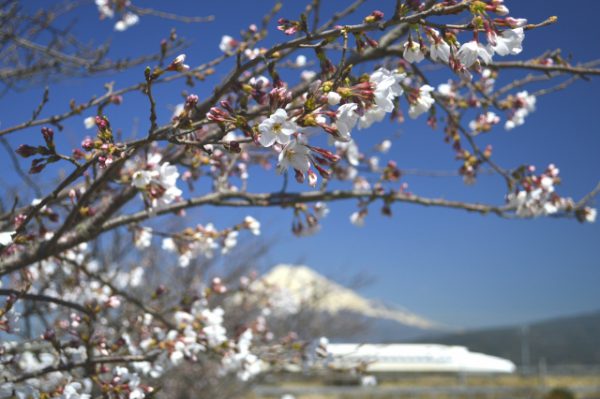
There are two options for transportation to get to Kyoto from Tokyo. 1. Shinkansen Bullet Train 2. Night Bus Let’s check out pros and cons of each one.
The fastest way to travel to Kyoto from Tokyo is by Shinkansen. The fastest Shinkansen called Nozomi takes about 2,5 hrs and costs ¥13.080 per person for one way. The Nozomi, however, is not covered by the JR Rail Pass. When you have JR Pass, it is better to take the second fastest Shinkansen Hikari . Hikari will get to to Kyoto in about 3 hrs with no extra charge! You can either board the Shinkansen at Tokyo station or Shinawaga station.
Our tips for the Bullet Train ride:
- From Tokyo to Kyoto: Reserve the seat E because you can see Mt. Fuji from the seat window on a sunny day. Mt. Fuji appears 40 mins after the departure of Tokyo.
- Tokyo station: Buy a Bento lunch box. There is a great variety of unique lunch boxes sold here and you can enjoy them during Shinkansen ride!
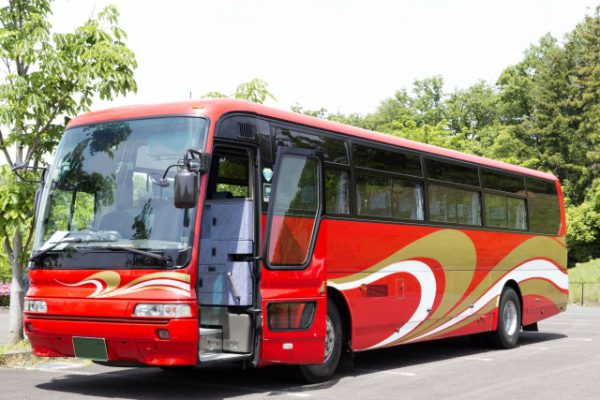
The cheaper way is taking a bus, especially the overnight bus. If you take a night bus, departure time from Tokyo is around 10-11pm, then arriving time in Kyoto is 6-7am.
The price varies on days. It costs usually between ¥1.700 and ¥6.000. The price may be higher on weekends and during the holiday season of Japan.
Recommended bus companies: ・ Willer Express ¥4.000 ・ VIP liner ¥4.000 ・ Sakura Kanko bus ¥1.700
Recommended itinerary for a day-trip to Kyoto from Tokyo
Transportation fee: approx. ¥ 26.000
08:00 – 11:00 Bullet train from Tokyo to Kyoto 11:00 – 18:00 Sightseeing in Kyoto for 7 hours – (Please check Kyoto itinerary here .) 18:00 – 21:00 Bullet train from Kyoto to Tokyo
Recommended hotels close to Tokyo station (Luxe and First Class)
The Tokyo Station Hotel Four Seasons Hotel Tokyo at Marunouchi Shangri-La Hotel, Tokyo
Transportation fee: approx. ¥ 15.000 – ¥ 20.000
08:00 – 11:00 Bullet train from Tokyo to Kyoto 11:00 – 08:00 Sightseeing in Kyoto for 7 hours – (Please check Kyoto itinerary here ) 18:00 – 22:00 Enjoy dinner and night activity in Kyoto 23:00 – 06:30 Back to Tokyo by night bus
Recommended budget hotels in Akihabara station – easy access to Tokyo station’s bus terminal.
GRIDS AKIHABARA First Cabin Akihabara Glansit Akihabara
Transportation fee: approx. ¥ 4.000 – ¥ 12.000
23:00 – 06:30 Go to Kyoto by night bus 06:30 – 08:00 Arrive in Kyoto and have breakfast 08:00 – 18:00 Sightseeing in Kyoto for 10 hours – ( Kyoto one day itinerary ) 18:00 – 22:00 Enjoy dinner and night activity in Kyoto 23:00 – 06:30 Back to Tokyo by night bus
To get most out of your visit to Kyoto, we recommend you to take a guided tour so you can see around Kyoto efficiently, especially when you are there for a short time! The local guide will tell you more about the history and culture of Kyoto. We offer many different tours in Kyoto, below the two most popular, please check them out!
Food Tour: Kyoto FooDrink Tour – Nishiki Street & Gion Private Tour: Kyoto 4 Hour HIGHLIGHT Private Walking Tour
What is your preferred mode of traveling? If you have your JR Rail Pass, the Shinkansen will probably be your best option – it is already included in the price. Otherwise the (much) cheaper night bus is a great alternative. Recently is has become much more comfortable than before so it is definitely a great option to go to Kyoto!
Is it hard to come to Japan right now? You can join our tour at home and learn about Kyoto before you come to Japan! Explore 5 spots including Kinkakuji, Arashiyama, Fushimi Inari etc. while the local guide telling you the small story about the area. Kyoto Virtual Highlight Tour
If you want some advice, please feel free to ask us Contact Japan Wonder Travel
Follow us on Instagram or Facebook for more travel inspiration. Or tag us to get featured!
Happy travelling!

This post may contain some affiliate links. When you click through and make a purchase we may receive some commission, at no extra costs to you .

Hi there! Thank you for the tip on this page! May I please ask if it’s advisable to take the Hikari there and back? And by what time should we take the Hikari at night?
Hi Vivian-san, Thank you for your inquiry. Of course you could use Hikari between Tokyo and Kyoto. You could use Hikari with JR rail pass. Then last train is about 8pm between Tokyo and Kyoto.(It takes about 3 hours.) If you have any question, please feel free to let us know.
Best regards, Yu
Hi.. in regards to the bus.. is it safe for non- Japanese speaking passengers? Is it comfortable? How do I get more details on the bus? I’m flying in to Haneda.. how do I go by bus from there?
Hi Husna-san, Yes it’s safe for non-Japanese speaking passengers. I used bus last month, some non Japanese speaking passengers were in bus. 3 seat-row is comfortable, 4 seat-row is bit tight, I think.
Please check bus’s company page. From airport, there is an airport limousine bus to Shinjuku bus terminal.
hello, is the bus travel from tokyo to kyoto at night, safe?
I often use bus and it’s always safe basically.
Hello! Would it be worth buying a JR pass just for this one day trip, as I am based in Tokyo and will only do one trip outside of Tokyo due to time. I’ve heard a return trip on the bullet train is as expensive as a JR Pass.
Don’t use the night bus if you’re claustrophobic, afraid of the dark, or need to look out of the window when you travel. The entire seated area is boxed off with curtains (you can’t see out of the windshield in front either), lights are not allowed, opening the curtains is not allowed. It’s supposed to create a relaxed environment but there’s nothing much relaxed about it. They’ve been pretty strict when I’ve tried to see where I’m going.
Thanks for your article! We will take the night bus from Kyoto to Tokyo, arriving around 7:00 in the morning. But the hotel does not accept baggage deposit and we can not check in before 15:00. Are there places where we can “crash” with our luggages and wait/rest a bit until we can check in?
What “crash” means? There are baggage storage services in hub station like Tokyo station. If you are tired and would like to have rest, there are many manga-cafe which have lots of comics. https://www.japan-guide.com/e/e2025_manga_kissa.html
The time is limited. So we recommend you leave baggage at storage service and explore the big city TOKYO.
Hi, of using bus, do you think 1 full day (10 hrs) is enough to tour Kyoto and Nara including travel time in between? What’s the travel duration? Thanks!
@Leah-san, Thank you for your comment. From Kyoto to Nara it takes about 1 hour. And you should spend at least 4 hours in Nara. We think it’s not enough for 10 hours in Kyoto and Nara. If you only have 10 hours, you should spend only in Kyoto!! Have a nice trip!!
Hello! What do you mean by “no extra charges” with the Hikari train if we use a JR Pass? Does it mean once we purchase a JR Pass, we are able to go inside the train instantly without paying? May I also ask how much the discounts are from Kyoto to Tokyo if we have the Pass? Thank you!
If you have JR pass, you take Hikari train free. If you would like to take Nozomi train, you need to pay extra. Please check http://www.japanrailpass.net/
hi, i will be arriving in Narita airport Tokyo on May 24 at 5pm, i want to go to Kyoto right away overnight bus. How can i get to the Will Express station from the airport?
Hello Arcadio Elegado-san,
Thank you for your comment. What’s “the Will Express Station”? Willer Express bus station in Shinjuku?
You need take NEX(Narita Express: JR train) or Air Port Limousine bus from Narita to Shinjuku station.
Is it possible to buy a return ticket for the bulletin train to Kyoto, or do you purchase two separate tickets for Tokyo-Kyoto Kyoto-Tokyo?
You will need to buy two one-way tickets for the Shinkansen. Let us know if you have more questions, happy to help! Enjoy your trip!
- Popular destinations
- Hidden places in Japan
- Tours and workshop
- Food and drink in Japan
- Itinerary in Japan
- Places to visit in Tokyo
- Food and drink in Tokyo
- Seasonal events
- Tours & workshops
- Tokyo This Week
- Day trip from Tokyo
- Itinerary in Tokyo
- Places to visit in Kyoto
- Food and drink in Kyoto
- Itinerary in Kyoto
- Day trip from Kyoto
- Travel tips
- Accommodation
- Cultural tips
- Transportation
- Tokyo Tours
- Kyoto Tours
- Kimono Rental
- Fukushima Tours
- Mount Fuji Tours
- Tour Package
- Media Kit(English/日本語)

Can I Do a Day Trip From Tokyo to Kyoto? Here’s How You Do It
Kyoto is an awesome city in the heart of Japan and a must-visit for anyone curious about Japan’s history and style. Imagine Kyoto as the ancient boss capital for more than a thousand years. This city keeps all its past stories alive through its old-school streets, mega temples, and gorgeous gardens. Embarking on a day trip from Tokyo to Kyoto might sound ambitious, given the distance between these two iconic Japanese cities (280 miles). However, with efficient transportation options and meticulous planning, it’s indeed possible to immerse yourself in Kyoto’s rich cultural heritage and return to Tokyo all in one day.
A day trip from Tokyo to Kyoto can be made by taking an early Shinkansen to Kyoto and returning to Tokyo in the evening. The first Nozomi Shinkansen leaves at 6 a.m. and arrives in Kyoto shortly after 8 a.m. The last train back is around 9:30 p.m. and the round-trip costs about 26,000 yen per person.
While it is possible to make a day trip to Kyoto from Tokyo, it is not the easiest day trip, so planning will be essential to have a good day trip. In this article, we’ll explore the logistics, transportation choices, and tips to make the most of your day trip from Tokyo to Kyoto.
Maximize Limited Time
Save money on accommodation, add flexibility, reduce packing hassle, tips to make the most of your day trip, is a day trip to kyoto enough, ashikaga flower park, why should you make a day trip to kyoto.
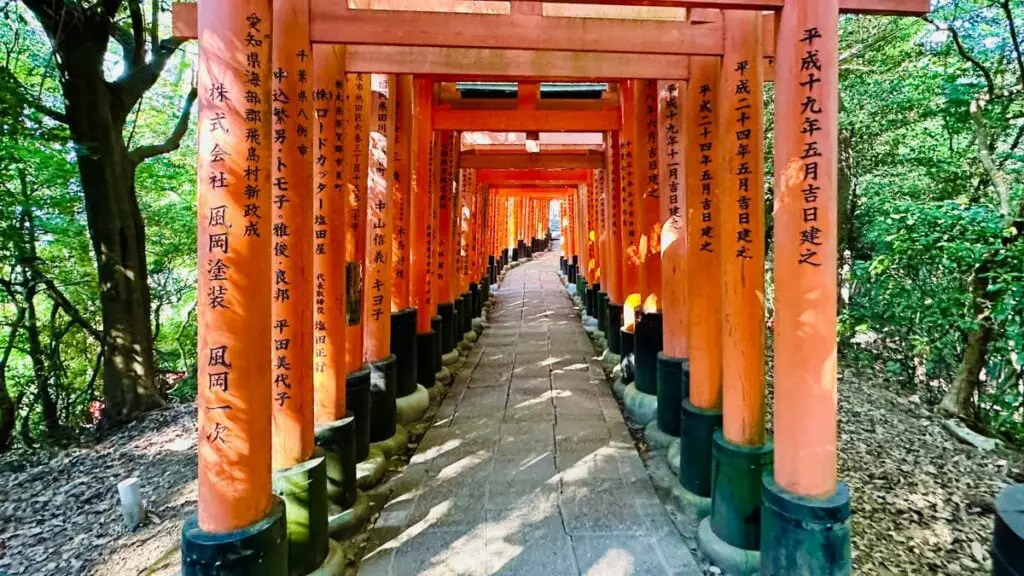
None will tell you that you will be able to see everything that Kyoto has to offer in one day, and I don’t recommend making a day trip to Kyoto if you have some days available on your itinerary. However, there are a few reasons that might motivate you to do a day trip instead of a longer stay.
A day trip from Tokyo to Kyoto is a popular option for travelers who are short on time or have tight schedules. If you’re juggling a busy itinerary or limited vacation days, day trips let you make the most of the time you have.
Short excursions are often lighter on the wallet for those on a tight budget . Staying overnight involves additional costs such as accommodation, while day trips allow you to enjoy new destinations without the added overnight expenses.
With a day trip, you have the flexibility to change plans on the go . If you discover a hidden gem in Tokyo or anywhere else during your trip, you can change plans without the constraints of pre-booked accommodations.
Hey, check out these recommendations I have for you!
Before going any further, take a look at some of the recommendations I've handpicked for you. I think these are essential items you should have on your trip to Japan. You can check them out and buy them directly from Amazon.
Traveling light is so easy with day trips . You can explore with just a small bag, avoiding the need for extensive packing and unpacking. This simplicity is especially appealing when using public transportation or walking around while sightseeing.
However, being realistic about what can be accomplished in a single day is important. You won’t be able to see all of Kyoto’s highlights and have to choose the most significant to you. With careful planning, it is possible to see a few of Kyoto’s most iconic attractions, but it is unlikely to be a comprehensive experience.
Kyoto Day Trip Itinerary
To give you an idea of what to expect from your day trip, I crafted this Kyoto day-trip itinerary for you. There are many attractions to see and things to do, so it can be challenging to plan a day trip that fits everything in. Of course, you can replace some places for those that you’re interested in, but keep in mind the distance between the places you want to see.
Also, a day trip from Tokyo to Kyoto can be quite rushed, especially if you are trying to see a lot of different attractions. It is important to give yourself enough time to enjoy each place you visit and not feel pressured to rush through everything. It is better to see fewer things than rushing through several places and not taking enough time to enjoy.
By the way, if need some ideas for things to see in Kyoto, you can check out my article about what to do around Fushimi Inari Taisha .
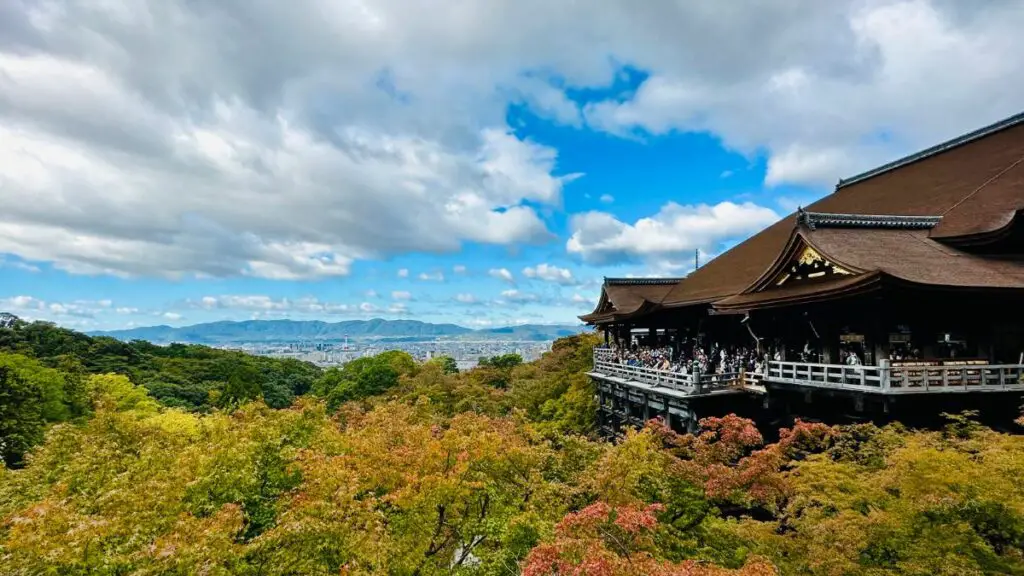
In the morning, you can visit Kiyomizu-dera Temple , one of Kyoto’s most revered temples perched on Otowa Mountain. Then continue to Sannenzaka and Ninenzaka , two historic streets in Kyoto renowned for their traditional ambiance and well-preserved architecture.
Start your day by leaving Tokyo on the first Shinkansen at 6 a.m. so you can arrive in Kyoto shortly after 8 a.m. The Nozomi Shinkansen has fewer stops and costs around 13,000 yen each way.
After arriving at Kyoto Station, take the JR Nara Line for 3 minutes and drop off at Tofukuji Station. Then change to the Keihan Main Line for another 3-minute ride and drop off at Kiyomizugojo Station. The trip costs less than 500 yen. From there, you have a 20-minute walk to Kiyomizu-dera Temple.
You should be at the temple around 9 a.m. if everything goes as planned, and enjoy the place for 1 or 2 hours, depending on your walking pace. When you finish your temple visit, head down to enjoy the Sannenzaka Path that joins Ninenzaka Street . These two streets are characterized by their preservation of traditional Japanese architecture. You’ll find various shops, teahouses, and souvenir stores along the way.
You can easily spend more than 1 hour if you do some shopping, and these streets are usually crowded during the day, so make sure you allow enough time. Consider spending a little less time at Kiyomizu-dera Temple, if you’re interested in traditional architecture and shopping for souvenirs. I spent a huge amount of time at the Oshido store buying my kimono and accessories, but I really enjoyed the experience of trying different kimono and accessories.
Once you’re done, you can have lunch at one of the nearby restaurants, or head directly to the Gion district and eat something there, as there are more places to choose from. If you pack your lunch, it’s even better because you won’t lose time, but it all depends on the type of experience you want to have.
To keep up with the schedule, you should leave Ninenzaka before 1 p.m.
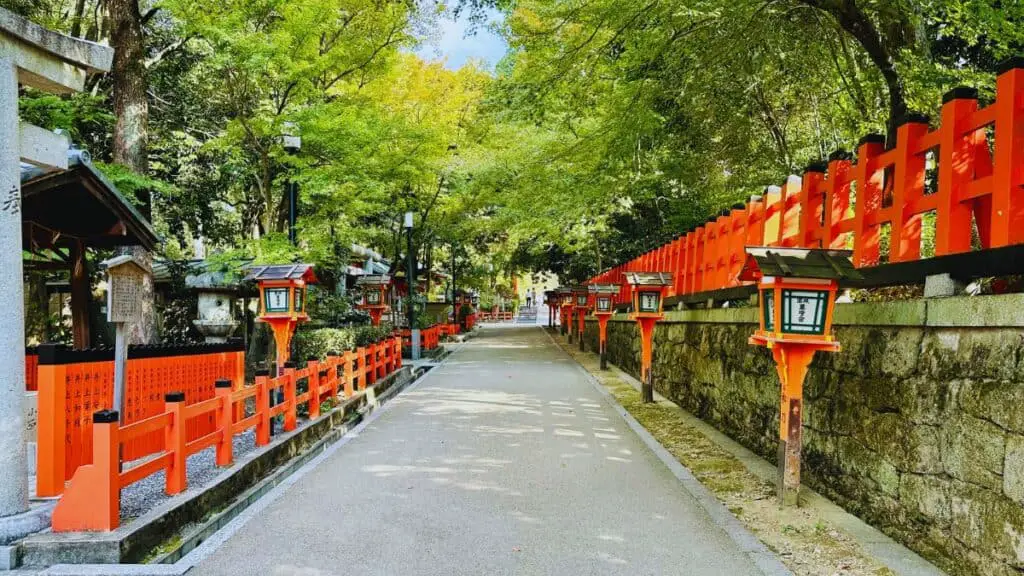
In the afternoon, you can immerse yourself in the vibrant atmosphere of Gion, Kyoto’s geisha district . Stroll along picturesque streets, admire traditional wooden houses, and perhaps catch a glimpse of a geisha in her exquisite kimono.
Assuming you allow 1 hour for lunch, you should be able to start exploring Gion around 2.30 p.m.
From Ninenzaka to Gion District, it’s only a 15-minute walk, so you can save money on transportation and enjoy the surroundings at the same time.
Start your afternoon by visiting Hanami-koji Street , Gion’s main street, known for its picturesque scene with well-preserved machiya houses and traditional establishments. Hanami-koji is known for being a place where geisha and maiko (apprentice geisha) can often be spotted. It’s customary to be respectful and discreet when observing these traditional entertainers.
Then, you can head to Maruyama Park and Yasaka Shrine . From Hanami-koji Street, it’s just a 10-minute walk to the shrine. Yasaka Shrine is adjacent to Maruyama Park, making it easy to visit both places. The shrine grounds are accessible 24 hours, so you can visit at any time, but you won’t be able to enter the closed buildings.
Around 5 p.m., you should be ready to cross the Shijo-Ohashi bridge and go to Pontocho Alley , a narrow and atmospheric alley known for its traditional machiya houses, teahouses, and restaurants.
In Japan, you can have dinner early, so it might be a good idea to experience one of the restaurants in Pontocho. Just make sure you’re ready around 6.30 p.m. to leave for your last visit of the day. From Pontocho to Gion-Shijo Station, you have to walk for 10 minutes.
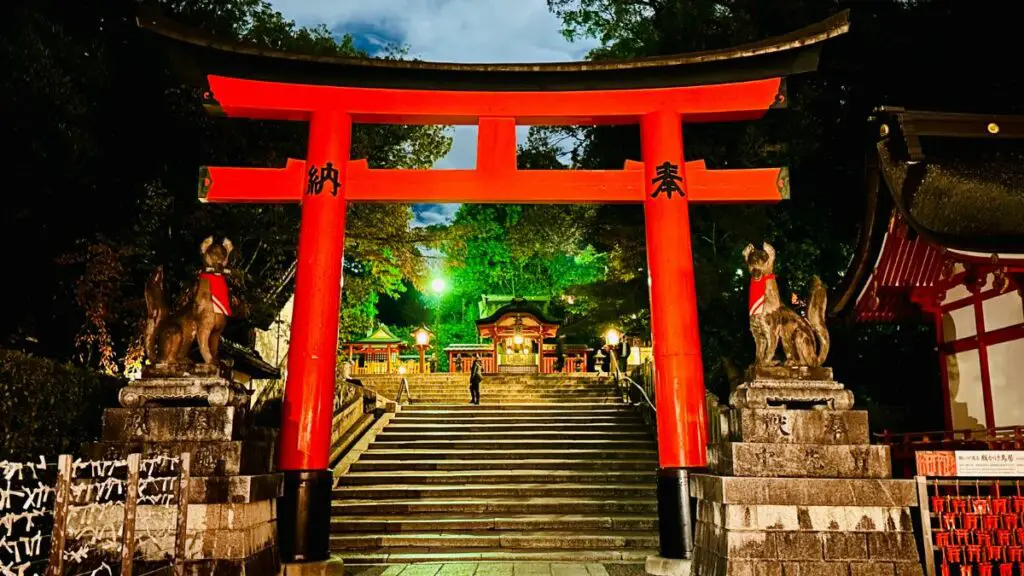
To finish your day trip with a highlight, head to Fushimi Inari-taisha Shrine , an amazing complex of thousands of vermilion torii accessible 24 hours.
From Gion-Shijo Station, take the Keihan Main Line and drop off at Fushimi-Inari Station. It costs around 300 yen and it takes roughly 10 minutes. From there, you have a 5-minute walk to the shrine, and you should be at the shrine before 7 p.m.
This shrine is huge, so you won’t have the time to head all the way up to the summit , but you can take really cool pictures of the illuminated buildings and the beginning of the torii path. I visited this shrine during the day and in the evening too. During the day, it is amazing, but also very crowded. During the night, it becomes a mystical place with few lights and almost no tourists.
You will have roughly 1 hour to enjoy this incredible atmosphere before heading back to Tokyo.
When you’re ready, go to Inari Station and take the JR Nara Line to Kyoto Station. The ride takes less than 10 minutes and costs around 200 yen. Please, notice that you have to go to the JR Inari Station, not the Fushimi-Inari Station. I recommend being at Inari station around 8 p.m. to allow enough time.
Once you arrive at Kyoto Station, you can get the Nozomi Shinkansen back to Tokyo. Keep in mind that the last Shinkansen to Tokyo is around 9.30 p.m., so try not to miss it, otherwise, you will have to stay in Kyoto for the night.
As you can see, a day trip from Tokyo to Kyoto can be quite tiring, especially if you are trying to see a lot of different attractions. It is necessary to give yourself enough time to enjoy each place you visit and not feel pressured to rush through everything, so adjust your itinerary throughout the day if needed.
Following the itinerary I gave you, you will have a long day trip, but you will also manage to see a few highlights. By taking the Nozomi Shinkansen, you will spend around 4 hours and 30 minutes in transportation from Tokyo to Kyoto and back, and around 10 hours sightseeing in Kyoto.
Here are a few tips and recommendations to help you out during your day trip.
- Purchase your Shinkansen tickets in advance: This will guarantee a seat and save you time at the train station.
- Plan your day strategically: Follow the itinerary above or choose attractions that are close to each other to minimize travel time.
- Wear comfortable shoes: Kyoto is a walking city, so be prepared to explore on foot.
- Carry a portable charger: Your phone will be your guide and navigator, so keep it charged throughout the day.
- Respect local customs: Be mindful of cultural etiquette, such as removing your shoes before entering temples and shrines.
- Purchase souvenirs: Kyoto offers a wide choice of authentic souvenirs, from delicate kimonos to delectable snacks and traditional souvenirs.
A day trip to Kyoto is not enough to experience all the must-visit places in the city. Still, it is possible to have a glimpse at what Kyoto has to offer in one day. To explore the rest of Kyoto’s highlights that are further away, you need at least three full days.
With the 1-day itinerary I gave you, you can visit 8 places in Kyoto in about 10 hours depending on your walking pace and interests. You can even add Kodai-ji Temple or Chion-in Temple to your itinerary if go for a faster pace. Just be careful not to add too many places and end up rushing all day.
Easier Day Trips From Tokyo
If you don’t feel like doing a day trip to Kyoto after reading all this, or you want other ideas for easier day trips from Tokyo, here are a few examples.
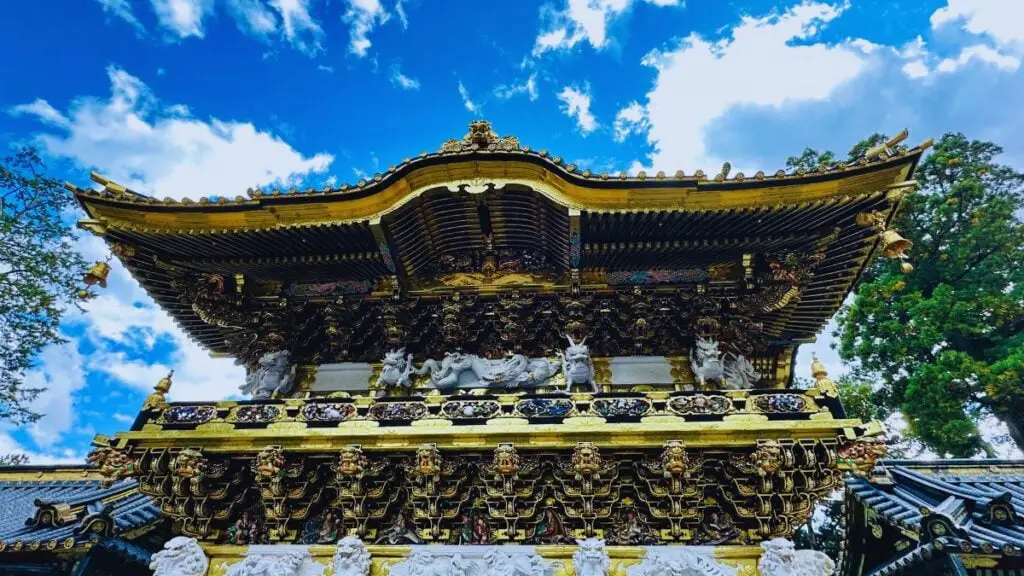
Nikko, known for its ornate Toshogu Shrine and stunning natural landscapes, is just a two-hour train ride from Tokyo. The ease of access and the UNESCO World Heritage sites make it a perfect day trip.
For more information about Nikko, check out my other article here.
Kamakura, with its Great Buddha and historic temples, is only about an hour away from Tokyo by train. The compact layout of its key attractions allows for a fulfilling day exploring its rich cultural and historical heritage.
Enoshima, a small island town with beaches and shrines, is less than an hour from Tokyo. Its relaxed coastal environment and the iconic Enoshima Shrine make it an ideal getaway for a day of sightseeing. This day trip is usually combined with Kamakura.

Hakone, famous for its hot springs and views of Mount Fuji, is around 90 minutes from Tokyo. The diverse attractions, including museums, a ropeway, and a cruise on Lake Ashi, offer a varied and enjoyable day trip.
If you want to know more about Hakone, check out my other post about it.
Yokohama, located just south of Tokyo, boasts attractions like the Landmark Tower and the historic Sankeien Garden. Its proximity and the mix of modern and traditional make it an appealing day trip option.
Known as “Little Edo,” Kawagoe is only about 30 minutes from central Tokyo. Its well-preserved Edo-period architecture and the Kurazukuri Street provide a charming and easily accessible historical experience.
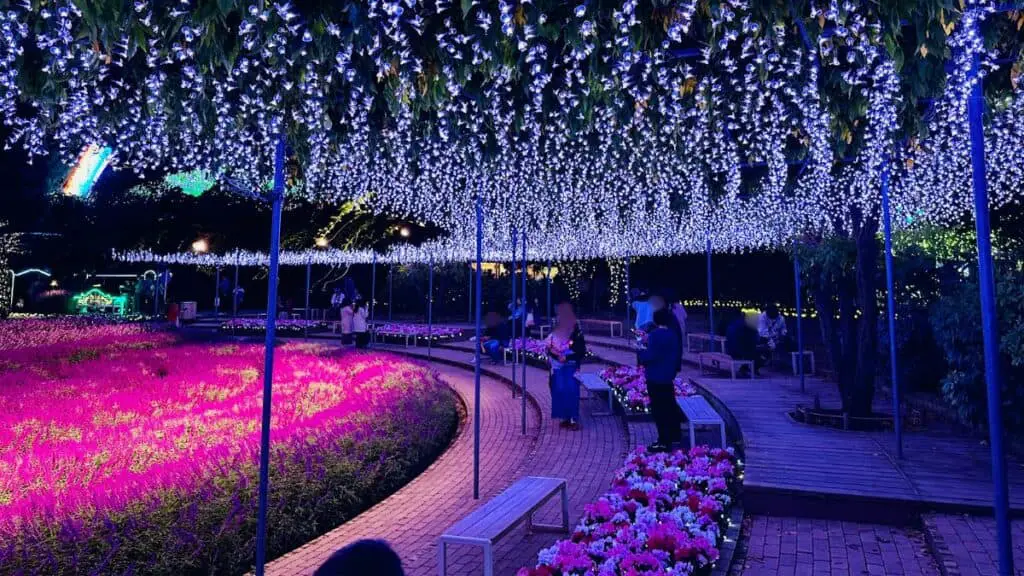
Ashikaga Flower Park, situated in Tochigi Prefecture, is known for its stunning wisteria displays and seasonal flower exhibitions. While it’s a bit farther, approximately two hours from Tokyo, the enchanting floral landscapes, including the famous Great Wisteria, make it a unique and visually captivating day trip.
While you can do it as a day trip on itself without rushing, you can also combine Nikko and Ashikaga Flower Park on the same day trip. That’s what I did on one of my trips to Japan, but I missed out on a few things in Nikko. You can check more information about Ashikaga Flower Park in my other article .
While a day trip from Tokyo to Kyoto requires meticulous planning and an early start, the rewards are immense. From ancient temples to scenic landscapes, Kyoto offers a glimpse into Japan’s rich history and culture. With efficient transportation and a well-thought-out itinerary, you can easily navigate this journey and return to Tokyo in a day.
The 2-hour shinkansen ride back to Tokyo will allow to recover a little from this day before getting to your hotel.
Anf if you decide not to do a day trip to Kyoto, because this city has much more to offer, you can always pick easier day trips from Tokyo like Nikko, Kamakura, Enoshima, Hakone, Yokohama, Kawagoe or Ashikaga Flower Park.
Happy travel!
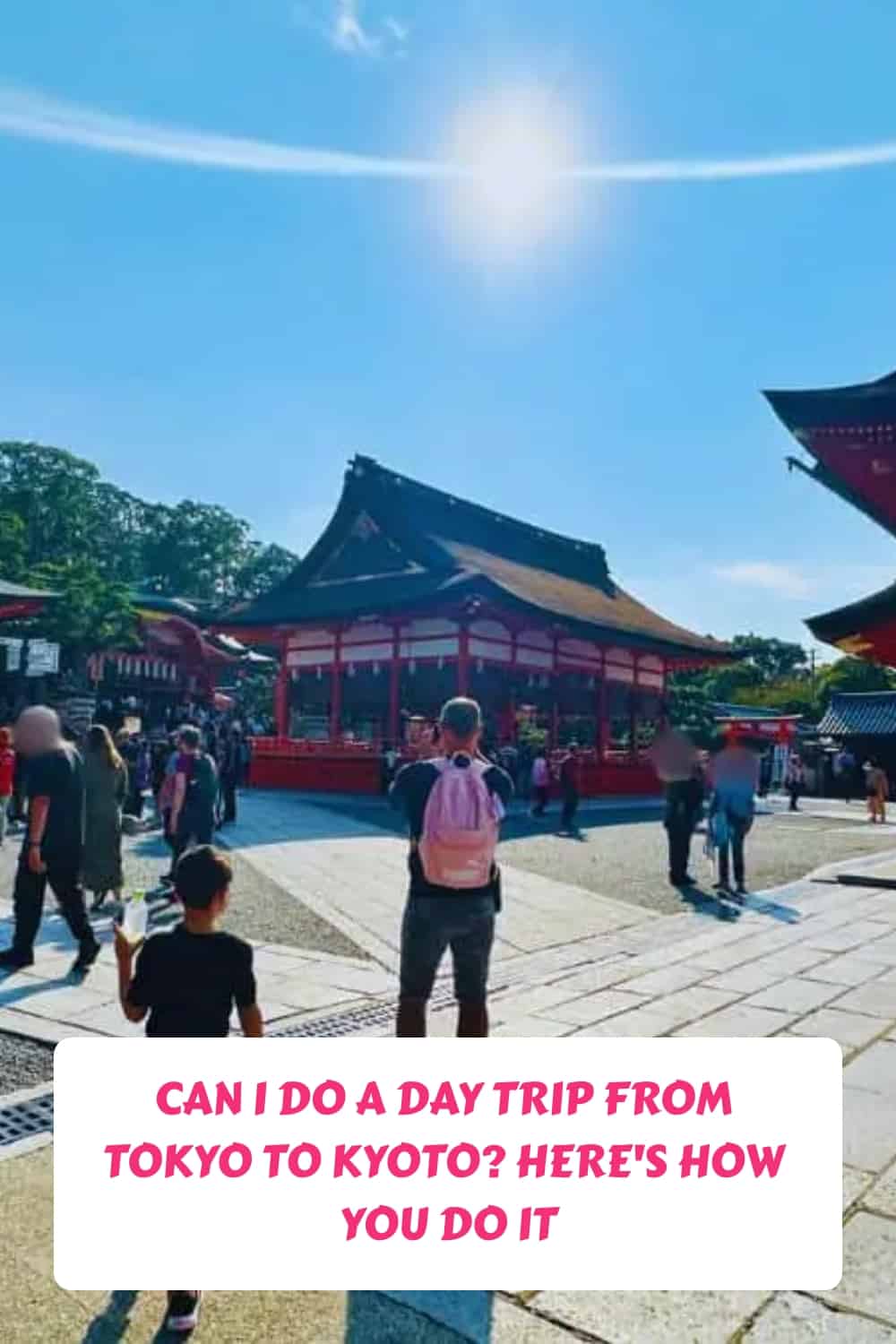
About The Author
Related Posts
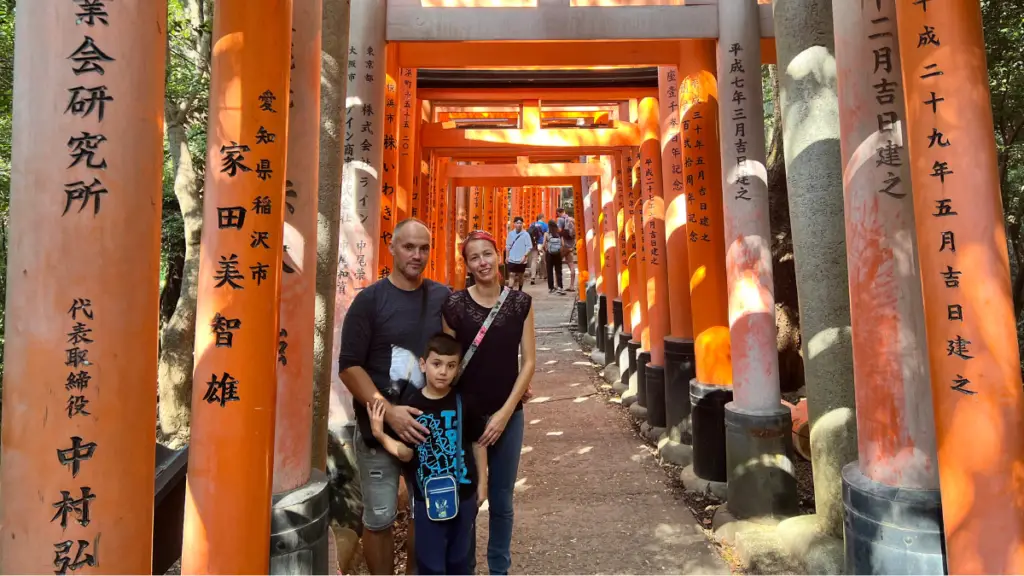
Should I Bring My Kids to Japan?
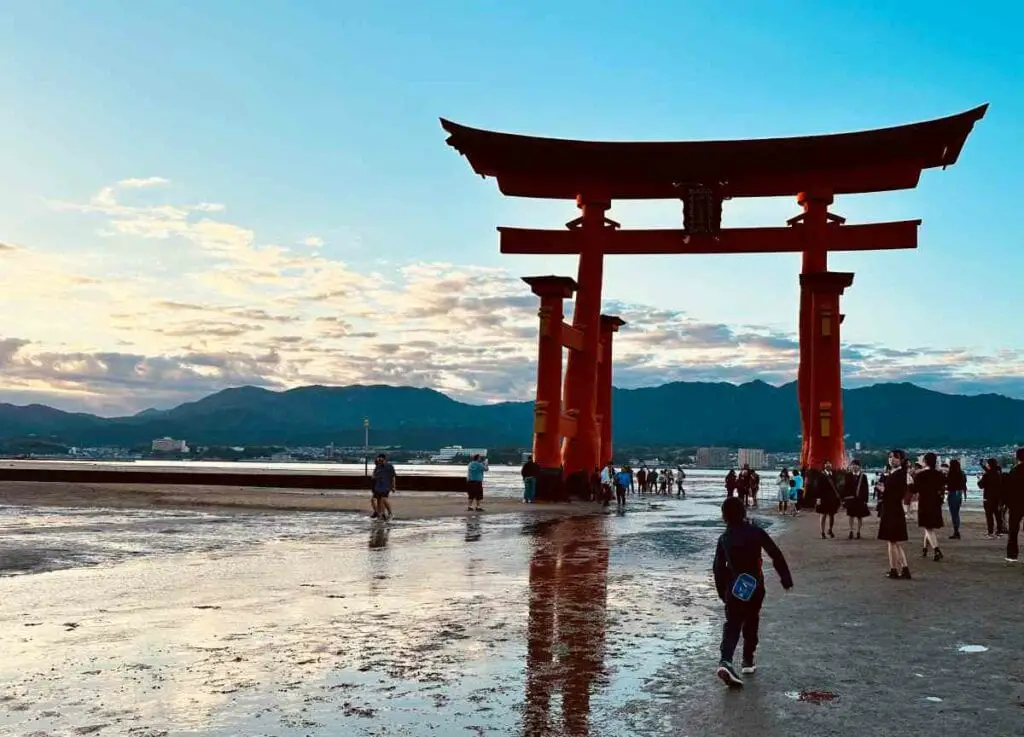
Japan Weather Month by Month: Best Time to Visit
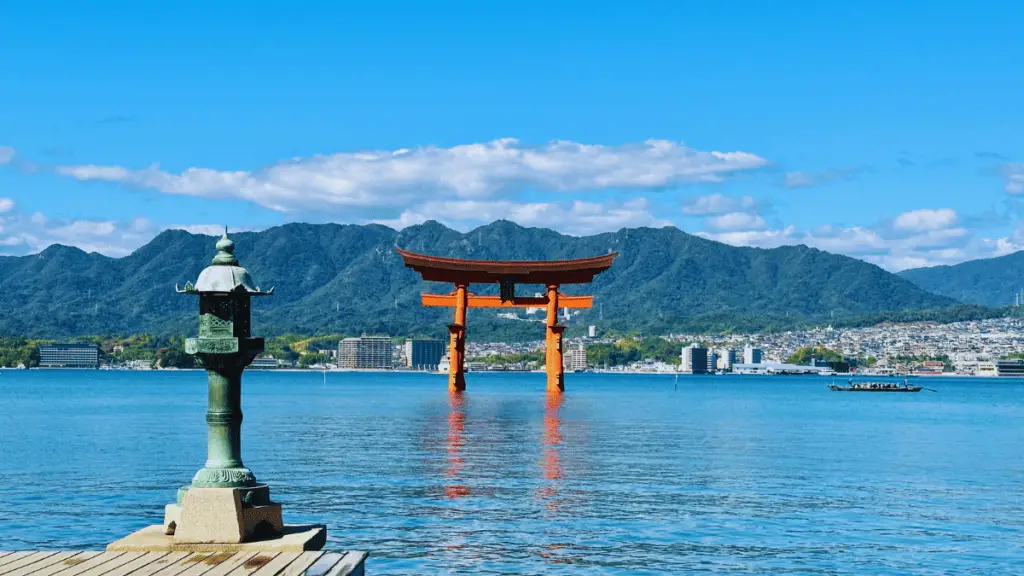
Is Miyajima Worth Visiting?
Leave a comment cancel reply.
Your email address will not be published. Required fields are marked *
Save my name, email, and website in this browser for the next time I comment.
Kyoto Day Trip from Tokyo: Complete Guide with Best Tour Options
By gowithguide travel specialist: akane n..
Itinerary Ideas

Are you planning a day trip to Kyoto from Tokyo? Some people would say a one-day trip is impossible, but actually, your two-way trip should only take around 12 hours. Of course, your time will be limited so you’ll only be able to see a few of the most famous sightseeing spots. However, after your day trip to Kyoto, you’ll be able to use the remaining time during your short stay in Japan to see other cities.
When you only have a short time for sightseeing, you need to make sure your itinerary is well thought out. You don’t want to be running around from one end of the city to the other. That would just be a waste of transportation time, so you want to have the sightseeing spots you plan to visit as close together as possible. And you want to make sure you’re able to get back to Kyoto station in time to make your train back to Tokyo in the evening.
Here at GoWithGuide , we can help you find the right guide or tour for your Kyoto trip. But If you want to save even more time, you can simply send a request , telling us what you need, and we’ll match you with the right guide who can create your perfect Kyoto itinerary.
Kyoto One Day Trip from Tokyo: Access and Highlights
Kyoto Access
- By Shinkansen
The easiest way to go to Kyoto from Tokyo is by using the Shinkansen or bullet train. There are several types of Shinkansen, but you need to get on the “Nozomi”, which only takes about 2 hours 20 minutes. And the cost is about 13,320 yen one way per person for free seating cars and about 14,000 yen for reserved seating. So you’re looking at a total of 26,800 - 28,200 yen total per person.
For people who want to go even cheaper, you can use the red-eye buses. They depart from the bus terminal in Shinjuku (BUSTA Shinjuku) at maybe around 11 or 12 pm and arrive in Kyoto early the next morning at 6 or 7 am.
While the fares vary among companies, the cheapest price you can get for a one-way ticket is around 3000 yen per person. But make sure you can sleep on a bus and have the stamina to walk around Kyoto the next day. I wouldn’t recommend it, but it’s one way to save money and travel in comfort for low prices! The perfect choice for the smart, frugal traveler! Find the most affordable for you and book a ticket here !
On the Way Back
The last bullet train back to Tokyo is a little past 9 pm. So you can stay in Kyoto until after dinner if you want to. But it will mean getting back to Tokyo a bit before midnight. The very last train may be crowded so make sure to get to the station early so you have a few choices about which train to take home.
Famous Kyoto Sightseeing Spots
Below are a few main sightseeing spots you may want to visit in Kyoto. Despite the time constraint, you’ll be able to see 3 to 4 sightseeing spots before leaving the city.
Kinkakuji Temple (Golden Pavilion)
Kinkakuji or the Golden Pavilion is one of the most famous landmarks in Kyoto. The golden building stands in the middle of a small lake and is reflected onto the surface of the water. It’s an amazing sight you won’t see anywhere else in the world. It is a Zen Temple originally built in 1397 as the residence of Yoshimitsu Ashikaga, a “shogun” or military commander. This building is covered in gold leaf so it glitters when the rays of the sun hit it. And it is a wonderful sight in every season, whether the surrounding area is full of the green leaves of spring and summer, or the colorful colors of autumn, or capped with snow in winter.
Fushimi Inari Shrine
Fushimi Inari Shrine has become famous in recent years among foreign tourists for its tunnel of 10,000 red “torii” gates. It really is an awe-inspiring sight and of course, a fantastic photo spot. It’s an important Shinto shrine located in the Fushimi Ward of Kyoto. It stands at the base of a mountain and there are trails that go up into the mountain, suitable for a scenic 2 - 3 hours hike.
The thousands of “torii” gates line these hiking trails, dwindling in number as you go up. But you don’t have to go all the way to the summit if you don’t want to or don’t have the time to. You can go up a bit and turn back at any point.
Nijo Castle
Nijo Castle is a World Heritage Site, built in 1603. It was the residence in Kyoto of Ieyasu Tokugawa, the first “shogun” or military commander of the Edo era. Other palace buildings and a five-story castle keep were added to the castle later on by his grandson. After being used as an imperial palace for a while, it was donated to the city and opened for public viewing. It is one of the best examples of castle architecture in Japan and important historical heritage.
There are two palace buildings at Nijo Castle, the Honmaru Palace, and the Ninomaru Palace. Since the Honmaru Palace is seldom open to the public, the Ninomaru Palace is the main highlight of this sightseeing spot. The traditional Japanese gardens are also something to look forward to. There are several different types of cherry blossom trees around the castle, so you’ll be able to see them from late March to the end of April.
Kiyomizudera
Kiyomizudera Temple is another World Heritage Site in Kyoto. It is famous for its large balcony, called a "stage", outside the main hall. The main hall’s roof is going through renovations until March 2020, so you won’t be able to see the whole of the beautiful temple. However, you’ll still be able to explore the hall from the inside
The view of the cherry blossoms from Kiyomizudera Temple in the spring is simply breath-taking! And so are the autumn colors of the maple trees. There is also a street leading up to the temple called Kiyomizuzaka. It's a great place to shop for souvenirs and try Japanese sweets in the cafes. Many people enjoy this street more than the temple itself.
Gion's Geishas and Temples
Gion (祇園) is Kyoto’s most famous geisha district, located in front of Yasaka Shrine around Shijo Avenue. The district has developed in the Middle Ages as one of the most exclusive geisha districts in Japan. So what exactly is Gion’s aesthetics? Gion attracts tourists with its streetscape lined with traditional wooden machiya merchant houses, which are preserved for many decades. Hanami-koji street is the most touristic street of Gion offering shops, restaurants, and ochaya (tea houses), where geisha and maiko (geisha apprentices) perform shows to entertain guests.
Apart from temples and shrines, Gion and geisha culture also take big parts of Kyoto’s history and it’s a great place to explore the real color of the city.
Visitors can enjoy Gion all year round but the best time to visit would be in spring when cherry blossoms are blooming. Cherry blossoms perfectly suit the scenery of old Gion street. The most recommended view spot is by the Shirakawa Canal, which passes through the Gion district. Light-up of the trees is held during the season (late March to early April).
Arashiyama Bamboo Forest
Walking through the soaring bamboo stalks of the densely packed Bamboo Forest in the shadows of the morning light is eerily beautiful and incredibly serene. The Bamboo Forest thoroughly deserves its spot as an iconic Kyoto sight and one of its most photographed spots! But no picture can capture the feeling of standing in the midst of this sprawling bamboo grove – the whole thing has a palpable sense of otherness that is quite unlike that of any normal forest we know of.
Here is a tip! The Bamboo Forest is hugely popular and gets extremely busy throughout the day. Arrive early and you will have the place to yourself for a short time after sunrise to capture some amazing pics!
While you are here, don’t forget:
Toei Kyoto Studio Park
This is the theme park for people who want to transport back into old, old-school Japan. Located in the ultimate cultural exploratory Kyoto, TOEI Kyoto Studio Park is part movie set and part theme park. If you love ninjas and Japanese film and literature, this is the spot for you.
Allowing you to wander through tv sets and explore familiar scenes, you can also attend performances including a ninja battle, a behind-the-scenes show, a guided tour led by an actor, street performances and a super-hero show in summer. There are a number of traditional restaurants and old-style coffee shops as well as a ninja-cafe and shops to browse too. There are different activities to try out but some cost extra – a bulk ticket can be bought offering four activities for 400 yen each, or you can purchase individual activities for 500 yen individually. Try out Escape the Castle, Ninja Training, a 3D maze or haunted house among others!
Opening hours: 9 AM - 17:30 PM (some variations depending on month and day of the week) Pricing: Adults: ¥2,200 High School students: ¥1,300 Middle School students: ¥1,300 Elementary School students: ¥1,100
Above are only some of our suggested destinations in majestic Kyoto.among so many more. However, since you only have limited time, it is worth thinking hard about the logistics of your trip. It will certainly be a shame if you miss any of Kyoto’s aesthetics. This is where having a local guide’s knowledge about the city comes in handy. They’ll plan your day according to what is possible timewise while also trying to incorporate the places you want to visit.
Want to make your Kyoto trip more Interesting? Here's how!
GoWithGuide provides the best private tours and local guides across Japan! On GoWithGuide, you can find the best professional local guides all across Japan to help you plan your trip. Check our private tours to Kyoto .
Want to know how you can enjoy your tours to the fullest, especially if you are visiting Japan on a hot summer day? Explore all the amazing aspects of Kyoto and Japan with your personal van while escaping from the fierce heat and the hassle of public transportation! Save your transportation time for leisure time with your loved ones in your private car ! Also, discover what exciting cultural experiences in Japan you can gain here !

If you are interested to know more and save your time during your trip to Kyoto, you can send a message to our local guides to get a customized itinerary and quotation for an unforgettable experience.
On GoWithGuide website, you can book a Tokyo to Kyoto day trip and have a tour guide take you from Tokyo to Kyoto and back. Or, you can make your way there by yourself and start your private tour of Kyoto from the moment you arrive. In this case, make sure to tell your guide at what time you’ll be arriving in Kyoto and have them pick you up at Kyoto station.
You can also request your tour personally customized, if you wish to have a tour that fits your pace, your schedule and enables you to discover Kyoto in a unique way. Just type what you would like to see and guides all over Kyoto will send you quotes and their recommendations according to your interest and budget.
Recommended Local Guides Tours in Kyoto
Below are links for tours you might want to look into, both for a tour starting from Tokyo and for local tours in Kyoto.
Day Trip to Kyoto from Tokyo by Local Guide Yuki
6 hour Kyoto exciting private tour by Local Guide Toshiyo
Kyoto Kiyomizu and Fushimi tour by Local Guide Makoto
Kyoto Must-See Spots tour by Local Guide Moe
If you can check the full list of Kyoto tours by Local Guides click here .
For more Japan tours, choose your favorite destination here .
Recommended Blogs:
Gion Kyoto: Complete guide before you go
Kyoto 1 day guide: The best full-day tour for your trip to Kyoto
Transportation in Kyoto, Osaka, Nara and around
Kyoto Tours: The 9 Best and Most Popular Tours by Local Tour Guides
Popular Kyoto Tour Guides
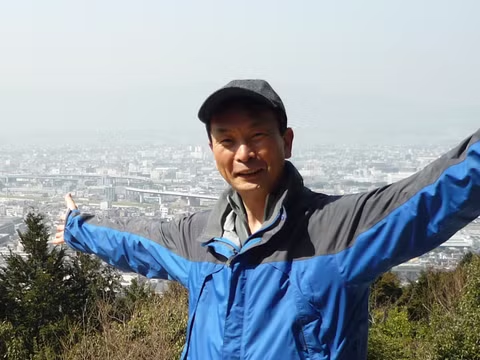
Hi! I'm Koichi. I was born in Osaka, I studied in Kyoto when I was a university student. Now I live in Shiga next to Kyoto. I am a national government licensed tour guide. I have been guiding about 160 groups over the past twelve months. I usually guide my customers mainly in Kansai region including Kyoto, Nara, Osaka, Kobe and Shiga by public transportation systems. Well, I am curious about Japanese history, especially the history of Japan's ancient times since I was raised next to the world biggest mausoleum of the ancient Emperor called "Nintoku" in Sakai city Osaka which has just become one of the world cultural heritage sites. I dug out some ancient earthen ware vessels around there when I was a primary school student like the adventure archaeologist “Indiana Jones" (It’s our secret!!). That was my hobby. Now, one of my hobbies is outdoor activities such as mountaineering, kayaking, skiing and others. So I would like to take you to some good places where you can enjoy Japanese unique nature. I love to guide foreign visitors from all over the world. I think it is my calling or heavenly given job. Let's go and enjoy together! I hope to see you soon.
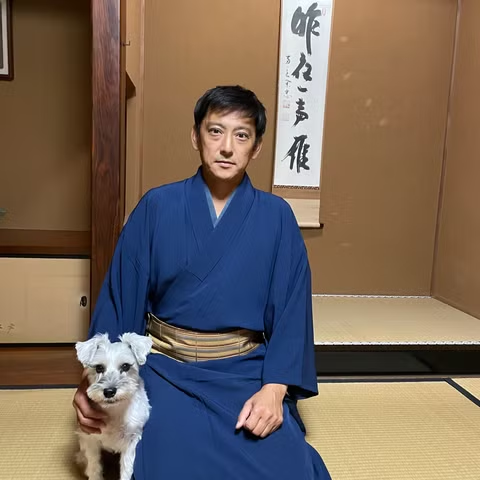
I have lived in the US, UK, and India for approximately 20 years, and I’ve also traveled to many other countries. Living abroad for such a long time made me realize Japan’s value and sparked my interest in working as a translator/guide for foreigners. I’m truly passionate about introducing people to historical sites, authentic Japanese culture, and stunning natural spots that may not be widely known to people outside of Japan. There are countless places that I believe people would love. Originally from Nagoya, I cover areas around the city and the Kansai region including Kyoto, Shiga and Mie. I’m here to ensure your trip to Japan becomes an unforgettable memory. Looking forward to meeting you!
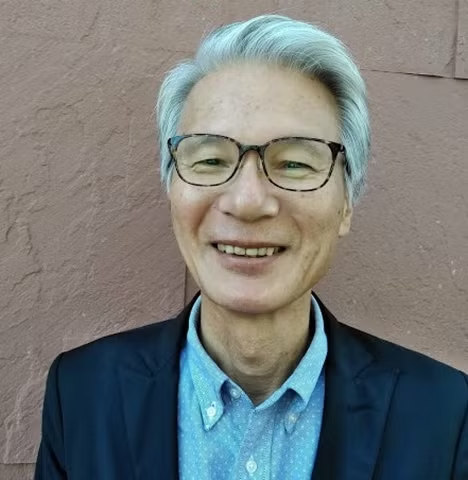
Hiroyuki T.
Hi i had been working for wakayama prefectural government for 38 years, mainly in the field of cultural heritage management and international relations. i am a national certificated english guide and i have a lot of knowledge and experience in the field of cultural heritage management and international relations. i am very good at cultural heritages. and koyasan and kumano in wakayama prefecture are inscribed in the world heritage list as parts of “sacred sites and pilgrimage routes in the kii mountain range". i was a project manager of "the koyasan and kumano world heritage inscription project” at wakayama prefectural government. i know inside and out of koyasan, kumano, wakayama and other places in the kansai area. i have a lot of experience of guiding as i was also in charge of international relations for a long time at the government. i will be able to provide interpretive guiding service for you around koyasan, wakayama, osaka and other places in the kansai area as i am a cultural heritage management and international relations professional. i am sure you will be able to get deeper understandings on japanese culture and that your trip with me will be memorable one. .

Yoshihisa T.
Hi. my name is yoshihisa. call me "yoshie", please. it means good or o.k. in japanese. i live in joyo city, kyoto prefecture, located just in between kyoto and nara. i was born and raised in iga, mie prefecture. iga is a birthplace of ninja and a renowned haiku poet, matsuo basho. i might be a descendant of ninja. i aim at becoming a linguistic ninja, following a part of basho's lifestyle with the incorporation of seasonal changes into my tours. in addition to visiting famous temples and shrines, i invite you to lesser-known places of historic interest. once in a month i go hiking or mountain climbing with some friends mainly in mountains surrounding kyoto and nara basins. recently i have got intrigued by the charms of buddhist statues, which are manifestations of people's wishes and prayers. i also like izakaya (japanese-style taverns) hopping, tasting delicious dishes and locally brewed sake at reasonable prices. especially i like communicating with people from home and abroad, talking face to face. some of the above-mentioned elements are included in my walking tours. i hope you will discover new aspects of cultural and natural beauty in kansai area through one of my tours which you could never gain otherwise. one of my favorite phrases that come from zen buddhism is ichigo ichie or this meeting-but only once in a lifetime. my interpretation goes this way: this place and this moment never cross again. each and every good encounter, however, lingers on like the sound of a temple bell. won't you explore a deeper world of japanese culture in kyoto, nara and osaka with me , plan your trip to kyoto.
Chat with a local tour guide who can help organize your trip.
Related Blogs
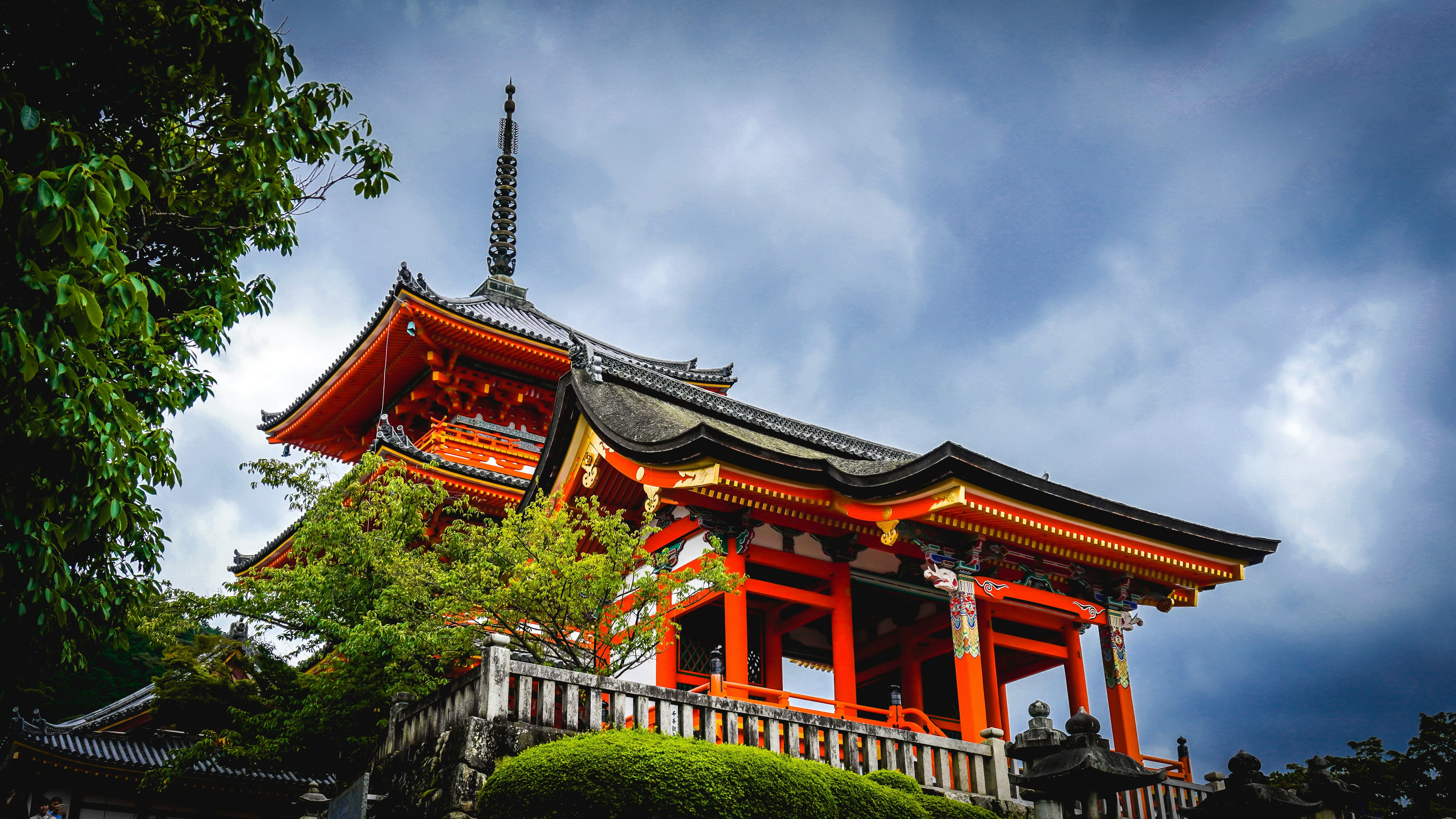
The 20 Most Beautiful Shrines And Temples In Kyoto
Kyoto, Japan
Kyoto, an ancient city with long history, was always on the list of word’s top city. In the recent years, it was even voted the word’s top city by rea...
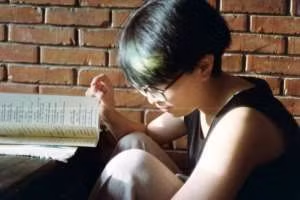
Traveling to Kyoto from Osaka: One day trip
If you’re looking for information about a one day trip to kyoto from osaka, you’re in the right place. kyoto is a great place to go on a day trip sinc....
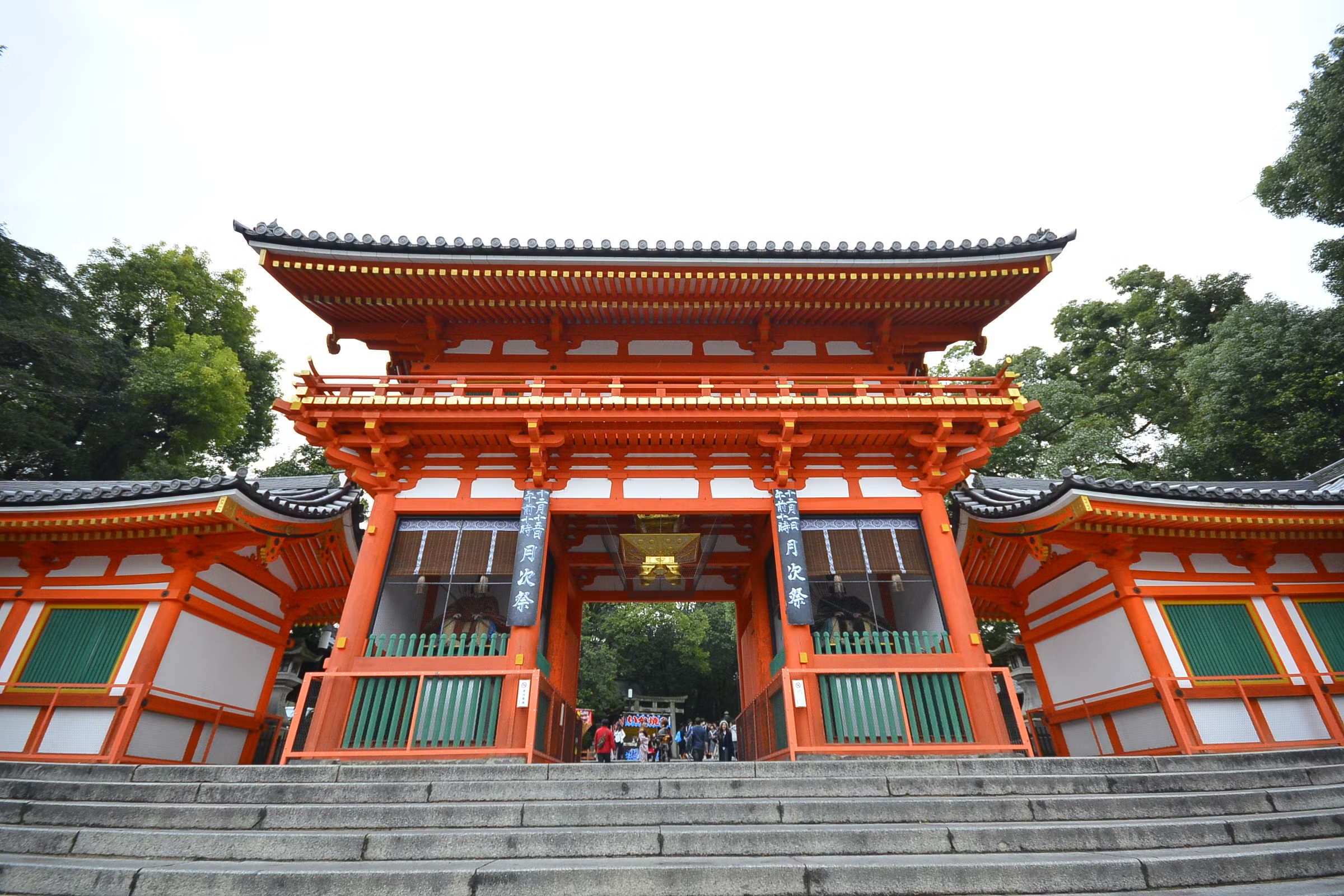
The 5 Best Places To Visit In Kyoto In December
Kyoto is one of the most popular cities for people around the world to visit. the city draws crowds of travelers all time of the year.kyoto in winter ....
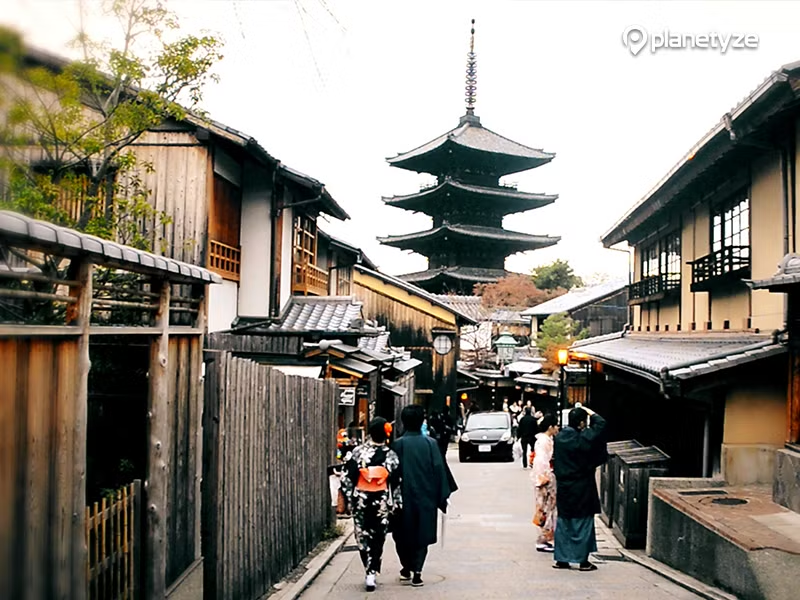
Top Things To Do And Visit In Gion
Gion is the most famous geisha area and sightseeing spot in kyoto. many tourists come to enjoy this area on foot, walking along the street, stopping b..., follow us on social media.
- Tokyo Cheapo (繁體中文)
Tokyo to Kyoto: The Fastest and Cheapest Ways to Travel
Kyoto is such a popular destination from Tokyo, and there are many ways to make the trip. The bullet train (aka the Shinkansen) — our favorite way to travel — can get you there in under 2.5 hours; other budget options include cheap flights and highway buses.
How to get from Tokyo to Kyoto
Kyoto is about 370 kilometers (225 miles) west of Tokyo. It’s part of the Kansai region, and thus actually much closer to Osaka : the two cities are about 30 minutes apart on the train. Coming from Tokyo, you’ll reach Kyoto before Osaka.
Top choice: Shinkansen
The fastest, easiest, and most convenient option is the Shinkansen, especially if you have a Japan Rail Pass . The cheapest option is usually a highway bus, followed by flights — but these are both a bit time-consuming.

Comparing Tokyo to Kyoto travel options
Here’s a quick overview of all the different types of transport.
Taking the Shinkansen from Tokyo to Kyoto
From ¥ 13,320 2 hours and 15 minutes (fastest service) Buy a one-way ticket on Klook or Rakuten Travel Experiences , or a JR Pass in advance
The Tōkaidō Shinkansen connnects Tokyo and Kyoto (and terminates one stop further, at Shin-Osaka Station). It’s a direct route, so you won’t usually need to transfer. There are three services on this line: Nozomi, Hikari, and Kodama; the travel time and cost varies by service.
Tōkaidō Shinkansen services to Kyoto
Nozomi is the fastest service on the Tōkaidō Shinkansen, and for this reason it costs a little bit extra. Note that the JR Pass covers travel on all services, including Nozomi.
Note: If you’re traveling during off-peak season, you can knock ¥ 200 off the reserved seat price. During peak season it’s an extra ¥ 200 (and an extra ¥ 400 during super-peak season). For more information on seasonal price fluctuations, see our breakdown of how Shinkansen fares are calculated .
Hikari and Kodama services are priced the same, even though Kodama services take signficantly longer — taking between 3.5 hours and 4 hours to make the trip between Tokyo and Kyoto!
Kodama services also stop at more stations, like Odawara, which is convenient if you want to work in a visit to Hakone on the way from Tokyo to Kyoto.

Departing Tokyo for Kyoto
You can board any Tōkaidō Shinkansen service for Kyoto Station at Tokyo Station , Shinagawa Station, or Shin-Yokohama Station. Ticket prices are the same whether you depart from Tokyo Station or Shinagawa Station. From Shin-Yokohama, the fare is cheaper by ¥ 670 .
After Shin-Yokohama, Nozomi services make one additional stop at Nagoya before Kyoto; meanwhile, Hikari and Kodama services make more stops along the way.
Arriving at Kyoto Station
Unlike some destinations, where the Shinkansen station is outside the city center, Kyoto Station is right in central Kyoto. You can transfer easily to local trains and buses, the city subway, or catch a taxi.

How often does the Shinkansen run from Tokyo to Kyoto?
The Tōkaidō Shinkansen is the most popular bullet train route in the country, with trains departing from Tokyo for Kyoto approximately every 10 minutes. There are PDF timetables here , or you can use navigation apps to plan your journey.
Seat reservations on the Shinkansen to Kyoto
The frequency of trains doesn’t mean you should board without a seat reservation. Opting for a non-reserved seat ( jiyūseki ) will save you a few hundred yen (see pricing above) — but could see you standing awkwardly the whole way to Kyoto.
Our advice (especially if traveling during rush hour and peak periods) is, if possible, to use those extra coins to get a reserved seat ( shiteiseki ). You can arrange this easily at JR ticket offices or at specially marked ticket machines.
You can even make seat reservations when activating your JR Pass, if you have one (reservations are free with the pass).
If you’re committed to non-reserved seats, just get to the station well before your planned departure time — so you can line up in the designated places on the platform to snag a seat. It’s also better to board the train at Tokyo Station, where the route begins, rather than get on one stop later at Shinagawa Station.

Buying Tokyo to Kyoto Shinkansen tickets
If you can’t get a JR Pass , or you’re only interested in traveling one way by Shinkansen to Kyoto, Klook offers a Shinkansen ticket service that can deliver your ticket to your accommodation. Prices are as charged by JR, but Klook adds a ¥ 1,200 fulfillment fee on top.
Another option is the discounted Shinkansen and Kyoto 1-day pass combo ticket, available on JTB . You’ll get a few hundred yen off the regular price.
You can also buy Shinkansen tickets at the station. Read our complete guide to buying Shinkansen tickets .
Luggage rules on the Tōkaidō Shinkansen
If you have a lot of luggage, or even one huge bag, consider sending it on ahead with a luggage delivery service. Shinkansen luggage rules dictate that luggage with combined dimensions of over 160cm but under 250cm will require special reservations (included in your JR Pass). Bags over 250cm won’t be allowed onboard the bullet train at all!
What rail passes cover the Shinkansen from Tokyo to Kyoto?
The only rail pass that covers travel on the Tōkaidō Shinkansen is the country-wide Japan Rail Pass . But from October 2023, using an All Japan Rail Pass for this journey only makes sense if you are visiting more places around the country as well.
There is, however, one regional rail pass that you can use to travel between Tokyo and Kyoto: the Hokuriku Arch Pass . The catch? You can’t use the Tōkaidō Shinkansen; instead, you use a combination of other Shinkansen lines and JR Limited Express lines to travel along an arching route from Tokyo to Kyoto via Nagano and Kanazawa .
Note: The JR Pass and the Hokuriku Arch Pass are only available to short-term visitors to Japan.
Discounts for Shinkansen tickets to Kyoto
Puratto Kodama Economy Plan allows travel on the slow Kodama service from Tokyo to Kyoto for [price amount=10600]–[price amount=12000] one way, depending on the season. You have to buy Puratto tickets at least 1 day in advance, and numbers are limited. Purchase them from JR Tokai Tours or from any JTB Travel counter in Tokyo.-->
Low-cost flights from Tokyo to Kyoto
From ¥ 4,000 (one-way) + travel cost to/from the airport 90 minutes (flight time) + travel time to/from the airport Narita Airport or Haneda Airport to Kansai International Airport (KIX)
The nearest, most convenient airport to Kyoto is Kansai International Airport, which is not really that close to Kyoto. While the flight time is minimal — quicker than the Shinkansen — it’s the time spent getting to and from the airports that adds up.
You’ll need more than an hour on each end, just for travel to and from the city center. Or a minimum 30 minutes on the Tokyo side if you use Haneda Airport instead of Narita. That extra travel costs extra money, too.
Prices for flights start around ¥ 4,000 to ¥ 6,000 one way, but can go for twice as much. There are promo fares and sales every so often, so be on the lookout.

Departing Tokyo
Currently, StarFlyer is the only one of Japan’s budget airlines flying the Haneda–KIX route. All other LCCs depart from Narita Airport, which means you need to factor in the time and cost of traveling between Tokyo and Narita Airport . You need to budget around 90 minutes for this journey, and a minimum of ¥ 1,000 .
It’s generally quicker and cheaper to travel between central Tokyo and Haneda . You can do it by public transport from most center city districts in about 30 minutes. However, flights from Haneda are often more expensive.
Arriving at Kansai International Airport
Once you land at Kansai Airport, you’ll have to board a train or bus to Kyoto .
The JR Haruka Ltd. Express service connects Kansai Airport to Kyoto in 75 minutes. The ride costs about ¥ 3,630 one-way in high season. However, discounted tickets can be purchased online (foreign passport holders only) for as little as ¥ 1,800 .
ICOCA & Haruka package deal
For short-term visitors, we recommend getting an ICOCA & Haruka package at the airport station ticket office. This is a good deal at ¥ 3,800 one-way (and ¥ 5,600 for a round trip).
In addition to transport from the airport, you get an IC travel card called ICOCA that comes with an initial balance of ¥ 1,500 . You can use this card to pay for rail and bus travel in Kyoto and around Japan.
Note 1: Residents of Japan cannot buy this package. Note 2: The route from Kansai Airport to Kyoto is also covered by the JR Pass and most JR West regional rail passes.
What about Osaka’s Itami Airport?
Low-cost carriers generally don’t fly into Osaka Itami Airport. You can book flights from Tokyo’s Haneda Airport to Osaka Itami Airport on legacy carriers like JAL and ANA. However, you are still looking at a 1-hour bus ride into Kyoto (or multiple train transfers).
Highway buses to Kyoto from Tokyo
From ¥ 3,100 one-way 7 hours or more
Several different companies operate highway buses along the route between Tokyo and Kyoto (and nearby Osaka). A ride starts from as little as ¥ 3,100 and can go up to around ¥ 12,000 , depending on comfort and season.
The journey takes about 7 to 9 hours. Buses that depart from Tokyo during the day usually take longer due to traffic. Late-night buses, which are the preferred option, depart Tokyo between 9 p.m. and midnight, and can get you to Kyoto Station as early as 5:15 a.m., giving you a full day to explore.

Play around on Headout , as well as bus companies like Willer Express and Kosoku Bus to see what your cheapest options are.
Note: Many buses from Tokyo end their journey in Osaka, which is not far from Kyoto. The two cities are just a 30-minute train ride apart. So, if you find a good price on a bus ticket that goes to Osaka but not Kyoto, it’s still a viable option. Read up on other ways to get from Tokyo to Osaka.
Regular trains: The slow travel option
Approximately ¥ 8,360 one-way 8 hours or more + transfer time Tokyo, Shimbashi, Shinagawa, Kawasaki or Yokohama Station to Kyoto Station

The approximate cost of a one-way trip from Tokyo to Kyoto on regular, rather than bullet, trains, is ¥ 8,360 . Those are not huge savings over the Shinkansen, considering the journey would take all day!
The Tōkaidō Main Line follows roughly the same path as the Tōkaidō Shinkansen, but makes over 100 stops. No single train travels the whole route, so you’d have to transfer at least four times.
The Seishun 18 Pass
There is, however, a hack that allows significant savings, which makes this journey more attractive. The Seishun 18 Pass is a seasonal rail package consisting of five tickets (for 5 consecutive or non-consecutive days of travel) for ¥ 12,050 . Anytime during the validity period, solo travelers can use up all 5 days, or group travelers can split them among themselves. In effect, 1 day of travel costs just ¥ 2,410 per person.
The catch? The pass can only be used on local and rapid JR trains, which makes for long journeys. Plus, it’s only valid for a few weeks, three times a year. Read more about the Seishun 18 Pass and how you can take advantage of it.
Driving from Tokyo to Kyoto
From ¥ 15,000 one way 5 hours and 30 minutes or more
Japan has a well developed, but expensive highway network. On top of fuel (likely ¥ 8,000 to ¥ 12,000 depending on vehicle size), rental car charges, and sky-high parking prices on arrival, the highway toll charges alone from Tokyo (Shinjuku) to Kyoto (Sanjo) will set you back between ¥ 10,000 and ¥ 15,000 . That works out to a lot more than any of the other options here.
With rest stops, the journey can easily take 6 and a half to 7 hours. If you feel like you need to drive, we recommend renting after you arrive at your destination, rather than wasting time and money going back and forth from Tokyo to Kyoto by car.
For more on traveling by car, see our guide to renting a car in Japan .
Video guide to travel between Tokyo and Kyoto
The reverse route: Traveling from Kyoto to Tokyo
If you are looking for the best ways to get from Kyoto to Tokyo, rather than the other way round, your transport options are almost exactly the same — with a few different special offers for tourists. We have a dedicated guide to the reverse route — read it here .
Tokyo to Kyoto travel FAQs

Can I do a day trip from Tokyo to Kyoto?
While we recommend spending a few days in Kyoto, the simple answer is yes. As long as you plan things very carefully, you can manage a lot in a day trip to Kyoto from Tokyo.
A guided tour of Kyoto can help you fit in a lot of the best places without having to worry about logistics.
The Shinkansen is the best option for a day trip, as it starts running around 6 a.m. and the last train departs Kyoto for Tokyo at around 9:30 p.m. So you can get a full day of sightseeing, in if you’re prepared to be up with the larks and go to bed late. You can also get a full day in Kyoto by using a night bus there and a night bus back, but this can be tiring.
How far is it from Tokyo to Kyoto?
Kyoto is about 370km (225 miles) west of Tokyo as the crow flies. By rail or road, the journey is more like 460km (285 miles).
How do you get from Tokyo to Kyoto?
The fastest and easiest way is taking the bullet train (Shinkansen). Alternative ways of getting between the two cities include highway buses and airplanes, including low-cost flights.
How long does it take to get from Tokyo to Kyoto?
It depends whether you take the bullet train, bus, or plane (or local trains). If you choose to travel by plane, you are looking at about 90 minutes in the air, and a couple of hours of transfer time either side (you need to get to Narita or Haneda Airport in Tokyo and then from Kansai International Airport in Osaka to Kyoto). This makes the Shinkansen, at 2 hrs 15 min to 3 hrs 40 min, the fastest option for getting from central Tokyo to central Kyoto.
How long does it take to get from Tokyo to Kyoto by Shinkansen?
The fastest bullet train service, the Nozomi, will get you there in about 2 hours and 15 minutes. The second-fastest option, the Hikari, takes about 20 minutes longer. And the slowest option, the Kodama, takes about 3 hours and 40 minutes from Tokyo to Kyoto.
Unlike some Shinkansen stations, which are located in satellite hubs (and often have “Shin” or “New” amended to their names), both Tokyo Station and Kyoto Station are centrally located.
How much is the Shinkansen from Tokyo to Kyoto?
Without discounts, a one-way ticket with non-reserved seating costs ¥ 13,320 . For a reserved seat, which we recommend, the price is a little more: ¥ 13,650 – ¥ 14,570 , depending on the service and season. The faster Nozomi service is more expensive than Hikari and Kodama services (but only if you’re reserving a seat).
Should I buy a JR Pass to get from Tokyo to Kyoto?
If Tokyo to Kyoto is your only trip, then a Japan Rail Pass (JR Pass) will not be worth it. You’ll want to buy a point-to-point Shinkansen ticket . However, if you are planning to travel extensively, e.g. Tokyo to Kyoto, and then on to Hiroshima and Fukuoka, a JR Pass can save you money. Read more about the JR Pass .
Can you see Mt. Fuj from the Shinkansen to Kyoto?
On a clear day, yes. For the best view of Mt. Fuji , snag yourself a window seat on the right side of the train.
When is the best time to book travel between Tokyo and Kyoto?
The usual peak travel season cautions apply. Travel in Japan is always more hectic, crowded, and expensive during peak periods, which include: year-end/New Year’s, cherry blossom season (late March to early April), Golden Week, and summer break (late July through August). This is especially true in Kyoto, which is a very, very popular domestic tourist destination.
Shinkansen tickets fluctuate only slightly — a couple of hundred yen — but flights and buses, with dynamic pricing, can cost as much as twice the price of an off-peak ticket.
Coming from overseas? Kyoto’s nearest major airport is Kansai International Airport (KIX). From there, you can pick-up transport from the airport to Kyoto .
While we do our best to ensure it is correct, pricing and other information is subject to change. This post was originally written by Tiffany . First published in February 2015. Last updated in October 2023.
- Bullet train
- Highway bus
- Low-cost carriers
- Rail Passes
- Sustainability
- Weekend-getaway
Get our Tokyo Cheapo Hacks direct to your inbox

TOP 20 Things to Do in Shinjuku, Tokyo

Tokyo Sumo Guide: When and Where to Experience Sumo Wrestling

The Best eSIMs for Visiting Japan

When to See Cherry Blossoms in Japan

How and Where to Buy Shinkansen Tickets

A Beginner's Guide to Shibuya - Scramble Crossing, Shopping & Great Views!

Which is the Best View in Tokyo: Top Observation Decks

English-Speaking Hospitals in Tokyo — And How To Visit Them
Absolutely everything you need to know about seeing a doctor in Japan.

Yozakura: 8 Best Nighttime Cherry Blossom Illuminations in Tokyo
Light-ups have been extended, since the blossoms were so late this year.

New Video: Tokyo's Best Airport — Flying into Narita vs. Haneda
Which one should you use when flying to Tokyo?

The Hokuriku Arch Pass: Taking the Slow Route Between Tokyo and Osaka
Meander along Japan's "golden route" — exploring Nagano, Kanazawa and more.

Spring Escapes: Top 7 Day Trips from Tokyo
Must-see cherry blossom, moss phlox, and wisteria locations — all easily accessible from Tokyo.

Ashi Angels: Hakone for Evangelion Fans
Explore the real Tokyo-3.
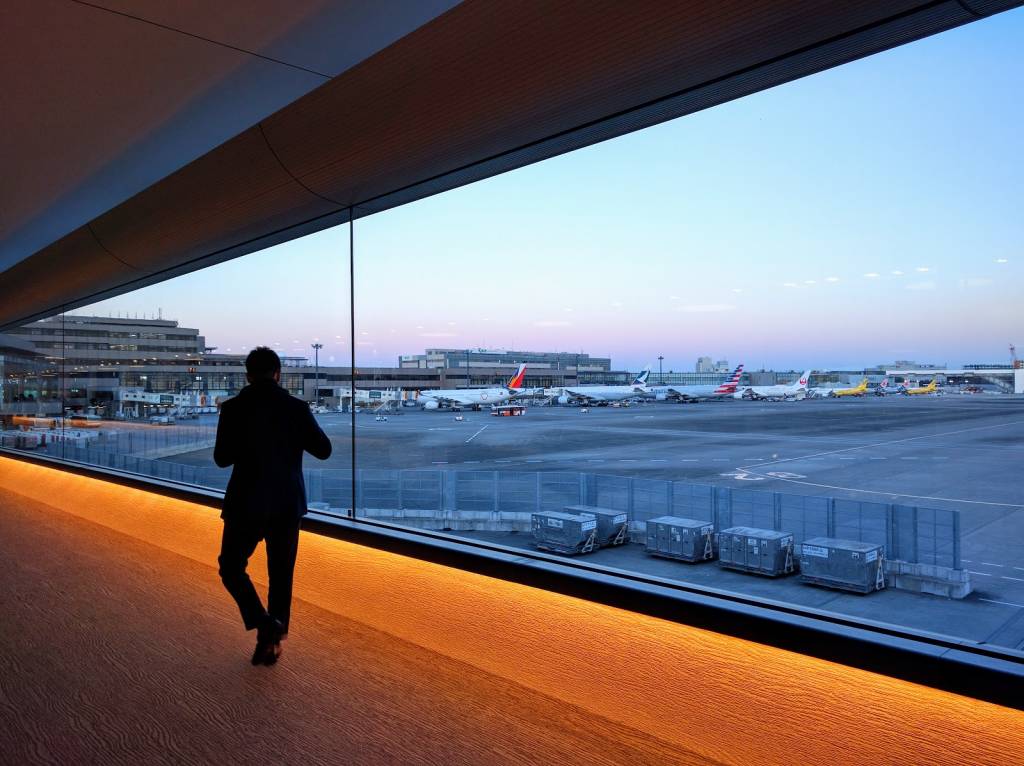
Finding the Best Transport From Narita Airport to Tokyo
How to get from the plane to your accommodation.

New Video: Top Japanese Phrases You Need Before Traveling to Japan

5 Stunning Spring Bus Tours From Tokyo
Take a ride to experience the best of the season.

Top 25 Easy Day Trips From Tokyo
Add a few of these to the wander list.

Tokyo to Osaka: Fast and Creative Ways of Getting There
Full guide to taking the bullet train, buses, and low-cost flights.

New Video! Suica Card in 2024: How and Where to Buy
We cover where and how to purchase Suica cards, digital Suica, Welcome Suica, and Pasmo Passport.

Close without accepting

Tokyo Localized News
> news > article.
- Mar 2, 2020
Kyoto Day Trip From Tokyo: What to Do in Kyoto, Japan
Updated: Feb 6, 2023

So you want to do a Kyoto day trip from Tokyo but overwhelmed what to do and how to go about it. We’ve got your covered.
“How far is Kyoto from Tokyo?” you might ask. Kyoto is 457 kilometers away from Tokyo. Kyoto is quite far, can you do a day trip from Tokyo? Absolutely!
From Tokyo to Kyoto, the best mode of transportation is through the shinkansen or bullet train. The Nozomi line takes approximately 3 hours one way and costs about 13,000 yen one way per person.

Here are a couple of things you can do for your Kyoto day trip from Tokyo:
1. Visit Temples and Shrines

Kyoto is one of Japan’s main religious centers with over 1,600 temples and shrines. If you are looking to explore the city on a deeper level, we highly recommend visiting some of the most popular temples in Kyoto to feed both your soul and wanderlust. Some worth adding to your Kyoto itinerary is Kiyomizudera, Kinkakuji (Golden Pavilion), Ginkakuji (Silver Pavilion), and Fushimi Inari Shrine.
2. Explore Gion

Kyoto is also home to many geisha (female professional entertainers) and maiko (apprentice geisha) so it pays to get a glimpse of these iconic Japanese beauties. The best place to spot geishas is Gion. It’s the geisha district of Kyoto, after all. Since Gion is also the entertainment capital of the city, you can find ryotei (“luxurious traditional restaurants”) and izakaya (“traditional pubs”). Some must-visit tourist spots in Gion are Yasaka Shrine, Yasaka Pagoda, Gion Shirakawa, and Shinbashi Dori.
3. Visit Top Tourist Attractions in Kyoto

Don’t mind crowds? There are quite many things to do in Kyoto that you should not miss. View Kyoto City at night from Kyoto Tower; feed snow monkeys at Monkey Park Iwatayama; enjoy soundscape at Arashiyama Bamboo Grove; shop foreign and local goods at Aeon Mall, Porta Mall, Yokai Street, Shijo Dori, and Kawaramachi Dori. Want a cultural experience? Join a tea ceremony or watch geisha performances. Is Kyoto worth a day trip? Yes! There’s literally at least one worthwhile thing to do in Kyoto for every type of traveler.
4. Embark on Food Adventure

Your Kyoto day trip from Tokyo won’t be complete without tasting local delicacies. Go on a food and drink binge on Pontocho Alley and Kayamachi Dori. Nishiki Market also can’t be any more perfect to find a wide variety of gastronomic delights in one place. If you don’t know which foods to find at the market , you should definitely look for tako tamago, takoyaki, and fugu. Looking for the best places to eat in Kyoto? Check out this Kyoto food guide .
5. Join Free Walking Tours in Kyoto

Pressed for time? No worries. Maximize your Kyoto day trip from Tokyo by joining free walking tour Kyoto . Kyoto Localized can take you to some of the most relevant spots in the city within a day, so you don’t leave Japan with regrets. Part of your Kyoto itinerary will be Yasaka Pagoda, Gion Shirakawa, Maruyama Park, Chionin Sanmon, Kiyomizu Temple, and Sannei Zaka.
Tokyo Localized provides visitors and travelers to Tokyo with a unique perspective of this great city, what makes us unique is that our walking tour guides live and work in Tokyo, have a passion for this city and love meeting and welcoming new faces. Find out more about our Unique Day and Night Tours of Tokyo - we can't wait to meet you!
A great experience for: Day Tours in Tokyo, Night Tours in Tokyo, Group Tours in Tokyo, Private Walking Tours, University Walking Tours, Things To Do at Night in Tokyo, Activities in Tokyo, Tokyo Sightseeing Tour, Tokyo Tourist Attractions.
- Food & Drink
Recent Posts
Toyosu Sushi Guide: Where to Eat Sushi at Toyosu Fish Market in Tokyo
Ginza Food Guide: Where and What to Eat in Ginza, Tokyo
5 Best Halal Restaurants in Tokyo
Commentaires
1 Day Kyoto Itinerary, Japan (2024 GUIDE)
This 1 Day Kyoto Itinerary is the perfect guide for first-timers visiting the cultural capital of Japan.
From ancient temples and shrines to shopping streets and nourishing restaurants, there is something for everyone to enjoy.
There are so many things to do in Kyoto that you could quite literally spend weeks exploring this magnificent city.
But don’t worry – if you only have a short time frame to visit, seeing the top Kyoto attractions in one day is totally possible.
In this 1-day itinerary for Kyoto, I have included a complete list of the top places to see as well as some useful information on how to get around, where to stay in Kyoto, and a map of the city.
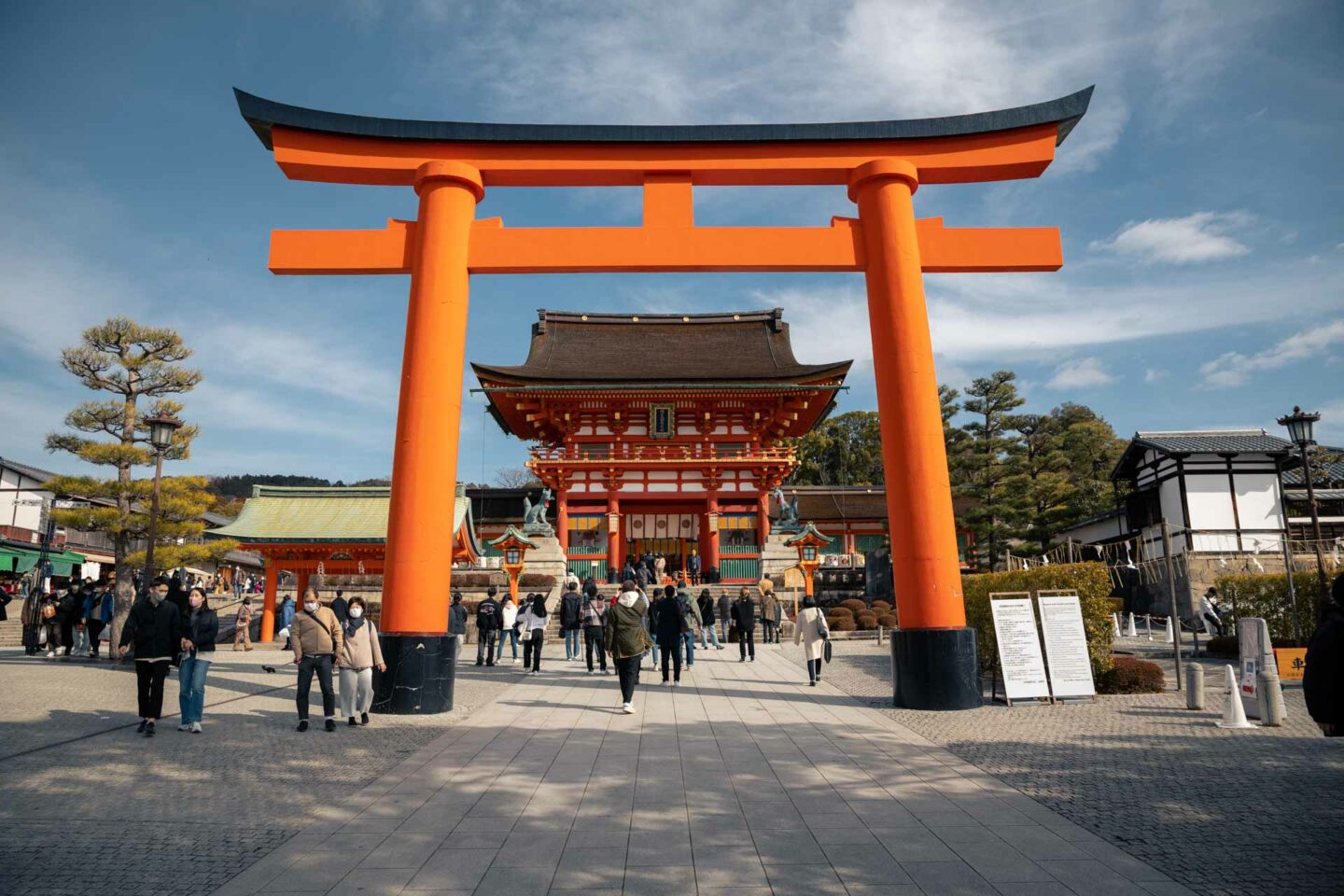
Table of Contents
1 DAY KYOTO ITINERARY OVERVIEW
To get the most out of your Kyoto 1 Day Itinerary, see below for a list of must-see attractions that I have included in this post:
- Kinkaku-ji Temple
- Ryoan-ji Temple
- Arashiyama Bamboo Forest
- Fushimi Inari (Tori Gates)
- Maiko Theatre (Geisha Girl Performance)
- Kiyomizu-dera Temple
KINKAKU-JI TEMPLE
For the first stop on your 1 day Kyoto itinerary, I highly suggest paying a visit to Kinkaku-ji Temple in Kyoto’s northwest, where you’ll find the famous Golden Pavilion, located on a small lake in the middle of a serene garden.
The building dates back to 1397, and was once the holiday retreat villa for a prominent Japanese Shogun!
You can expect to spend about an hour exploring the temple and its surrounding gardens.
To reach Kinkaku-ji Temple on your Kyoto day trip itinerary, you can take the Kyoto City Bus 205 from Kyoto Station to Kinkakuji-michi bus stop, or Kyoto City Bus 59 from Sanjo-Keihan to the Kinkakuji-mae stop, or taxi directly to Kinkaku-ji Temple.
→ Click here for the pin location on Google Maps
ENTRANCE FEE & OPENING HOURS:
The entrance fee to visit Kinkakuji Temple is 400¥.
Opening hours are Monday to Sunday from 9 am – 5 pm.
Have you got travel insurance for your trip?!
We all know accidents can happen and having Heymondo Insurance will save you thousands of dollars if something goes wrong.
Heymondo offers low-cost Travel Insurance to keep you covered on all your adventures.
RYOAN-JI TEMPLE
Ryoan-ji Temple is the site of Japan’s most famous rock garden, attracting hundreds of visitors every day.
Meditating with the view of this immaculately well-kept Cultural World Heritage site is the next best place to visit on your 1 day Kyoto itinerary!
From Kinkaku-ji Temple, it’s a 20-minute walk or a 5-minute bus ride to reach Ryoan-ji Temple.
The entrance fee to enter Ryoanji Temple is 500¥.
Opening hours are Monday to Sunday from 8 am – 5 pm – Plenty of time to visit on a day in Kyoto.
ARASHIYAMA BAMBOO FOREST
Next up on this itinerary is the world-famous Arashiyama Bamboo Forest. A trip to Kyoto wouldn’t be complete without having visited Arashiyama!
Kyoto’s bamboo forest is one of the most photographed attractions in the city and experiencing it through your own eyes is even better than any picture you would have seen of this place!
There is one main path leading through the Kyoto bamboo grove and when you enter the parallel tunnel of bamboo trees, you’ll feel like you’ve just entered another realm.
You will also notice the temperature drop when you are wandering through Arashiyama Bamboo Grove as the canopy above almost completely cuts out the sun.
The nature that surrounds Arashiyama is absolutely breathtaking and chances are you’ll spot a few monkeys in the area too, so keep your eye peeled.
A personal recommendation – make sure to come just after sunrise as photos will look even more stunning and you’ll avoid the group tours.
Talking about group tours, in case you don’t feel comfortable visiting by yourself, I recommend taking this early bird tour to Arashiyama Bamboo Grove . Many people prepare their 1 day Kyoto itinerary from Osaka only for that!
BEST TOUR IN KYOTO
A must-do when visiting Kyoto is joining a Kyoto Early Bird Tour !
It includes a professional guide, a tour of the Bamboo Forest and other spots, and the Kinkakuji Temple!
The Bamboo Forest in Kyoto is located in Arashiyama, northwest of the city center.
Find your way to Saga Arashiyama Station on the JR Sagano line using the JR Pass and it’s a short 10-minute walk from here.
The Arashiyama Bamboo Forest entrance fee is FREE, which is another great reason to visit on your one day in Kyoto itinerary.
Opening hours are Monday to Sunday from 5:30 am – 11:30 pm, and that is so convenient if you plan a day trip to Kyoto from Osaka.
The BEST Backpack For Backpacking!
Less is more with the Atmos AG 50L , the newest arrival in the Osprey backpacking range!
From weekend explorations to month-long expeditions, this EPIC backpack is up to the task and will stand the test of time.
FUSHIMI INARI
Continue the adventure on your one day Kyoto itinerary by journeying through the world-famous Tori gates of Fushimi Inari.
This must-see shrine consists of a pathway lined with over 10,000 Tori gates that extends 4km up to the very top of Mount Inari.
It takes around two hours to walk to the very top and back down again, however, you can turn back at any time you want!
Along the pathway, you will also see many stone foxes, symbolizing the messenger of Inari – the god of rice… and business!
The Fushimi Inari Shrine is also known for its beautiful architecture and gardens, making it an ideal spot for photographers looking to capture some amazing shots and it’s a great idea for what to do in Kyoto in 1 day.
Take the JR Nara Line from Kyoto Railway Station using the JR Pass and ride it two stops to JR Inari Station.
The Fushimi Inari Shrine is FREE to enter and it’s open 24 hours a day, 7 days a week.
MAIKO THEATER
One of the most exclusive experiences to add to your Kyoto 1 day itinerary is meeting a traditional Geisha performer.
Geisha are highly skilled entertainers who appear at high-end dinners, private parties, and special events to add a special touch to the proceedings, and are rarely seen in public.
Many foreigners tend to run around the red light district areas to try to get a glimpse of a Geisha girl or pay large sums of money to have a private performance.
Luckily, for travelers on a budget, there are some cheap options to get a taste of what a Geisha show is like!
I personally recommend the Maiko Theatre. While training to become Geisha between the ages of 15 and 20, these girls are known as ‘Maiko’, and this theatre gives you the rare opportunity to get to see one of them close up!
Take the bus from Kyoto Station to Kawaramachi Gojo bus stop, then walk for 2 minutes, or 3 minutes walk east from Keihan Shimizu Gojo station (exit 4).
It is relatively inexpensive at 3300¥ for their basic show, including a special dance and Q&A session, and you can take as many photos of (and with) her as you like!
Opening hours are Monday to Sunday from 10 am – 7 pm.
The BEST Affordable Camera For Travel
If you’re on the hunt for a professional camera for traveling, check out the Canon G7 X Mark II .
This tiny camera fits in your pocket, captures high-quality photos and videos, and has Wi-Fi so you can instantly transfer to your phone!
KIYOMIZU-DERA
Next on this itinerary for Kyoto is a visit to the Kiyomizu-dera (Water) Temple.
The walk leading up to the temple is almost as exciting as the temple visit itself, with a multitude of traditional buildings, shops, and restaurants.
Kiyomizu-dera is built into the side of the mountain, and from the huge verandah, you can see spectacular views of the hillside and the entire city.
Below the Kiyomizu-dera temple, you can find the reason why people make pilgrimages here from around Japan and the world – the Otowa Waterfall, a must-see on a Kyoto 1 day itinerary.
The waters are divided into three streams, and visitors use long poles with cups attached to drink from the streams.
Each stream has a different meaning and benefit – long life and health, success in school/career, and love. However, you can only drink from one… so choose carefully!
Make your way to Kiyomizu-michi street and follow it uphill until you reach the popular Kiyomizu-dera (Water) Temple.
The Kiyomizu-dera Temple entrance fee is 300¥.
This Kyoto tourist spot is open daily from 6 am to 6 pm, and that’s plenty of time to include it with other spots what to see in Kyoto for the day.
Last but not least on this Kyoto day itinerary is Gion, a must-do when taking a Kyoto day trip from Osaka or Tokyo.
From Kiyomizu-dera, you can meander down the iconic Sannen-zaka alleyway, a historical, stone-paved street lined with many traditional Japanese buildings, shops, cafes, and inns.
Sannen-zaka is also surrounded by several famous landmarks such as Yasaka Shrine, Maruyama Park, Yasaka-no-to Pagoda, and Kodaiji Zen Temple.
Once you reach the bottom of the hill, you’ve basically arrived at Gion, home to various red-light districts where you might be lucky enough to spot a Geisha! My favorite is Hanamikoji Street.
I recommend timing your arrival here for around 5:30 pm, as this is when the Geishas start leaving their homes to go to work (…and avoid the paparazzi of foreigners while doing so!)
Be careful though, you can be fined for taking photos of them, as it is considered highly disrespectful.
Put the cameras down for this one, and enjoy the chance to see one in the moment!
RELATED ARTICLE → 7 DAY JAPAN ITINERARY
WHERE TO STAY IN KYOTO
There are thousands of accommodations to stay on a Kyoto 1 day trip, so I have narrowed it down to a few of the best places to stay to suit the needs of luxury travelers, budget backpackers, and everyone in between.
See the list of accommodations that I personally recommend for your Kyoto 1 day itinerary.
LUXURY: HOTEL GRANVIA KYOTO
MID RANGE: TUNE STAY KYOTO
BUDGET: PIECE HOSTEL SANJO
TRADITIONAL RYOKAN
If you’re looking for an authentic experience to add to your 1 day in Kyoto itinerary, I highly recommend staying at a traditional Ryokan (Japanese-style inn) during your stay.
My personal favorite is Kyoto Ryokan Kinoe which is conveniently located in central Kyoto just 5 minutes walk from Gion.
This cozy Ryokan offers spacious tatami mat rooms, 24-hour baths, and multi-course meals served for breakfast and dinner.
Staying here will make you feel like you’re a traveler back in Edo-era Japan, and it’s a great base for a Kyoto 1 day itinerary!
OTHER PLACES TO STAY IN KYOTO
Didn’t find the perfect accommodation to suit your needs above.
Use the interactive map below to search all the available hotels for your Kyoto day tour itinerary. Simply enter your dates of stay and hit the search button!
MORE THINGS TO DO IN KYOTO
If you have more than one day in Kyoto, be sure to check out my Kyoto travel guide which includes 25 AMAZING things to do in Kyoto!
Read More: Kyoto Travel Guide – 25 AMAZING Things To Do
Best day trips from kyoto.
The best day trips from Kyoto are to Nara and/or Osaka.
Nara was once the ancient capital of Japan and plays home to some of the country’s most important cultural places, including the world’s largest wooden structure.
Some of the best things to see in Nara on a day trip from Kyoto are the famous Todai-ji Temple which houses the world’s largest Daibutsu (bronze Buddha statue) and a visit to the Nara Deer Park where it’s said that when you bow to the deer, they will bow back!
Osaka is the 3rd largest city in Japan and is most popular for its modern architecture, historical castles, buzzing nightlife, and sensory-overload shopping malls.
The top attractions to visit in Osaka on a day trip from Kyoto are the Dotonbori and Shinsaibashi shopping malls, Osaka Castle, Amerika-mura (America Town), and Universal Studios Japan.
Even if you have limited time on your Kyoto one day itinerary, I highly recommend going to Osaka for the day or half day.
Alternatively, you can see the city first and then proceed from Osaka to Kyoto on your Japan holiday.
TRAVEL TIPS FOR KYOTO
For first-timers planning a one day trip to Kyoto, here are some useful travel tips to know before you go.
STAY AROUND CENTRAL KYOTO
While pretty much all areas of Kyoto are good to stay in, Central Kyoto is the most convenient. And since it’s near the main train station, you can even organize a day trip to Kyoto from Tokyo.
This puts you right at the center of all the main attractions in Kyoto, making it easier and less time-consuming to explore around.
From Kiyomizu-dera Temple and Fushimi Inari to Ginkaku-ji and Nijo Castle, most of the major landmarks are located within Central Kyoto, so there’s no need to walk for hours or take a taxi or a bike.
Staying centrally also allows for easy access to popular restaurants, shopping areas, and more, basically providing an optimal base for a few days.
Also, if you plan a Kyoto day trip from Tokyo, you can easily get around town and come back later or the day after to the train station.
VISIT THE KYOTO ATTRACTIONS EARLY
Kyoto receives 87 million tourists per year on average, so visiting the tourist spots in Kyoto early is a great way to avoid crowds and walk around peacefully.
The popular things to do in Kyoto and all the major attractions are packed with tourists, so it’s wise to go early in the morning when the lines are shorter.
Plus, you’ll benefit from cooler temperatures, which is a plus in the summertime.
COME IN APRIL FOR CHERRY BLOSSOM
To see the cherry blossoms in Kyoto, consider coming in early April when you can really experience the city in full bloom.
The cherry blossom starts in late March but the peak comes in April, and this is precisely where you can see the city as beautiful as ever.
DON’T TIP
When it comes to Japan, one thing to keep in mind is that tipping is seen as rude and, therefore, it’s better not to tip. In fact, it could even be seen as an insult by the locals.
Instead of tipping, show a sign of appreciation either verbally or with a bow to express gratitude for the service provided. This applies to restaurants and ryokans too.
GET TRAVEL INSURANCE
Getting travel insurance should be an essential consideration when traveling in Japan. Unfortunately, accidents can happen, and it’s always best to be prepared for the worst.
Additionally, make sure you commit only to reputable companies and read the fine print carefully!
I personally use Heymondo and am very happy with their policy, coverage, and customer service. Check them out here below when planning a day trip in Kyoto.
MOBILE DATA:
When you arrive in Kyoto Japan, you’re going to want to get online, and purchasing a sim card is very simple. You can do this at the airport on arrival at one of the retail stores.
Alternatively, I recommend purchasing an eSIM in advance with pre-loaded mobile data so you can get online as soon as you land and stay connected on your trip.
Forget plastic SIM Cards… Get an eSIM!
Say hello to eSIM – a virtual SIM card pre-loaded with mobile data so you can get online and stay connected around the world.
OneSimCard is the best eSIM for travel, with low-cost data packages available in 150+ countries.
Simply buy online, install it on your smartphone, and you’re good to go!
Click here or on the image below for an interactive map of Kyoto.
WHAT TO PACK FOR KYOTO
When planning a one day trip Kyoto, here is a list of items I highly recommend bringing with you:
Must-Have Travel Essentials
Hidden money wallet.
Keep your cash and other valuables safe with this anti-theft hidden money wallet!
Reusable Water Bottle
The GRAYL GeoPress is the best reusable bottle that allows you to purify water from anywhere!
Travel Backpack
The Nomatic Travel Backpack has 20+ innovative features, perfect for everyday use!
Quick-Dry Travel Towel
The most compact, lightweight, and quick-dry towel for traveling!
Portable PowerBank
Keep your phone, laptop, and accessories charged while you’re on the go with the Anker PowerBank!
GENERAL TIPS FOR JAPAN
Most Japanese people can speak English, so if you are ever lost or need help with something you will be able to converse in English.
Also, all the signs at the airports, train stations, shopping malls, etc. are written in both Japanese and English.
The currency in Japan is Yen (¥) and the exchange rate is approximately $1 USD = 130 ¥.
There are plenty of ATMs in Japan located in the majority of convenience stores, in front of banks, inside hotels, etc. where you can easily withdraw cash to have with you during your trip.
HOW TO GET AROUND JAPAN
The easiest and most convenient way to discover Japan is with a Japan Rail Pass that is valid for use on the vast majority of railways and local buses operated by JR (Japan Rail) throughout the country.
Choose between an Ordinary Pass, or choose the Green Class Pass if you’re looking to travel in more comfort with reclining seats, a footrest, extra leg space, and a travel magazine.
The JR Pass includes the Shinkansen (bullet train), Limited Express, Local Trains, Monorail, JR Buses, and the Miyajima Ferry.
You could even take a Kyoto 1 day itinerary from Osaka if you’re planning to visit both.
The Japan Rail Pass is definitely the best ticket to have when planning your Japan itinerary, and you can then take the Tokyo to Kyoto bullet train!
Travel Japan with the JR Pass!
Get a 7-day, 14-day, or 21-day JR Pass for your trip to Japan and enjoy unlimited travel on trains and buses!
The JR Pass is valid on the Shinkansen (bullet train), Limited Express, Local Trains, Monorail, and JR Buses.
BEST TIME TO VISIT JAPAN
The best time to visit Japan depends on what you plan to do.
I personally prefer the spring and summer months in Japan (April – September) when temperatures are warm and the landscapes are vividly green.
However, visiting Japan in winter (December – March) is absolutely magical because the landscapes are completely covered in glistening white snow.
Visiting Japan in winter also means you have to opportunity to go skiing and snowboarding in Japan’s alpine regions .
VISA FOR JAPAN
Japan is visa-free for travelers from over 65 countries and you can stay in Japan for up to 90 days on a tourist visa.
Click Here to see the full list of nationalities that are eligible for the free 90-day tourist visa.
You don’t need to apply online for this as you will be granted a 90-day tourist visa at the airport when you arrive.
More Japan Travel Guides
Click the button below to view all articles related to Japan!
FINAL THOUGHTS – KYOTO ITINERARY
After 7 eventful days exploring Japan, my short one day itinerary Kyoto by far exceeded my expectations!
With many fun activities to do and attractions to see, Kyoto is well worth adding to your Japan Itinerary . I guarantee you won’t regret taking a Kyoto one day trip!
If you have any questions at all about this 1 Day in Kyoto Itinerary , please leave me a comment below and I will get back to you as soon as I can.
For a quicker response, be sure to join Jonny Melon’s Travel Tribe on Facebook and post your questions or recommendations to our awesome community.
TRAVEL RESOURCES FOR YOUR NEXT TRIP
Whether you’re a seasoned traveler or it’s your first trip overseas, here are some useful travel resources to help you kick-start your next adventure!
Search and book accommodation worldwide.
Compare and book cheap flights to anywhere.
Find tickets, tours, and experiences around the world.
Book buses, trains, and transfers online in advance.
Search all rental cars in your next destination.
Need travel insurance for your next trip?
THANKS FOR READING
Hey friend, thanks for reading this guide!
Please know this post may contain affiliate links. When making a purchase through one of my links, I earn a small kickback at no extra cost to you and it’s a big help to keep the site up and running. Rest assured, I only promote products and services that I personally use and recommend.
Click here to find out how you can support the site organically .
Many thanks!
PIN IT FOR LATER
Leave a comment Cancel reply
Notify me of follow-up comments via e-mail.
Work with us
Support the site
Plan Your Trip
Travel guides
Destinations
Hotel guides
Find best tours
Travel Gear
Travel resources
How to start a blog
Photography guides
Follow On Socials
© 2024 Jonny Melon Adventure Travel Blog. All rights reserved.
Privacy Policy | Terms | Sitemap
- Travel magazine
Day trips from Tokyo to Kyoto: The best of both worlds
(0 - 12 years old)
Book a private experience
November 7, 2023
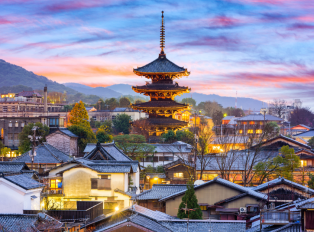
Hey, I'm Noriko! I've lived in Tokyo for over ten years, and guiding folks throughout the city has been quite the ride. While Tokyo tours are all the rage, sometimes I just need a change of pace, and Kyoto is my go-to escape Tokyo's all bright lights and buzzing streets, but Kyoto? It's like stepping into the serenity of old Japan. In this piece, I'll share my complete guide to spots in Kyoto I can't get enough of and think you'll love on a day trip from Tokyo.
Tokyo's modernity and Kyoto's tradition
Essential details for the journey, immersing in kyoto’s spiritual landscape, a day amidst geisha and maiko, modern attractions and escapades.
- Kyoto's culinary delights in a day
- Tips for a self-guided Kyoto day trip

Opting for guided tours
More tokyo day trips.
- The everlasting appeal of Kyoto
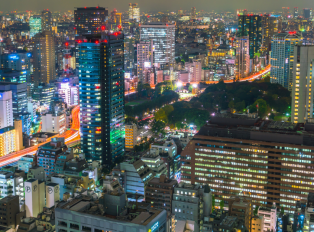
Since living in Tokyo, I've been swept up in its fast-paced rhythm and dazzled by its bright city lights. Tokyo is a buzzing metropolis filled with the latest gadgets and fashion trends. It's like stepping into the future.
On the flip side, there's Kyoto. Every visit to Kyoto feels like a journey back into the past. Cobbled streets, traditional tea houses, and iconic temples and shrines make it a place where history feels alive.
The difference between Tokyo and Kyoto goes beyond their locations; it contrasts modernity and tradition, technology and history. Tokyo symbolizes Japan's relentless pursuit of progress, while Kyoto is a peaceful haven where the past is revered and celebrated.
These two cities create a unique combination that reflects Japan's fascinating duality, where the vibrant present coexists harmoniously with a deeply entrenched history, and visiting both places is an enriching and unforgettable experience.
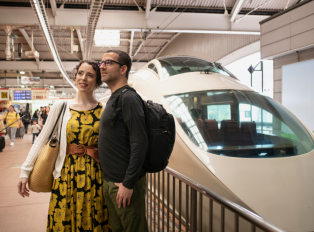
The Shinkansen, or bullet train, is a renowned engineering marvel that perfectly combines tradition and innovation, making it a symbol of Japan's post-war renaissance. Since its introduction in the 1960s, it has gained a reputation for its remarkable speed and efficiency.
For tourists planning a Kyoto day trip from Tokyo, the Shinkansen bullet train from Tokyo Station is the ideal transportation choice. With its convenient connections and quick travel time, it offers the easiest and fastest way to zip between the two cities. This makes it a popular mode of transportation for tourists.
So, let's talk travel specifics. From Tokyo Station, you're looking at a travel time of roughly 2 to 2.5 hours to Kyoto Station. The costs can vary, but a standard one-way trip usually sets travelers back around $100 to $120 during the off-season. However, if you're planning multiple sightseeing tours around Japan, I highly recommend looking into rail passes to get the most bang for your yen!
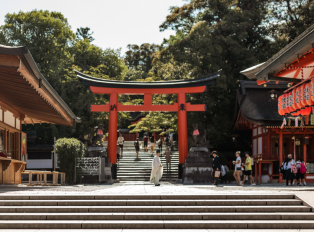
Kyoto is a haven for those looking to connect with the country's ancient traditions. Start your morning with an early visit to Kinkaku-ji, the Golden Pavilion, and witness its shimmering reflection in the tranquil pond.
As you explore, visit the iconic Fushimi Inari Shrine, famed for its thousands of red torii gates. As the day unfolds, delve deeper into the history of the city, from the stone-carved wishes at Kiyomizudera Temple to the mesmerizing rituals at Yasaka Shrine.
If you only have a one-day trip from Tokyo, begin your Kyoto experience by participating in or watching a serene temple ritual.
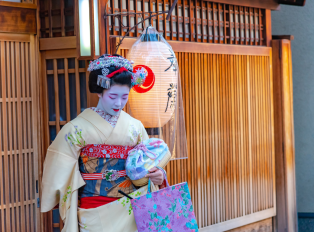
Gion stands out in Kyoto, not as just another location but as the epicenter of a rich geisha culture. For someone well-acquainted with Kyoto like me, its narrow streets serve as a constant reminder of a bygone era.
When strolling through Gion, especially in the late afternoon, you'll come across the essence of this district: distinct neighborhoods and cozy tea houses, each brimming with stories. And if you're planning a Kyoto day trip, especially arriving from Tokyo, don't spend an evening in Gion. Secure a spot for a traditional geisha performance. I promise witnessing the elegance and grace of geisha and maiko as they dance will truly enhance your Kyoto experience.

You know, Kyoto isn't just about ancient temples and traditional tea houses. Recently, I've been drawn to its evolving modern side.
Kiyamachi district is one spot I think you'd appreciate; it's this vibrant blend of trendy boutiques and eateries offering a fresh take on today's Japan.
And if you're up for some fun, Toei Kyoto Studio Park is where it's at. It's more than just a theme park—it offers a behind-the-scenes peek into Japanese films and TV shows.
If you plan a day trip from Tokyo, squeezing into these places will give you a taste of Kyoto's dynamic contrast. Trust me; it's a side of Kyoto many overlook, but it is worth the detour.
Kyoto's culinary delights in a day trip
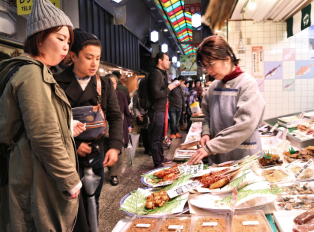
Kick off your Kyoto day trip with a traditional breakfast. You'll often find locals enjoying 'okayu,' a comforting rice porridge complemented with pickles and grilled fish. I love how it sets the tone for the day ahead.
Come midday - make your way to Nishiki Market. It's a hub of activity where vendors offer a variety of foods, from fresh sushi to matcha sweets. I've spent countless afternoons sampling food here.
If you're staying for dinner, consider a night trying a 'kaiseki' restaurant. This multi-course meal emphasizes seasonal ingredients and is a culinary experience unique to Kyoto. It's one of my top recommendations for anyone visiting the city.
Tips for a self - guided Kyoto day trip
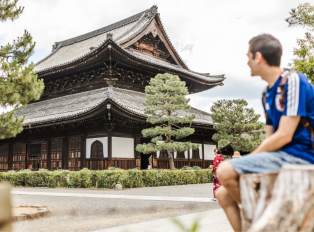
When planning a self-guided tour of Kyoto from Tokyo, here are some practical tips to ensure a smooth and enjoyable experience:
- Use Kyoto's efficient bus network : Kyoto's buses are your best friends for getting around the city. They are easy to navigate and offer convenient access to temples and shrines. Consider purchasing a Kyoto City Bus Pass for unlimited rides during your stay.
- Plan your Kyoto itinerary : Kyoto has a wealth of attractions, and planning your day is crucial. Prioritize the temples, shrines, and sights you want to visit to make the most of your time. A little research in advance goes a long way.
- Japan Official Travel App : The "Japan Official Travel App" is a fantastic tool. It provides real-time updates on train and bus schedules, helping you stay on track and avoid unnecessary waiting times.
- Start early : To beat the crowds and make the most of your Kyoto day trip from Tokyo, start your self-guided tour early in the morning. Many popular attractions can get crowded later in the day.
- Cash and coins : While Japan is modern, some smaller temples and shops may only accept cash. Be sure to have some yen on hand. It's also a good idea to carry coins for bus fares.
- Respect the temples : When visiting temples and shrines, remember the rules and customs. Dress modestly and follow any posted guidelines. Many places also require you to remove your shoes before entering.
- Local cuisine : Don't miss the opportunity to savor Kyoto's regional cuisine, such as matcha tea, yudofu (tofu hot pot), and kaiseki (multi-course meal). Exploring the culinary side of Kyoto is a delightful part of the experience.
- Souvenir shopping : Kyoto is known for its traditional crafts and souvenirs. Keep some time in your schedule for shopping, but be cautious about over-packing.
By keeping these tips in mind, your self-guided tour of Kyoto will be not only efficient but also filled with rich experiences and memorable moments.
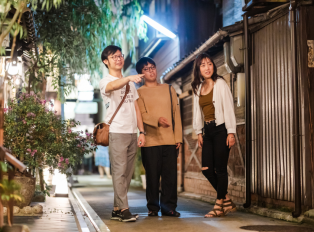
Having a guide can make all the difference in immersing oneself in Kyoto's wonders. Guiding Tokyo tours has shown me how diverse each visitor's interests can be. There's something special about curated itineraries tailored to individual tastes.
While I always love taking friends on personalized private tours through City Unscripted, there are several other fantastic guided tour options in Kyoto. Whether it's temples, shrines, or the hidden nooks of the city, a private guided tour can genuinely enrich your Kyoto experience, offering insights you might miss otherwise.
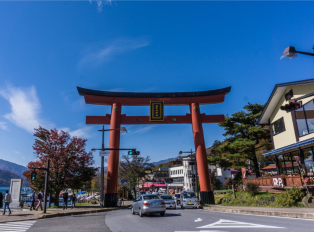
Kyoto is undeniably magical, but if you're basing yourself in Tokyo and itching for more exploration, there's a treasure trove of nearby destinations awaiting.
For those looking for short-day trips from Tokyo , one of my favorite getaways is Nikko, with its serene mountains and the ornate Toshogu Shrine.
Another must-visit is Hakone, where, on a clear day, the iconic Mount Fuji stands tall and majestic. A day trip to either spot promises breathtaking sights, and if you're a fan of the outdoors, the walking trails are something I highly recommend.
Japan is much more than its famous cities; sometimes, the lesser-known locales leave the most indelible impressions and there are many destinations to explore that are easy to reach from Shinjuku station or Tokyo station.
The everlasting appeal of Kyoto day trip
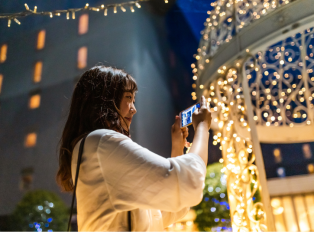
Looking back on our Kyoto adventure, I'm reminded of the countless layers this city offers. From its historic temples to its lively streets, there's always something new to discover.
It's hands-down one of the best day trips you can take in Japan as long as you remember to arrive in Kyoto early!
As you settle into your train seat at night, consider where your next day trip might lead, perhaps to visit Kyoto once more. There's so much more to see and experience in this enchanting city. But for now, rest up and savor the memories of your tour.
Hello, curious traveler! Embark on a unique experience with Hello, curious traveler! Embark on a unique experience with City Unscripted Tokyo. Our personalized, private tours, led by local hosts, make you feel like you’re exploring the city with a knowledgeable friend. We’ll take you to well-known sights and reveal Tokyo’s hidden gems, unveiling stories typically missed by traditional tours. So unscript your journey, and see Tokyo through the eyes of our local hosts!

Top private experiences in Tokyo
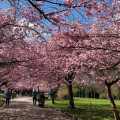
Tokyo in pink: discover the magic of the cherry blossom season

Your perfect half-day in Tokyo

Eat like a true Tokyoite

Epic Tokyo: A full-day tailored exploration

Get a head start: Kickstart your trip to Tokyo

On a roll in Tokyo! The sushi experience
We’ll pair you with the perfect host
There is no better way to see a city than with a friend who lives there. This is why we carefully match guests with their perfect host based on interested, personality and type of experience so they can discover a city beyond the tourist trail.
Find your perfect host and experience using our nifty little tool
Make your inbox happy with our travel tips and inspiration as well as exclusive offers and first access to new services.
You may also like

The best day hikes from Tokyo: Discover Tokyo's natural charms

Where to find the Tokyo tourists won’t see

Where to find the real heart of Tokyo

The best Tokyo Experience: Where to see the hidden gems only locals know about
Drift through Tokyo’s iconic sights

Serene day trip from Tokyo
Explore our cities in japan.

Popular destinations

San Francisco

Mexico City

Read more Tokyo articles
Kyoto: Getting there and around
Getting to kyoto.
- ¥ around 14,000
- multiple trains per hour
Tokyo and Kyoto are connected with each other by the JR Tokaido Shinkansen . Nozomi trains require about 140 minutes to reach Kyoto from Tokyo, Hikari trains about 160 minutes and Kodama trains about four hours.
The regular one way fare from Tokyo to Kyoto is 13,320 yen for a non-reserved seat or around 14,000 yen for a reserved seat. The Japan Rail Pass is valid on Hikari and Kodama trains, but requires a supplement fee of 4,960 yen on Nozomi trains.
The Tokyo-Osaka Hokuriku Arch Pass is a rail pass that allows holders to travel between Tokyo and Kyoto via Kanazawa , using the Hokuriku Shinkansen . It is not the fastest way to travel between Tokyo and Kyoto, but it allows pass holders to visit the less-explored Hokuriku Region along the way. It costs 24,500 yen and is valid for seven consecutive days.
- ¥ 3,500 - 10,000
- multiple daytime and overnight connections per day
The one way trip from Tokyo to Kyoto by highway bus takes about 7-8 hours. There are daytime and overnight buses. Fierce competition on the Tokyo-Kyoto-Osaka route has produced a wide variety of comfort levels (from discount to super premium buses) and an abundance of low priced offers.
Typical one way fares for discount buses, such as Willer Express , start from around 3500 yen; while premium buses charge up to 10,000 yen. If used effectively, the Japan Bus Pass can reduce the cost for the bus trip to around 3000 yen. Online reservations can be made through Willer and Japan Bus Online .
- 2-3 transfers
- ¥ 9,000 - 23,000
- multiple flights per day
The closest airport to Kyoto is Osaka 's Itami Airport , about one hour by bus from central Kyoto ( more details ). Most flights connect Itami Airport with Tokyo 's Haneda Airport , with just a few serving Tokyo's Narita Airport . Flight duration is one hour. The regular one way fare is around 28,000 yen, but discount tickets are usually available for around 9,000 to 14,000 yen.
- ¥ around 10,000 (expressway tolls)
Driving between Tokyo and Kyoto via the Tomei and Meishin Expressways takes about five to six hours without breaks and traffic jams. The expressway toll is around 10,000 yen one way.
- 4 transfers
- ¥ 2,410 - 8,210
By local trains , the one way trip from Tokyo to Kyoto takes about nine hours and typically involves about four transfers of trains. The regular fare is a relatively expensive 8360 yen, however, with a Seishun 18 Kippu you could theoretically do the trip for as little as 2410 yen.
Above fees and schedules are subject to change. Be sure to check current yen exchange rates .
Getting around
Kyoto features a rectangular street system. Unlike the streets in other Japanese cities, most of central Kyoto's streets are named. The main streets running from east to west are numbered in ascending order from north to south, and are about 500 meters apart from each other, with several smaller streets in between. For example, Shijo means "4th Avenue" and Nijo means "2nd Avenue".
Kyoto's city center with the highest concentration of dining, shopping and entertainment opportunities, is located around the junction of Shijo-dori (4th Avenue) and Kawaramachi-dori (Kawaramachi Street). JR Kyoto Station is located south of the city center at the height of Hachijo-dori (8th Avenue).
The most prominent north-south street is Karasuma-dori (Karasuma Street), which runs from Kyoto Station via the city center to Kyoto Imperial Palace . Another north-south axis is Kamo River, about one kilometer east of Karasuma-dori.
Kyoto has a rather inadequately developed public transportation system for a city of its size, consisting of two subway lines, a dense bus network and several railway companies, whose lines are not always conveniently connected with each other. Taxis and bicycles can be worthwhile alternatives.
The recommended way to get around Kyoto by public transportation is to use an IC card , such as Icoca, which is accepted on virtually all trains and buses in the city. Alternatively, travelers intending to use buses or subways extensively, should consider one of the 1-day passes available. See the ticket section below for more details.
Below is a simplified map of the railway and subway lines of Kyoto:
Few of Kyoto 's tourist attractions are located close to subway or train stations. Instead, Kyoto has a dense bus network with direct bus lines from Kyoto Station and/or the city center around Shijo-dori and Kawaramachi-dori to most major sights.
Kyoto is served by multiple bus companies. For central Kyoto, the green Kyoto City Bus buses are most numerous and useful. The red buses by Kyoto Bus are second most prominent and tend to be convenient to access sights in more outlying areas of the city.
The tourist offices provide a useful English network map for the Kyoto City Buses, which makes it quite easy for foreign visitors to access tourist attractions by bus. Despite the good map and English displays and announcements, however, getting off at the correct bus stop can still be stressful, especially in crowded buses.
Since buses are small and operate surprisingly infrequently even on some major routes, buses to major tourist sights can often get crowded, especially on weekends and during holidays. In addition, much time can be lost when buses get stuck or only proceed slowly in the busy street traffic. Consequently, it is recommended to use subways and trains as much as possible, and use buses only for medium and short distances, for example, from the closest subway station to the destination.
Most buses are entered through the back door and left through the front door. The fare has to be paid when leaving the bus. Inside much of central Kyoto, there is a flat rate of 230 yen per ride. Outside the flat fare zone, the fare increases with the distance. Click here for more information on riding buses.
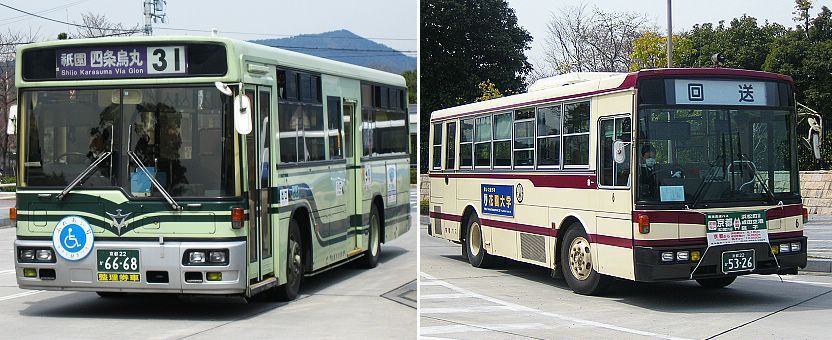
There are two subway lines in Kyoto , the Karasuma Line which runs from south to north along Karasuma-dori and stops at JR Kyoto Station, and the newer Tozai Line which runs from east to west and meets the Karasuma Line at the intersection of Karasuma-dori and Oike-dori.
Japan Railways
All JR lines, including the Tokaido Shinkansen , pass through or commence at JR Kyoto Station . JR trains can be a convenient for accessing the Arashiyama area (JR Sagano Line) and some attractions in southern Kyoto along the JR Nara Line, e.g. Fushimi Inari Shrine and Uji .
Other Railways
- Hankyu Railway connects Kyoto with Osaka . The line initially runs below Shijo Avenue from Kawaramachi westwards in direction of Osaka. It is a good option for accessing the area around Katsura Rikyu , from where a branch line also connects to Arashiyama .
- Keifuku Railway (also known as Randen) operates two tram-like train lines in northwestern Kyoto. For train lovers, a ride on these trains is a small attraction by itself. The lines can be an option for accessing Arashiyama and the area around Ryoanji and Kinkakuji .
- Keihan Railway 's main line runs next and parallel to Kamo River, but unfortunately does not connect to Kyoto Station . The line continues to Osaka and is an alternative to the JR Nara Line to access some of the attractions in southern Kyoto.
- Eizan Railway operates two train lines from where the Keihan Line ends, Demachiyanagi Station. One line leads to Kurama , while the other runs to the base of Hieizan .
- Kintetsu Railway connects Kyoto Station to Nara . Note that some trains on the Karasuma Subway Line continue to run on the Kintetsu Nara Line and the other way around.
By sightseeing bus
The Sky Hop Bus is an expensive but convenient way to visit Kyoto's most famous sightseeing spots. Double-decker buses with an open-air second floor run clockwise every hour from Kyoto Station in a large circle around the city, stopping near major tourist sites along the way, including Nijo Castle , Kinkakuji , the Imperial Palace , Heian Shrine and Kiyomizudera . A 12-hour pass costs 2500 yen and a 24-hour pass costs 3600 yen and can be purchased through Klook .
Kyoto is probably the Japanese city with the highest concentration of taxis . Especially in the city center, taxis are found everywhere. Taxis can not only be a more comfortable, but also an economical alternative to buses on short to medium distances for groups of three or more.
Most taxis accommodate up to four passengers (not including the driver), while larger vehicles are able to accommodate an additional fifth passenger. The rate starts around 610 yen for the first two kilometers and increases by 80 yen for every additional 300-400 meters traveled.
Kyoto City's simple layout and flat terrain make it easy and convenient to explore by bicycle . Numerous bicycle rental outlets can be found around the city, especially around major stations, such as Kyoto Station or in popular biking areas like Arashiyama . Typical rental prices are around 1000-1500 yen per day for basic bicycles and around 1700-2000 yen for electric assist bicycles. Some lodgings may provide their guests with bicycles for a small fee or for free.
Kyoto is generally a bicycle-friendly city with relatively easily navigable roads and a handful of cycling routes, most notably along Kamo River. Designated bicycle parking is often freely available around popular sightseeing spots. The situation is a little bit more challenging in the city center due to congested roads, crowded sidewalks and a lack of designated parking areas. Also, distances to some of the more outlying sightseeing spots should not be underestimated. For example, it is about eight kilometers (typically a 45-75 minute ride) from Kyoto Station to Kinkakuji or about ten kilometers to Arashiyama .
Passes and Tickets
See also our separate page about the various passes available for the Kansai Region .
The prepaid IC card available in Kyoto is called Icoca . It does not give you any discounts over regular tickets, but it makes the process of taking trains and buses easier, as you do not always need to buy a ticket for each ride. Icoca cards can be purchased through ticket machines at JR stations. Local non-JR railway companies offer their own IC card called Pitapa ; however, Pitapa is a postpaid card that works more like a credit card and is targeted at residents.
Icoca and Pitapa can be used on virtually all trains and buses in and around Kyoto (and most other major cities in Japan). Additionally, eight other IC cards from other major cities of Japan can also be used on the trains and buses of Greater Osaka and Kyoto, including Suica, Pasmo, Kitaca, Toica, Manaca, Sugoca, Nimoca and Hayakaken.
The Kansai One Pass is a special version of Icoca exclusively for foreign tourists that additionally qualifies for discounts at various attractions in the Kansai Region . It is available for sale at Kansai Airport and major railway stations in the Kansai Region.
Furthermore, the following one day passes are available for Kyoto :
- Kyoto Sightseeing Card (1100 yen) Unlimited use of Kyoto's two subway lines and most buses (including Kyoto City Buses, Kyoto Buses, JR buses and Keihan buses) in central Kyoto and outskirts, including Ohara and Daigoji on one calendar day. The pass also comes with discount coupons for selected sights in Kyoto. It can be purchased from ticket machines in subway stations, at bus ticket centers and from some hotels. The pass can pay off especially if you visit outlying areas such as Ohara . The downside is that, besides the subway lines, the pass does not cover any other trains which are often a convenient means of getting around.
- Kyoto Subway One Day Card (800 yen) Unlimited use of Kyoto's two subway lines on one calendar day. The card can be purchased from ticket machines at subway stations. It generally pays off if you use subways more than three times per day, however its value is restricted by the subway's limited coverage area.
Questions? Ask in our forum .
Links and Resources
Arukumachi kyoto route planner, kansai one pass, kyoto municipal transportation bureau, keihan railway, kintetsu railway, hankyu railway, kansai airport transportation, osaka airport transport, sky hop bus, enjoy cycling in kyoto, keifuku railway, eizan railway, hotels around kyoto.
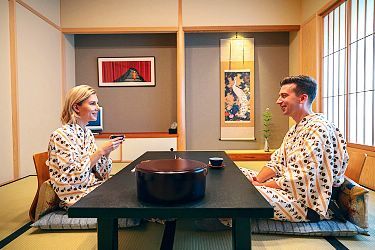
Experiences around Kyoto
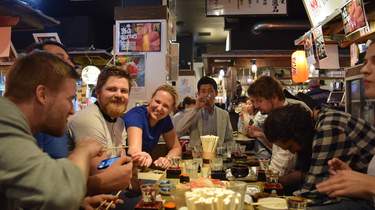
Inside Kyoto
A Kyoto Travel Guide
- 10 Day Japan Itinerary: Tokyo, Kyoto and Takayama
If you’ve got 10 days to spend and will be in Japan during the warmer months, then consider adding Takayama to the classic Tokyo-Kyoto itinerary. On the doorstep of the Japan Alps, Takayama is conveniently located between Tokyo and Kyoto.

Itinerary Summary
- Duration: Around 10 days.
- Perfect for: First time visitors to Japan who like mountains and who will be in Japan between late March and late October (when the snow has melted in Takayama and the weather is warm).
- Places visited: Tokyo, Takayama and Kyoto.
- Arrival City/Airport: Most people fly into Tokyo’s Narita or Haneda airports to do this itinerary. You can also fly via Kansai International Airport (KIX), which is the nearest international airport to Kyoto/Osaka.
- Best Season: Any time of year.
- Japan Rail Pass: A one-week Japan Rail Pass will save you a bit of money. For more details, see our Japan Rail Pass: Is It Worth It? page. Be sure to activate your pass on the day you leave Tokyo (not before).
Hire A Travel Expert To Plan Your Japan Itinerary

The Full Itinerary
Day 1: Arrive in Tokyo You’ll probably arrive at Narita International Airport (NRT), but some flights also go into the more convenient Haneda International Airport (HND). See our Tokyo Airport Transport page for details on getting into Tokyo from the airports.
Day 2: Tokyo: Modern Tokyo On your first full day in Tokyo, you’ll explore the modern west side of the city. See our full Tokyo Two-Day Itinerary for details.
Check Hotel Availability
Destination, check-in date, check-out date.

Day 3: Tokyo: Traditional Tokyo On your second full day in Tokyo, you’ll explore the traditional east side of the city. See our full Tokyo Two-Day Itinerary for details.
Day 4: Travel to Takayama Take the shinkansen from Tokyo to Nagoya and change to a Hida Wide View express train to Takayama. The total journey takes 4 hours, 20 minutes, and costs Y13,930. The Japan Rail Pass covers this leg. For details, see our Getting to Takayama page.

Day 5: Explore Takayama On this day, you’ll explore the Sanmachi Suji district, the heritage houses, the Takayama Festival Floats Exhibition Hall and Sakaurayama-Hachimangu Shrine. For details, see our Must-Do Takayama One-Day Itinerary . If you have more time to spare in this area, consider staying another day and taking a day trip or overnight trip to the mountain sanctuary of Kamikochi. For details, see the Attractions Around Takayama section of our Things to Do in Takayama page.
Day 6: Travel to Kyoto Take a Hida Wide View express back to Nagoya and take the shinkansen to Kyoto. The whole journey takes 4 hours, 20 minutes, and costs Y13,930. The Japan Rail Pass covers this leg. For details, see our Getting to Takayama page.
Day 7: Kyoto: Southern Higashiyama On your first full day in Kyoto, you’ll explore the temple-packed Southern Higashiyama area. See our full Kyoto Three-Day Itinerary for details.

Day 8: Kyoto: Arashiyama On your second full day in Kyoto, travel west to the Arashiyama district, which is home to the famous Arashiyama Bamboo Grove. See our full Kyoto Three-Day Itinerary for details.
Day 9: Return to Tokyo Take the shinkansen back to Tokyo. For details, see our How to Travel from Tokyo to Kyoto page. You’ll probably have some time in the afternoon to do some last-minute shopping or sightseeing. Note, if your flight out of Tokyo leaves after 3pm, you might be able to spend this night in Kyoto (see the note below).
Day 10: Leave Japan Return to Narita or Haneda airport and fly home. See our Tokyo Airport Transport page for transport details.
Important Note on Leaving Kyoto and Flying Out of Tokyo the Same Day
If your departure from Tokyo is after 3pm, you do not have to spend your last night in Tokyo; you can leave from Kyoto and still make your flight. As a rule, to travel from Kyoto to Narita takes around 4 hours, with transfers. The best way is to take a Hikari or Nozomi shinkansen to Shinagawa Station in Tokyo and transfer to the Narita Express there (if you change at Tokyo Station, you have to walk VERY far to reach the Narita Express platforms).
If you you’re flying out of Haneda Airport, allow about 3.5 hours travel time from Kyoto to Haneda. The best way is a Hikari or Nozomi shinkansen to Shinagawa Station in Tokyo and then the Keikyu Line to Haneda.
Japan Itineraries:
- Japan Itineraries Overview
- 1 Week Japan Itinerary: Tokyo and Kyoto
- 10 Day Japan Itinerary: Tokyo, Kyoto and Kanazawa
- 2 Week Japan Itinerary: The Grand Tour
- 7 to 10 Day Japan Itinerary: Kyoto, Osaka, Nara and Hiroshima
- Japan With Children Itinerary
Kyoto Vacation Checklist
- For all the essentials in a brief overview, see my First Time In Kyoto guide
- Check Kyoto accommodation availability on Booking.com and Agoda.com - often you can book with no upfront payment and free cancellation
- You can buy shinkansen (bullet train) tickets online from Klook - popular routes include Tokyo to Kyoto , Kyoto to Osaka and Kyoto to Tokyo
- Need tips on where to stay? See my one page guide Where To Stay In Kyoto
- See my comprehensive Packing List For Japan
- Buy a data-only SIM card online for collection when you arrive at Kansai International Airport (for Osaka and Kyoto) or Tokyo's Narita Airport . Or rent an unlimited data pocket wifi router
- Compare Japan flight prices and timings to find the best deals
- If you're making frequent train journeys during your visit, you might save money with Japan Rail Pass – see if it's worth it for you
- A prepaid Welcome Suica card makes travelling around Kyoto easy – here's how
- World Nomads offers simple and flexible travel insurance. Buy at home or while traveling and claim online from anywhere in the world
Kyoto District Map

- Central Kyoto
- Northwest Kyoto
- Northern Higashiyama
- Southern Higashiyama
- Downtown Kyoto
- Kyoto Station Area
- South East Kyoto
Disclosure: InsideKyoto.com is a participant in the Amazon Services LLC Associates Program, an affiliate advertising program designed to provide a means for sites to earn advertising fees by advertising and linking to amazon.com and amazon.co.uk. World Nomads provides travel insurance for travellers in over 100 countries. As an affiliate, we receive a fee when you get a quote from World Nomads using this link. We do not represent World Nomads. This is information only and not a recommendation to buy travel insurance.

- 2 Weeks for Couple
- 2 Weeks for Family
- Thailand Lantern Festival
- Indonesia(Bali)
- South Korea
- China (HK, Taiwan)
- Itinerary Ideas
- Asia Highlights Travel Reviews
- Thailand Travel Reviews
- Vietnam Travel Reviews
- Cambodia Travel Reviews
- Japan Travel Reviews
- Myanmar Travel Reviews
- China Travel Reviews

7-Day Japan Adventure: Tokyo and Kyoto Tour
Begin in Tokyo, a dynamic metropolis where modernity meets tradition. Delve into the bustling streets, immerse in diverse neighborhoods, and explore historic landmarks. Then, venture to Kyoto, a city steeped in ancient traditions, boasting stunning temples, serene gardens, and a profound cultural heritage. Witness the beauty of traditional geisha districts and experience the Zen ambiance. This thoughtfully curated itinerary offers the perfect blend of Japan's contemporary vibrancy in Tokyo and the serene, cultural richness of Kyoto, making it an ideal choice for travelers seeking a concise yet immersive experience of Japan's two iconic cities. Book now for an unforgettable Japanese journey.
We can customize this trip by adding anything you're interested in and scheduling days to fit your pace. We would happily organize a unique theme or activities for birthdays, young children, anniversaries, etc.
- Best For: Slow Pacers and Couples
- Departure date: Up to you
- Sample Price: On request
Discover real reviews of Highlights Travel Family 's best-rated service across trusted platforms.
Tour Highlights
Here are the fantastic attractions, the most must-do activities selected by Asia Highlights (AH Hand-Picked), and exclusive cultural experiences offered by Asia Highlights (Only With AH) included in this tour:
Learn about Japanese emperors by visiting the Imperial Palace and the Meiji Shrine.
Journey through both contemporary and historic epochs of japan to gather captivating tales of your own., understand japan more deeply by visiting kyoto's world heritage sites ., take a walk through arashiyama's famous bamboo groves and visit a great zen temple, tenryuji temple , one of kyoto's unesco world heritage sites., suggested itinerary for inspiration.
The itinerary serves as a mere example of a personalized tour, designed exclusively for you. Your preferences will shape the authentic journey. We are fully prepared to craft an tailor-made tour that fulfills your desires.
Your private guide will be ready to meet and greet you at the arrival hall in Tokyo. A comfortable private car with an experienced driver will transfer you directly to your hotel. Your guide will help you to check-in.
Meiji Jingu Shrine: Nestled amidst a serene forest, Meiji Jingu Shrine offers a peaceful escape in the heart of Tokyo. The shrine grounds provide scenic walking paths, perfect for a leisurely stroll. Here, you can partake in various Shinto rituals—making offerings at the main hall, purchasing charms and amulets, or writing wishes on ema tablets. Don't be surprised to catch a traditional wedding procession on Sunday mornings, a captivating sight with the bride in a white kimono and hood, accompanied by the groom in a formal black robe, under the guidance of Shinto priests.
Shibuya: A bustling epicenter for Tokyo's youthful energy, Shibuya is a must-visit spot for anyone exploring the city. With iconic attractions like the scramble crossing, this area is the epitome of trendy youth culture, promising an unforgettable experience for visitors.
Anime Cafe: No visit to Tokyo is complete without experiencing an anime-themed cafe! Even if you're not an avid fan, these cafes offer a unique and captivating experience that's hard to find anywhere else in the world. Don't miss the opportunity to enjoy this immersive and quirky atmosphere—be ready for fun and be sure to capture memorable moments through photos!
Harajuku: An eclectic fashion district surrounding Harajuku Station, this area is a hotbed of style nestled between Shibuya and Shinjuku. Takeshita Street, the area's focal point, hosts a blend of boutiques flaunting the latest trends and photo-worthy food. Wander through blocks showcasing diverse styles—from Harajuku goth to candy-colored decora kei and punk fashion. Indulge in a variety of snacks, including classic crepes, rainbow grilled cheese, giant cotton candy, and Korean hattogu. Stroll down Cat Street towards Shibuya, exploring hipster cafes, vintage fashion stores, and international brands.
Sensoji Asakusa: Explore Tokyo's oldest temple, Sensoji, home to a sacred statue of Kannon, the goddess of mercy. Wander through grand gates, a towering five-story pagoda, and Nakamise Dori's vibrant stalls. Discover the spiritual essence and bustling marketplace at this iconic destination, offering a glimpse into Tokyo's cultural heritage.
Tokyo Skytree: Towering over Tokyo's skyline, the Tokyo Skytree stands at an astounding 634 meters, granting breathtaking panoramic views of the city. On clear days, the vista includes glimpses of the majestic Mount Fuji, offering an unforgettable sight for visitors.
Tsukiji Fish Market: While the inner wholesale market has moved to Toyosu, the outer market of Tsukiji remains a lively area filled with diverse food stalls and shops. Known for its high-quality seafood, the market is a haven for fresh produce, seafood, and authentic Japanese delicacies. Explore the stalls and relish the opportunity to savor a variety of seafood delights, from sushi and sashimi to grilled fish and seafood bowls.
Sushi-making Experience with Lunch: Dive into the art of sushi, from the ocean to your plate, with a sushi-making class and an enlightening visit to the fish market. Embark on a guided tour of one of the world's largest seafood markets, learning about the process of catching, distributing, and selling fish. Under the guidance of a sushi master, delve into the art of preparing nigiri sushi. Cap off your adventure by relishing your freshly made creations during a delightful sushi lunch.
Tokyo to Kyoto Express by Nozomi Train (Standard Class Ticket, Duration: 2 hours 21 minutes): Experience a swift journey from Tokyo to Kyoto aboard the Nozomi Train. This ticket provides a comfortable, direct trip without transfer or guided services. Please note that prices do not include additional transfer or guiding services.
Nishiki Market in Kyoto is a renowned traditional food market known for its vast array of fresh, seasonal foods, and its unique and authentic atmosphere. This centuries-old market is a favorite among both locals and tourists. Visitors can enjoy a delightful variety of traditional Japanese foods and snacks, such as sushi, pickles, mochi, and matcha. Many vendors offer free samples, allowing visitors to savor different flavors and find their preferred treats.
Nijo Castle, a UNESCO World Heritage Site, is among the seven Historic Monuments of Ancient Kyoto. This expansive site includes two concentric rings of fortifications, the Ninomaru Palace, the ruins of the Honmaru Palace, and exquisitely designed gardens.
Kinkakuji, or the Golden Pavilion, is a Zen temple located in northern Kyoto, featuring its top two floors completely covered in gold leaf. Originally the shogun Ashikaga Yoshimitsu's retirement villa, the temple transformed into a Zen temple of the Rinzai sect following his passing in 1408. The striking structure overlooks a large pond and stands as the sole surviving building from Yoshimitsu's former complex, having faced destruction multiple times in history, notably during the Onin War and in 1950.
Fushimi Inari Shrine, situated on the outskirts of Kyoto, is a sacred religious site recognizable from the movie "Memoirs of a Geisha". The path lined with red-painted toriis (memorial arches) provides a picturesque setting, ideal for capturing memorable photos.
The Gion District is renowned for its association with the traditional geisha culture. Stroll through these charming streets and witness the captivating presence of geiko, referring to themselves as "women of art," adding an alluring touch to Kyoto's unique ambiance.
Nonomiya Shrine: Tucked within the enchanting bamboo forest of Arashiyama in Kyoto, the Nonomiya Shrine holds historical significance as a former sanctuary for princesses. Long ago, it served as a preparatory residence where unmarried princesses underwent purification before they embarked on their service as high priestesses at the esteemed Ise Shrine.
Bamboo Grove: The Arashiyama Bamboo Grove stands as an iconic and unforgettable attraction in Kyoto. Located in the Sagano village on the city's west side, this short yet immersive pathway through the bamboo forest leaves a lasting impression. The play of dappled light filtering through the dense forest adds a touch of magic to the experience.
Our guide will help you transfer from your hotel to Kyoto Airport for departure with independentcar/van and guide.
Our Service Includes:
- Private transfers and English-speaking tour guide
- All guided sightseeing as detailed in the itinerary
- Hand-picked star-rating accommodations
- Breakfasts at hotels and lunches for every guided day
- Governmental taxes
Tour code: ah-jp-cx-10
Inquire now! Your 1:1 travel consultant will reply within 1 working day.
How would you travel.
Adults number (age ≥ 18 years old)
Children number
10-17 yrs old
3-9 yrs old
0-2 yrs old
What's your hotel choice?
When would you travel.
I prefer to be contacted via:
Why Asia Highlights (10,000+ reviews & 98.8% 5-star rating)
- Save Your Time:
- Less research, more enjoyment!
- Real-time 1V1 expert planning
- Maximize Your Flexibility:
- Personal local guide and ride
- Explore at your own pace
- Celebrate Your Journeys:
- Specially-crafted family adventures
- Celebrate milestones with style!
- 10-Day Japan Cherry Blossom Spring 2025 Mini-Group Tour
- 2-Week Japan Private Family Vacation
- 12-Day Classic Japan Tour
- 9-Day Japan Highlights Tour
- Plan a Family Trip to Japan 2024/2025: Experiences and Itineraries
- Plan a Japan Cherry Blossom Trip 2024/2025, Dates and Avoid Crowds
- 12 Days in Japan: Top 4 Itineraries for First Visit 2024/2025
- 1 Week in Japan: Top 5 Itineraries for First Visit 2024/2025
- Japan Weather in January: Travel Tips for First-Timers
- Japan Weather in February 2024: Travel Tips for First-Timers
- Japan Weather in March 2024: Travel Tips for First-Timers
- Japan Weather in April 2024, Travel Tips (for First-Timers)
- Japan Weather in May 2024: Travel Tips for a First Visit
- Japan Weather in June 2024: Coolest Summer Month, Travel Tips for First Visit
- Japan Weather in July 2024: Full of Festivals, Travel Tips for First Visit
- Japan Weather in August 2024: Travel Tips for First Visit
- Japan Weather in September, Travel Tips (for First-Timers)
- Japan Weather in October 2024: Travel Tips for First-Timers
- Japan Weather in November 2024: Best Autumn Month, Travel Tips
- Japan Weather in December 2024: Travel Tips for First-Timers
Get Inspired with Some Popular Itineraries
At Asia Highlights, we create your kind of journey — your dates, your destinations, at your pace. You can have any trip tailor made for your travel.
More Travel Ideas and Inspiration
Sign up to our newsletter.
Be the first to receive exciting updates, exclusive promotions, and valuable travel tips from our team of experts.
Why Asia Highlights
Where can we take you today.
- Middle East
- African Safari
- Travel Agents
- Loyalty Program
- Our Differences
- Privacy Policy
Address: Building 6, Chuangyi Business Park, 70 Qilidian Road, Guilin, Guangxi, 541004, China
- Meetings & Events
- Select Language 简体中文 繁體中文(香港) 繁體中文(臺灣) India (English) Bahasa Indonesia 한국어 ภาษาไทย Tiếng Việt Singapore (English) Philippines (English) Malaysia (English) Australia/New Zealand (English) Français Deutsch Italiano Español United Kingdom (English) Nordic countries(English) Canada (English) Canada (Français) United States (English) Mexico (español) Português العربية Japan(日本語) Global (English)
- India (English)
- Bahasa Indonesia
- Singapore (English)
- Philippines (English)
- Malaysia (English)
- Australia/New Zealand (English)
- United Kingdom (English)
- Nordic countries(English)
- Canada (English)
- Canada (Français)
- United States (English)
- Mexico (español)
- Global (English)
- Fujiyoshida
- Shimonoseki
- Ishigaki Island
- Miyako Island
- Kerama Island
- Tokyo Island
- Koka & Shigaraki
- Hida Takayama
- Ginza, Nihonbashi
- Beppu & Yufuin (Onsen)
- Ginzan Onsen
- Nagasaki Islands

- Kumano Kodo
- Shikoku Karst
- Amami Oshima
- Hachimantai
- Omihachiman
- Aizuwakamatsu

- Diving in Japan
- Skiing in Japan
- Seasonal Flowers in Japan
- Sustainable Outdoors
- Off the Beaten Track in Japan
- Scenic Spots
- World Heritage
- Home Stays & Farm Stays

- Japanese Gardens
- Japanese Crafts
- Temple Stays
- Heritage Stays
- Festivals and Events
- Theater in Japan
- Japanese Tea Ceremony
- Cultural Experiences in Japan
- Culture in Japan

- Local Cuisine Eastern Japan
- Local Cuisine Western Japan
- Local Street Food
- Japan's Local Ekiben
- Japanese Whisky
- Vegetarian and Vegan Guide
- Sushi in Japan Guide
- Japanese Sake Breweries

- Art Museums
- Architecture
- Performing Arts
- Art Festivals
- Japanese Anime and Comics
- Japanese Ceramics
- Local Crafts

- Scenic Night Views
- Natural Wonders
- Theme Parks
- Samurai & Ninja
- Iconic Architecture

- Wellness Travel in Japan
- Japanese Ryokan Guide
- A Guide to Stargazing in Japan
- Relaxation in Japan
- Forest Bathing (Shinrin-yoku)

- Experiences in Japan
- Enjoy my Japan
- National Parks
- Japan's Local Treasures
- Japan Heritage
- Snow Like No Other

- Visa Information
- Getting to Japan
- Airport Access
- COVID-19: Practical Information for Traveling to Japan
- Anime Tourism
- Countryside Stays
- Accessible Tourism
- Hokkaido Great Outdoors
- Scenic World Heritage in Tohoku
- Shikoku’s Nature and Traditions
- Southern Kyushu by Rail

- Traveling by Rail
- How to Travel by Train and Bus
- JR Rail Passes
- Scenic Railways
- Renting a Car
- Sustainable Travel in Japan
- Travel Brochures
- Useful Apps
- Online Reservation Sites
- Eco-friendly Accommodation
- Luxury Accommodations
- Traveling With a Disability
- Hands-free Travel
- How to Book a Certified Tour Guide
- Volunteer Guides

- Japanese Manners
- Spring in Japan
- Summer in Japan
- Autumn in Japan
- Winter in Japan
- Cherry Blossom Forecast
- Autumn Leaves Forecast

- Japan Visitor Hotline
- Travel Insurance in Japan
- Japan Safe Travel Information
- Accessibility in Japan
- Vegetarian Guide
- Muslim Travelers
- Safety Tips

- Visa Info for Canadians
- Tour Operators in Canada
- Brochure Request
- Know Before You Go
- JR Pass Retailers
- Regional Rail Passes
- Rail Travel FAQ

- Inspiration
- Travellers' Blog
- Japan Through the Eyes of Canadian Journalists
- Signature Journeys by Canadian Celebrities

- MICE Newsletter
- Notice of Campaigns
- What's New

My Favorites
${v.desc | trunc(25)}
Planning a Trip to Japan?
Share your travel photos with us by hashtagging your images with #visitjapanjp
- 10 Best Day Trips from Tokyo
Explore more with this list of epic ideas of the best day trips from Tokyo!
Tokyo is one of the largest megacities in the world and you will never be bored with what it offers. It doesn’t stop there, though. There are many places which are easily accessible from Tokyo that a lot of travelers miss before moving to other popular destinations such as Kyoto or Osaka. Here are some ideas of day trips from Tokyo to add to your bucket list.
1. Kamakura
Once the political capital of Japan, Kamakura is home to beautiful temples and shrines, where locals enjoy spending their weekends. It’s also famous for one of the most bustling beaches in Japan.
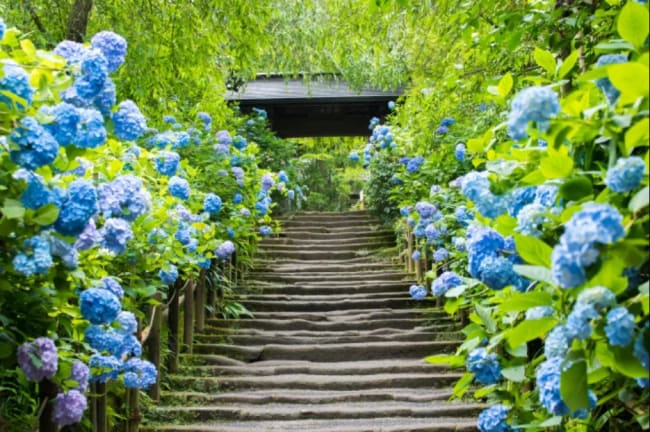
2. Yokohama
A magnificent port city with the second largest population in Japan. Find unique souvenirs at Yokohama Red Brick Warehouse and enjoy delicious cuisine at the biggest Chinatown in Japan.
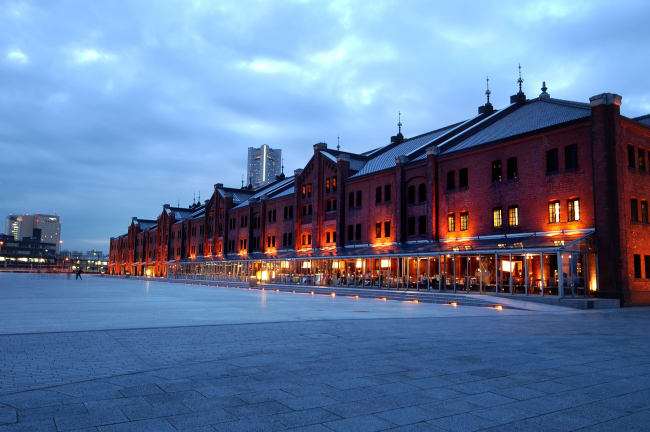
3. Hitachi Seaside Park
The beautiful blue nemophila flowers reach their peak bloom from mid-April to early May, although the park offers amazings view of flowers in its immaculately maintained gardens throughout the year.
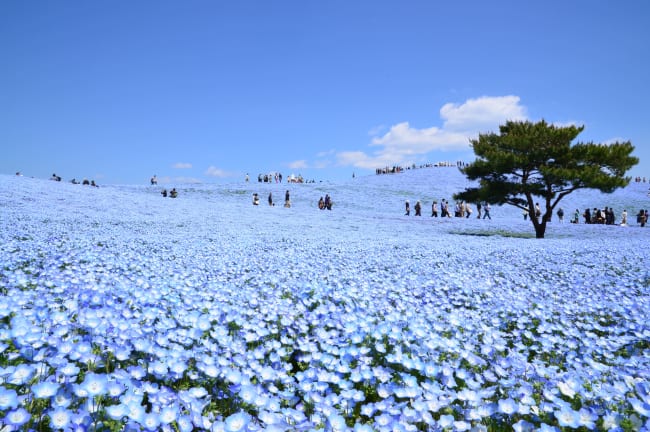
4. Arakurayama Sengen Park
If you want to take the perfect “iconic Japan” picture with Mt.Fuji, a beautiful pagoda, and cherry blossoms, visit this scenic park located near the Lake Kawaguchi in Yamanashi Prefecture.
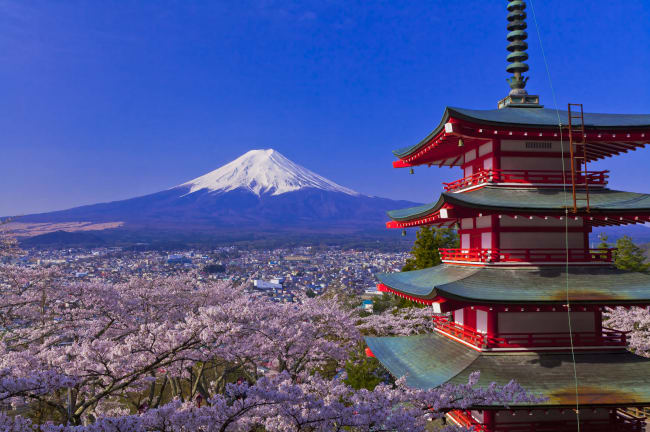
5. Chichibu
Just an hour and a half from Tokyo by train, Chichibu is a great day trip destination to immerse yourself in nature. Enjoy a boat ride in Nagatoro river, or the breathtaking fields of pink mountain phlox, known as shibazakura in Japan.
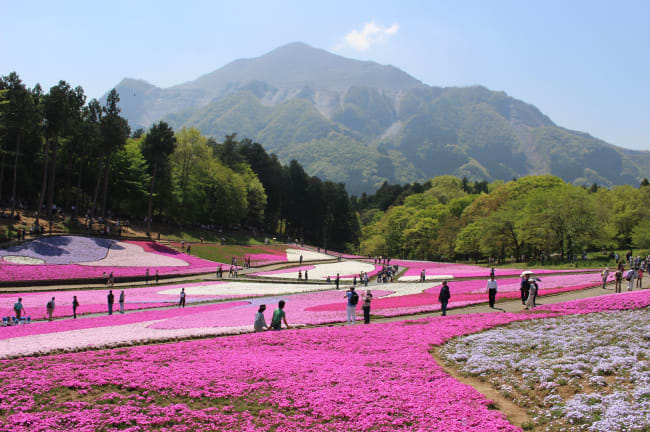
With its scenic mountain views and a plenty of onsen hotsprings, Hakone is one of the most popular day trip destinations for Tokyoites looking to avoid the hustle and bustle. It is also one of the best places to enjoy autumn foliage in Japan.
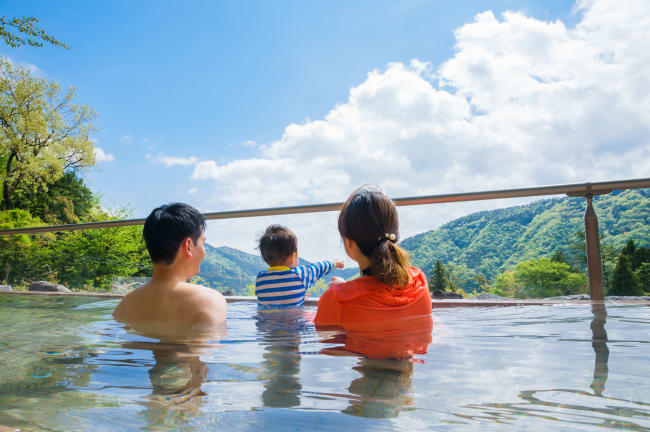
A beautiful small city in the mountains with several UNESCO World Heritage sites. The Nikko Toshogu Shrine is a must-visit if you have time for a day trip from Tokyo.
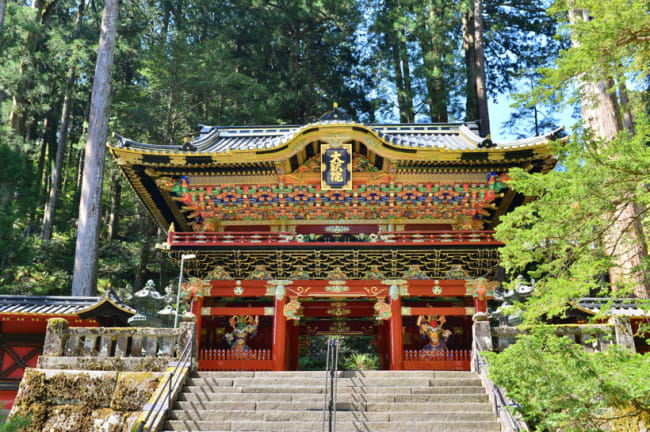
8. Fuji-Q Highland
Located at the foot of Mt. Fuji, Fuji-Q Highland offers a wide range of experiences from scream-inducing roller coasters, to gentle attractions for children.
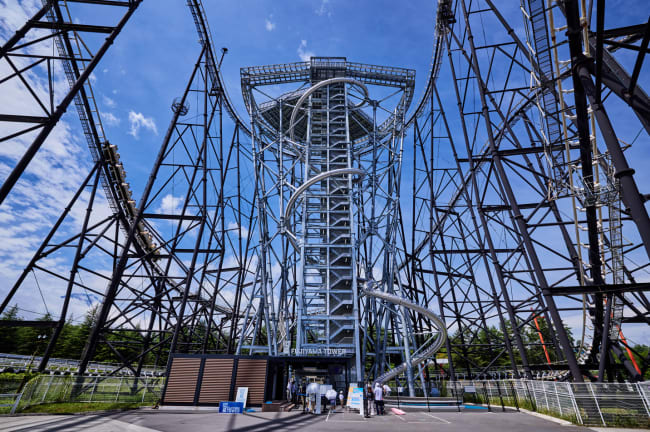
9. Mt. Nokogiri Hiking
If you are looking for a refreshing hiking experience near metropolitan Tokyo, Mt. Nokogiri could be a good option. Its easy access from Tokyo and the famous jagged cliff lookout point attracts many nature-seekers from neighbouring urban areas.
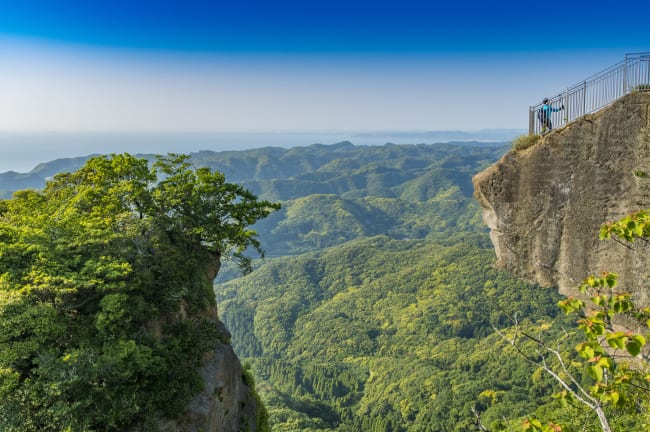
10. Kawagoe
Located less than an hour from Tokyo, here you are able to walk the streets of “Little Edo,” which are lined with historical buildings where you can enjoy great local foods and seasonal festivals.
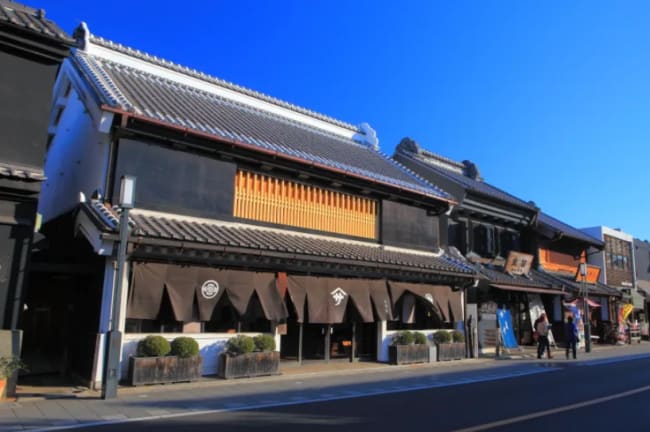
- Canada home
Please Choose Your Language
Browse the JNTO site in one of multiple languages
Truly Tokyo
A Tokyo Travel Guide
Best Day Trips From Tokyo
Take a day trip from Tokyo to check out superb temples and shrines in Nikko and Kamakura, gaze at the perfect cone of Mt Fuji, or even hop on the bullet train to Kyoto. Here, we introduce these famous and some not-so-famous day trip destinations from Tokyo.

Best Day Trips From Tokyo Overview
- Nikko is home to some of Japan's most colorful temples and shrines.
- Kamakura has a great collection of Zen temples and an impressive shrine.
- Mt Fuji is a good trip if you want to climb it or just lay eyes on the famous mountain.
- Hakone is a good day trip or overnight trip if you like art museums and hot springs.
- Kyoto is 2.5 hours from Tokyo by comfortable shinkansen (bullet train) so you can visit it in one long day (but we recommend staying at least one night).
- If you're travelling with children, Tokyo Disneyland is just minutes from downtown Tokyo. Other great theme parks within daytrip distance include Legoland Japan (Nagoya) and Universal Studios Japan (Osaka).
- For something different, you could try Enoshima Island, which is popular with Japanese but largely ignored by tourists.
- Finally, if you or your kids are a fan of Miyazaki’s great anime films, you shouldn’t miss the Ghibli Museum.
Check Hotel Availability
Destination, check-in date, check-out date.

About 115km/70m north of Tokyo, Nikko is the home of several grand and gaudy shrines and temples that serve as mausoleum and monuments to Tokugawa Ieyasu, the greatest of all Japanese Shoguns. While most temples and many shrines in Japan are rather austere, these structures here are shockingly bright and ornate. And the entire complex is located in a forest of towering pine trees. Check the Tobu Train Line website for details on direct express trains and special train/temple/shrine admission passes. See our detailed Nikko Day Trip Itinerary for a complete guide to how to best spend your time in Nikko.
- Travel time/cost from Tokyo: 1 hour 41minutes, Y1360
- How to get there: Tobu Line "Kegon" Limited Express from Asakusa
- Best time to go: All year round
- Highlights: Soaring forests, colorful temples and shrines, nearby ones.

About 42km/26m southwest of Tokyo, Kamakura is a pleasant little seaside town that has a nice cluster of interesting sights. The 11-meter-high Daibutsu (Great Buddha) is an awesome sight and well worth a visit. Tsurugaoka Hachiman-gu Shrine is a spacious and impressive Shinto shrine near the middle of town. And, scattered all around you'll find lovely little Zen temples. Kamakura is easy to visit from Tokyo and is a nice change of pace from crowded and bustling Tokyo.
- Travel time/cost from Tokyo: 55 minutes, Y920
- How to get there: JR Yokosuka Line from Tokyo Station or Shinagawa
- Highlights: Daibutsu (Great Buddha), Zen temples, impressive shrine
- Our Full Guide: Kamakura Day Trip Itinerary

About 100km/62m west of Tokyo, Mount Fuji is the iconic symbol of Japan. While it's sometimes visible from tall buildings in Tokyo (on really clear days), if you're like most people, you want to get a closer look at the mountain or perhaps even climb it. During the climbing season, direct buses run from Shinjuku to the Fifth Station on the shoulder of the mountain. The rest of the year, buses run to towns around the base of the mountain.
- Travel time/cost from Tokyo: 2 hours 30 minutes, Y2700
- How to get there: Direct bus from Shinjuku
- Best time to go: 1 July to 14 September to climb, the rest of the year to visit
- Highlights: An awesome volcanic cone, sunrise from the summit, lakes at the base
- Mt Fuji Guide: Climbing or Visiting Mount Fuji From Tokyo
- Area Guide: A Day Trip to the Mt. Fuji Area: Lake Kawaguchiko

About 82km/51m southwest of Tokyo, Hakone is a sprawling collection of tourist sites spread over a mountainside and down to a lake. Sights include art museums and onsen, and the chance of good views of Mt Fuji on clear days. It’s possible to visit as a day trip, but many people choose to stay overnight.
- Travel time/cost from Tokyo: 90 minutes, about Y2000 (depending on route and ticket)
- How to get there: Odakyu Line from Shinjuku Station
- Highlights: Art museums, onsen, Mt Fuji views
- Our Full Guide: Hakone Day Trip Itinerary

About 377km/234m west of Tokyo, Kyoto is the cultural capital of Japan and it is a must-see destination! It would be a real shame to come to Japan and not visit Kyoto, especially if you don't plan on returning for a while. While you should try to spend as long as possible in Kyoto, if you have limited time, you can actually visit Kyoto as a day trip from Tokyo. Sure, it will be a long day, but if you leave around 8am, you can do 6 hours of sightseeing in Kyoto and be back in Tokyo in time for a late dinner. And because the shinkansen (bullet trains) are so comfortable, it's not even that tiring.
- Travel time/cost from Tokyo: 2 hours 20 minutes, Y13,080 (see Tokyo-Kyoto Transport Page for full details)
- How to get there: Shinkansen (bullet train) from Tokyo Station or Shinagawa
- Highlights: Temples, shrines, gardens, geisha, everything!
- Our Guide: InsideKyoto.com
Tokyo Disneyland

About 12km/7m west of Tokyo, Tokyo Disneyland is a must-see attraction for many families visiting Japan. It’s as good as any Disneyland anywhere, and you’ll find all the famous attractions you’d expect. And, right next door, you’ll find DisneySea, a marine-themed amusement park that deserves a full day to enjoy.
- Travel time/cost from Tokyo: about 25 minutes, Y480
- Highlights: Rides, characters, parades, fattening food!
- Our Tokyo Disneyland Guide: Tokyo Disneyland Guide
- Our DisneySea Guide: Tokyo DisneySea Guide
Legoland Japan and Maglev Museum

About 275km/170m southwest of Tokyo, Legoland Japan is located in the harbor area of Nagoya, which is just 1 hour and 40 minutes from Tokyo (you change to a local rail line for the journey from Nagoya Station down to Legoland). It’s a great attraction for younger kids. And, nearby, you’ll find the excellent SMMAGLEV and Railway Park, which is a world-class train museum. You can visit these as a daytrip from Tokyo if you get an early start. Otherwise, spend one night in Nagoya.
- Travel time/cost from Tokyo: 2 hours 15 minutes, Y10,710
- How to get there: Shinkansen (bullet train) from Tokyo Station or Shinagawa, followed by the Aonami Line
- Highlights: Rides, Japan in Lego, train museum
- Legoland Japan Guide: Legoland Japan Guide
- Maglev Museum Guide: Nagoya’s SCMAGLEV and Railway Park: A Full Guide
Universal Studios Japan

About 410km/254m southwest of Tokyo, Universal Studios Japan is located on the waterfront of Osaka. It’s arguably the best theme park in Japan, especially since they built the wonderful Wizarding World of Harry Potter attraction. It's not really a day trip, but you could overnight there and return to Tokyo if you wished, or spend a night or two in Osaka to explore the city.
- Travel time/cost from Tokyo: 3 hours 10 minutes, Y13,620
- How to get there: Shinkansen (bullet train) from Tokyo Station or Shinagawa to Osaka, then subway, then JR Osaka Loop Line and JR Yumesaki Line
- Highlights: Rides, shows, themed attractions, the Wizarding World of Harry Potter
- Our Guide: Universal Studios Japan Guide

Located to the southeast of Tokyo, the Izu Peninsula has all the elements for a great adventure – fantastic hiking trails, rugged cliffs, the deep blue of the Pacific Ocean. We recommend an overnight trip to Shimoda, a charming coastal town on the east side of the Izu peninsula. A compact little town with a ton of history and delicious seafood, Shimoda makes a great getaway from the hustle and bustle of Tokyo.
- Travel time / cost from Tokyo: 2 and a half hours to three hours, Y6390
- How to get there: Shinkansen (bullet train) from Tokyo Station
- Our Guide: Shimoda Overnight Trip Itinerary
Enoshima Island

About 50km/31m southwest of Tokyo, the island of Enoshima is a small island connected to the mainland by a causeway. It’s been a tourist attraction for as long as there have been tourists in Japan. This means it’s rather overdeveloped and slightly tacky, but in the right mood, it can be a lot of fun. And, it can easily be combined with a trip to nearby Kamakura (see earlier on this page).
- Travel time/cost from Tokyo: about 2 hours and 30 minutes, Y810
- How to get there: Odakyu Line to Katase, then Enoshima Line
- Best time to go: All year round (best in good weather, though)
- Highlights: shrine, gardens, caves, beach, Mt Fuji views (on very clear days)
- Our Guide: Enoshima Island Day Trip Itinerary
Ghibli Museum (and Inokashira-koen Park)

About 18km/11m west of Tokyo in the suburb of Mitaka, the Ghibli Museum is a must for any fan of Hayao Miyazaki’s magical anime films like “My Neighbor Totoro” or “Spirited Away.” The museum is as magical as his films and adults will enjoy it as much as children. The museum is located in Inokashira-koen Park, which is a huge expanse of fields, forests and lakes that will come as a relief after a few days in the urban madness of Tokyo.
- Travel time/cost from Tokyo: about 50 minutes, Y600
- How to get there: JR Chuo Line then bus
- Highlights: Ghibli Museum, lovely park, lake
- Our Guide: Inokashira-koen Park and Ghibli Museum and How To Get Ghibli Museum Tickets
Shuzenji Onsen

About 150km/93m southeast of Tokyo in the Izu Peninsula, the Shuzenji Onsen is a charming hot spring resort with all the elements for a great adventure – fantastic hiking trails, rugged cliffs, the deep blue of the Pacific Ocean, and dozens of great little towns to explore. While it's theoretically doable as a day trip, it's far better to take a train out and stay overnight in one of the little towns on the peninsula.
- Travel time/cost from Tokyo: 2 hours and 30 minutes, Y4920
- How to get there: JR Tokyo Station to Mishima Station and Shuzenji Station then bus
- Best time to go: All year round (best in spring and autumn)
- Highlights: Shuzenji Onsen, fantastic hiking trails, rugged cliffs, great little towns to explore
- Our Guide: Shuzenji Onsen Overnight Trip Itinerary
Tokyo Vacation Checklist
- For all the essentials in a brief overview, see my First Time In Tokyo guide
- Check Tokyo accommodation availability and pricing on Booking.com and Agoda.com - often you can book with no upfront payment and free cancellation
- Need tips on where to stay? See my one page guide Where To Stay In Tokyo
- You can buy shinkansen (bullet train) tickets online from Klook - popular routes include Tokyo to Kyoto , Tokyo to Osaka and Tokyo to Hiroshima
- You can buy a Japan SIM card online for collection on arrival at Tokyo Narita or Haneda airports. Or rent an unlimited data pocket wifi router
- See my comprehensive Packing List For Japan
- Compare airline flight prices and timings for the best Japan flight deals . Check my guides to arriving at Narita Airport and at Haneda Airport .
- If you're visiting more than one city, you might save money with a Japan Rail Pass – see if it's worth it for you
- A prepaid Welcome Suica card makes travelling around Tokyo much easier - here's how
- World Nomads offers simple and flexible travel insurance. Buy at home or while traveling and claim online from anywhere in the world
Tokyo District Map

- Imperial Palace Area
- Tokyo Station
- Shimbashi Shiodome Hamamatsucho Shinagawa
- Akihabara Kanda
- Roppongi Akasaka
- Harajuku Aoyama
- Ebisu Daikanyama Meguro
Disclosure: trulytokyo.com is a participant in the Amazon Services LLC Associates Program, an affiliate advertising program designed to provide a means for sites to earn advertising fees by advertising and linking to amazon.com and amazon.co.uk. World Nomads provides travel insurance for travellers in over 100 countries. As an affiliate, we receive a fee when you get a quote from World Nomads using this link. We do not represent World Nomads. This is information only and not a recommendation to buy travel insurance.
8 day trips from Kyoto for history, deer, street food and much more

Jan 26, 2024 • 9 min read
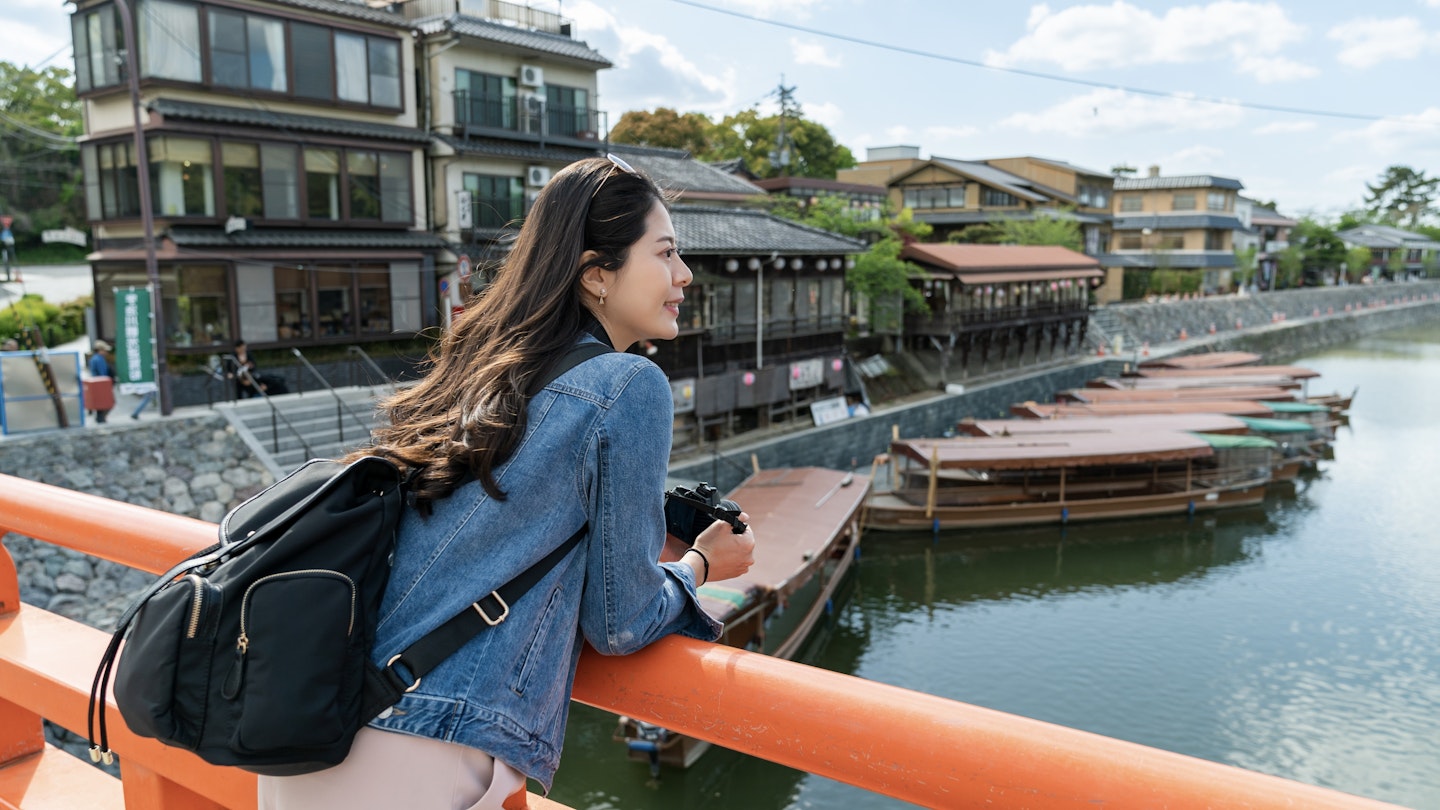
Within an hour or so from Kyoto, historic castles, beautiful canals, nature and much more awaits © PR Image Factory / Shutterstock
Kyoto offers a tantalizing glimpse of ancient Japan – which is why it's one of the most popular destinations in the country. Might we suggest escaping the temple crowds by exploring an alluring spot nearby?
Its position at the heart of the Kansai region makes Kyoto a handy base for hopping on a train to explore fairy-tale castles, go on tasting journeys in matcha towns and float along ancient canals.
Each of these itineraries is accessible by train in under two hours. As you plan, keep in mind that if you plan to make several trips within a five-day period, you should consider a Kansai WIDE Area Pass . (All routes are covered by this or a Japan Rail Pass , except in Hiroshima, as noted below.)
These are the most rewarding day trips from Kyoto.

1. Find your favorite matcha in Uji
Travel time: 20 minutes
Mmm…matcha. Green-tea-obsessed Uji lies just next door to Kyoto, yet draws far fewer crowds. Meander along its Omotesando laneway, dipping in and out of charming stores dedicated to selling locally sourced green tea. Pause in cafes to try matcha-flavored treats – ice cream or soba noodles (or both). As you hold up a skewer of dango to the light, you'll first see the scorch marks, then taste them as you chew through the rice-cake balls. The flavors dance between chargrilled, bitter tea and sweet rice.
At the laneway's end, the vermilion Byōdō-in seems to spread its wings and levitate above a green pond (a sight immortalized on the 10-yen coin). The temple's Phoenix Hall is an excellent example of architecture from the Heian Period; after taking in the ambiance, linger in the gardens and delightful tea salon for an hour. If you want more Heian history, explore the on-site Hoshokan Museum to ponder a temple bell and other Buddhist treasures.
Japanese literature enthusiasts should make a visit to the Tale of Genji Museum, dedicated to Murasaki Shikibu's famous 11th-century work (perhaps the world's first-ever novel). The exhibits provide insights into the portion of the narrative that unfolds in Uji.
Cross the Uji River to visit teahouses where artisans demonstrate how to brew the perfect green tea. In summer, finishing the half-day with a cruise in a wooden boat on the river is a pleasant finale indeed – cormorant-fishing demonstrations optional.
How to get to Uji from Kyoto: From Kyoto Station, take the JR Nara line to JR Uji Station.
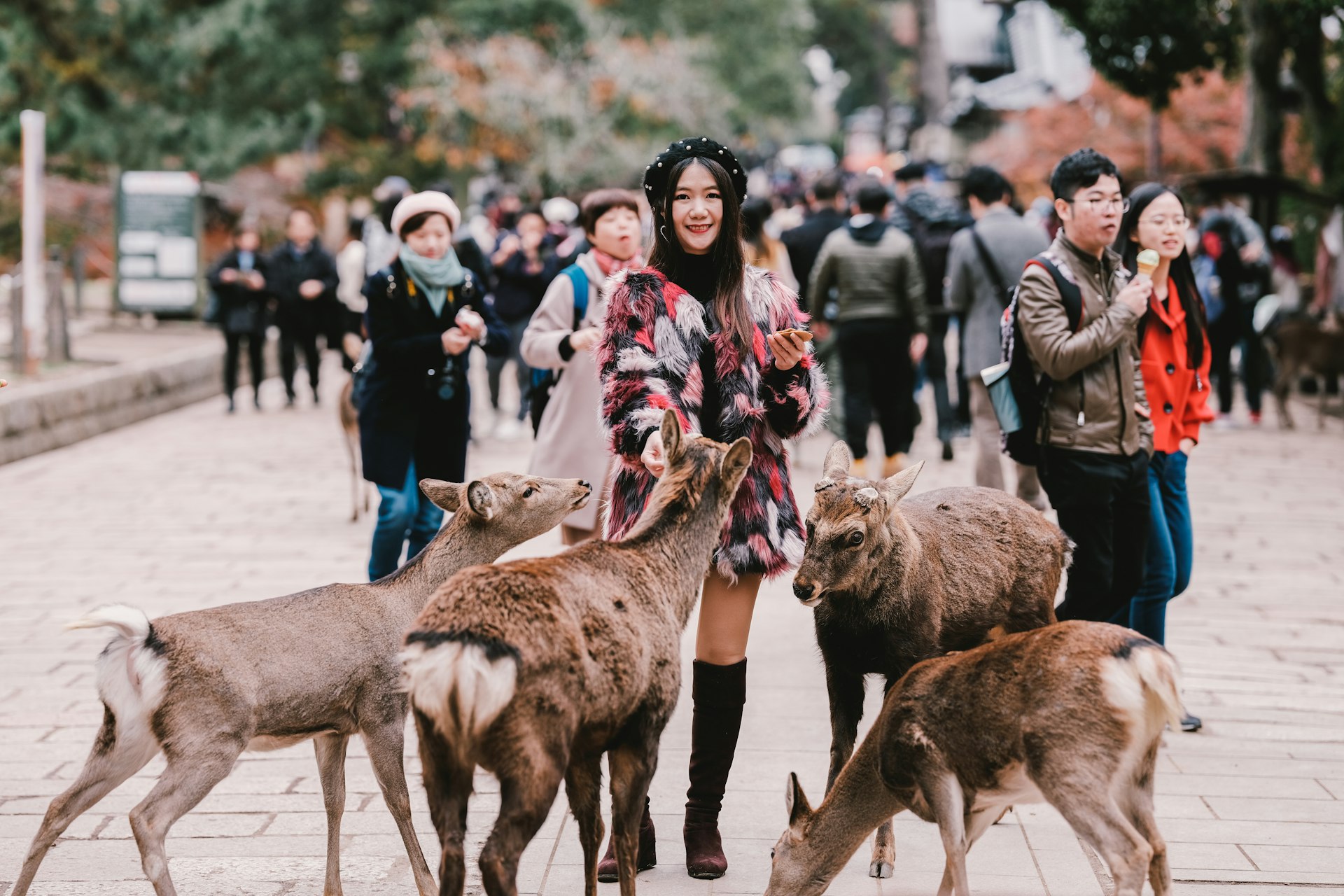
2. Encounter history – and deer – in Nara
Travel time: 1 hour
When you come eye to eye with the deer in Nara , you might decide for yourself if, as legend has it, they are divine messengers from the heavens. The 1000-plus placid deer that roam leafy Nara-kōen are an iconic symbol of Japan's first imperial capital. (Feel free to feed the free-roaming deer with crackers sold on-site.) You can take in plenty of Nara's history-rich sights while you're in the park, including the Great Buddha at Tōdai-ji , who is seated with an open hand as tall as a person. Early risers: if you get to Nara by 9am, it's worth observing morning prayers within the splendor of vermilion and cedar shrine pavilions at Kasuga Taisha .
How to get to Nara from Kyoto: From Kyoto Station, take a 55-minute Rapid train on the JR Nara line to Nara Station.
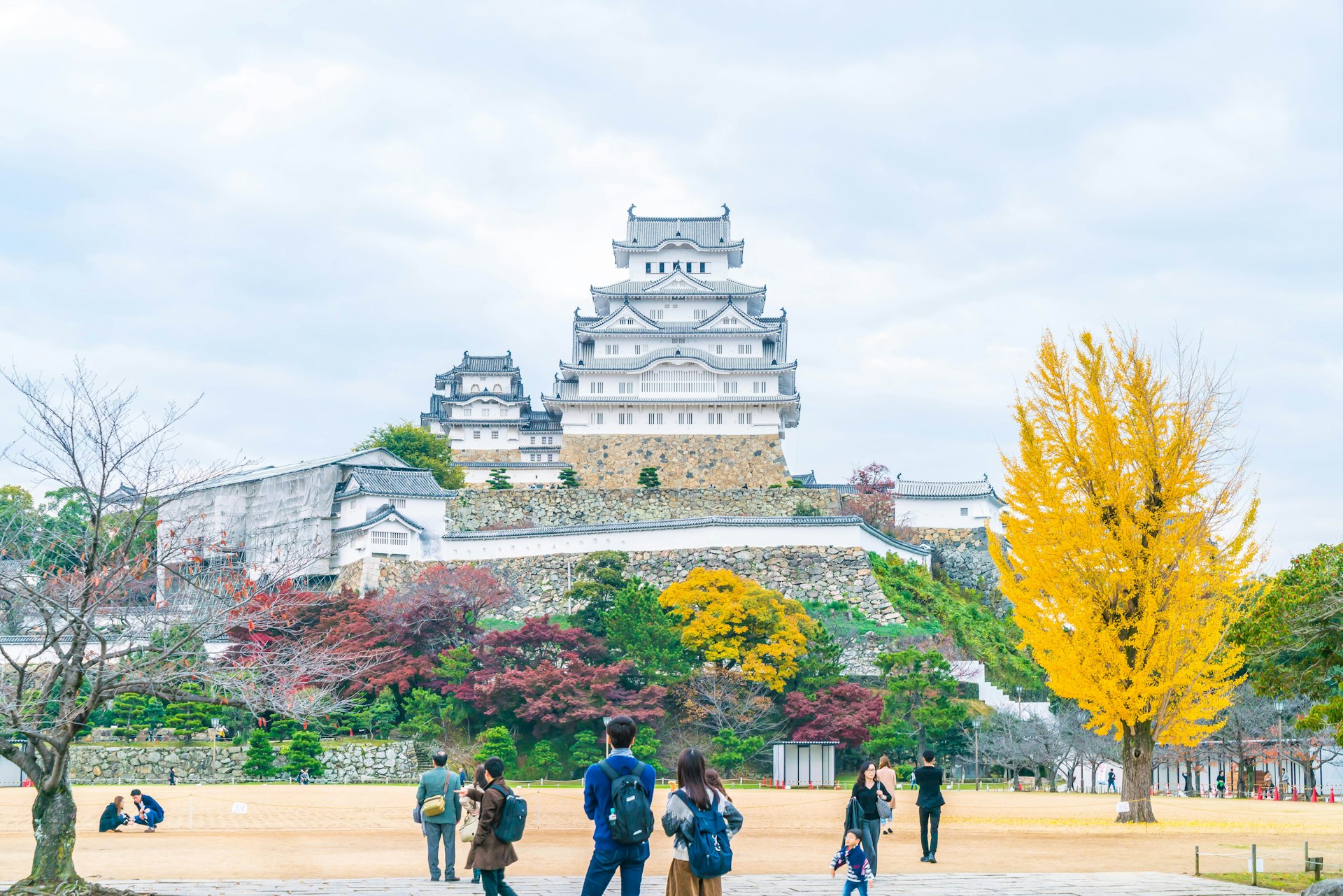
3. Climb Japan's best-preserved castle at Himeji-jō
Tilting your head skywards to be dazzled by the five splendid white stories of Himeji-jō is the stuff of Japanese fairy tales. In fact, the "White Heron" castle has been showcased in movies and TV series aplenty – which is no wonder, given how rare it is to find a truly intact (and not reconstructed) medieval castle in Japan.
Himeji-jō is a stunner, and it's worth visiting early to beat the crowds. Set aside an hour or two to climb to the top for great city views, then to take in the surrounding nine gardens within Kōko-en, designed in Edo Period style. A great time to visit is during cherry blossom season, when everything is framed in pink blooms and petals float atop the moats.
How to get to Himeji-jō from Kyoto: From Kyoto Station, take a JR Hikari train for 55 minutes to Himeji Station.
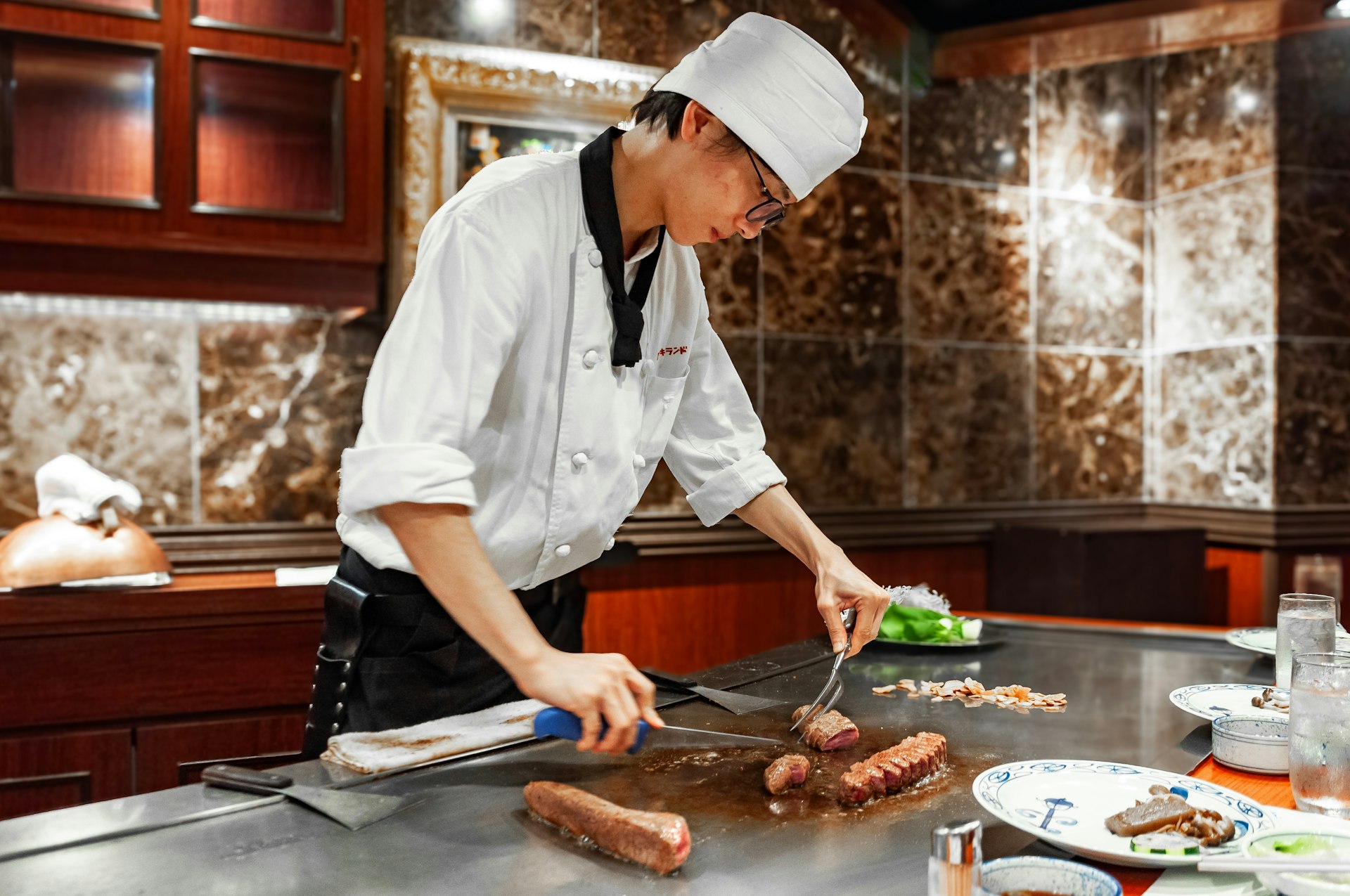
4. Eat real wagyū in Kōbe
Travel time: 2 hours
Kōbe is Japan's easy and breezy nature city, with countless things to do . Here, the mountains hug the seaport, with great views at every turn that make you stop and smile. Stop to dig into authentic wagyū (Japanese beef) – registered restaurants (identifiable by indoor plaque written in Japanese) are the most reliable. A superb place to start is with the good-value set beef menu at Tor Road Steak Aoyama – or by going all out with an exquisite teppanyaki experience (watching your chef work a hot plate) at Genkichi Kobe Beef . Head uphill from Sannomiya Station to a district of tree-lined streets with merchant houses, quaint cafes and unique shops.
Even with a population of 1.5 million, Kōbe offers easy access to nature. Mt Rokko, a popular hiking spot (accessible by cable car, too), towers over the city's narrow streets and features the landscaped Nunobiki Herb Gardens . Meanwhile, further up, Nunobiki Falls has been a muse for artists, poets and worshippers for centuries.
How to get to Kōbe from Kyoto: From Kyoto Station, take a JR Limited Express Super Hakuto train for 50 minutes to Sannomiya Station. There are two loop buses plying all the sights of the port and city.
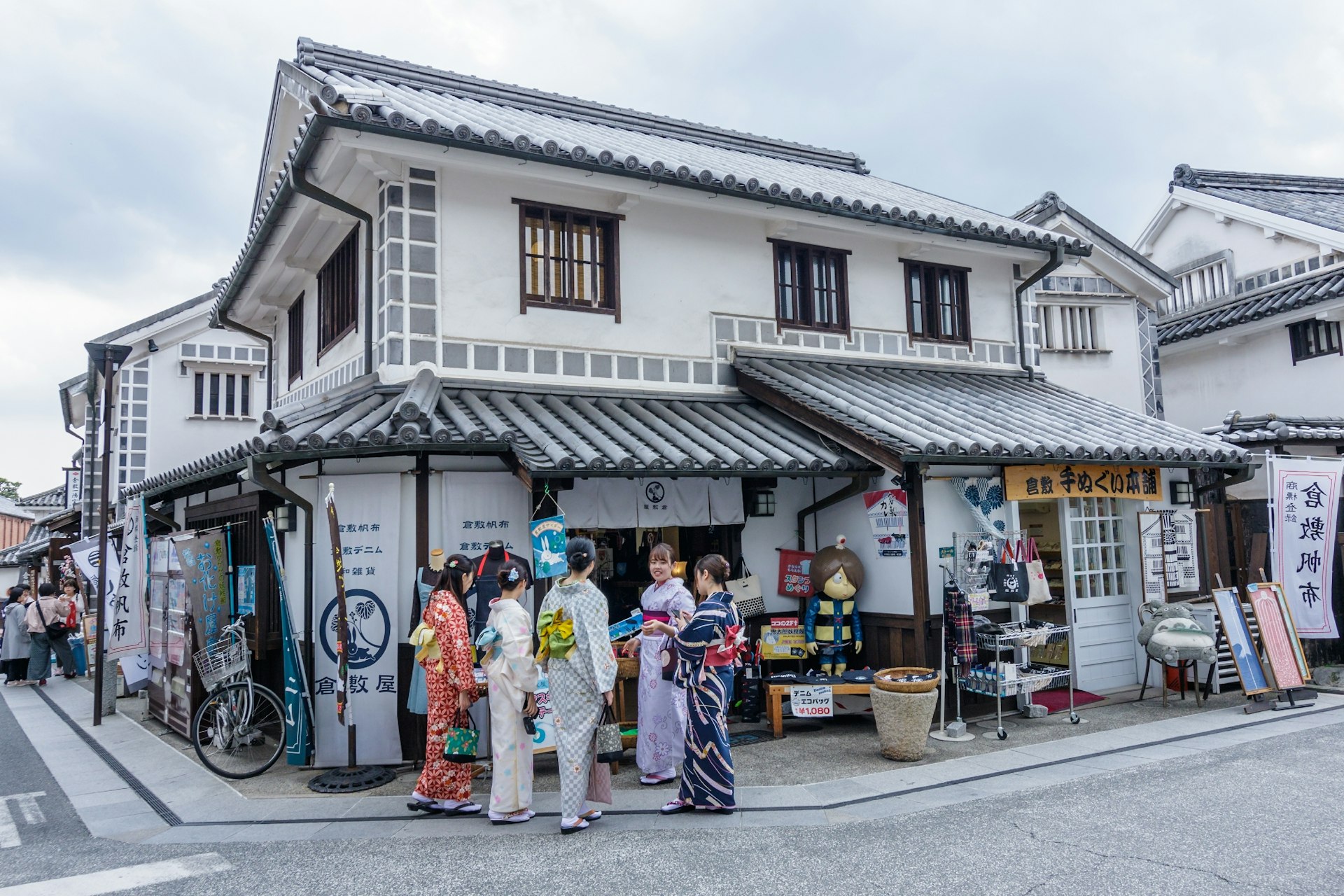
5. Daydream along the canals of Kurashiki
Willow trees dip into the canals, while handsome black-and-white Edo period (1603–1868) warehouses are tucked away off side lanes. A day trip to Kurashiki is like encountering an outdoor museum. Those buildings – many now converted into denim boutiques, cafes and art workshops – make up the atmospheric Bikan quarter.
Wander the laneways lined with old wooden houses and shops first before popping into the popular Ōhara Museum of Art , which displays works by Picasso, Cézanne and Matisse. Kids will love seeing the exhibits at the Japan Rural Toy Museum , or snacking on a denim-blue ice cream or burger in the Kojima district. (Kurashiki has been jeans-obsessed since its trading-hub days).
A traditional boat tour of Kurashiki Canal is a lovely way to pass the afternoon. On land, Ivy Square is a pretty courtyard that once housed textile factories but now often plays host to live entertainment.
How to get to Kurashiki from Kyoto: Ride the 90-minute Hikari bullet train to Okayama Station, then change to the 15-minute JR Sanyo line train to Kurashiki Station.
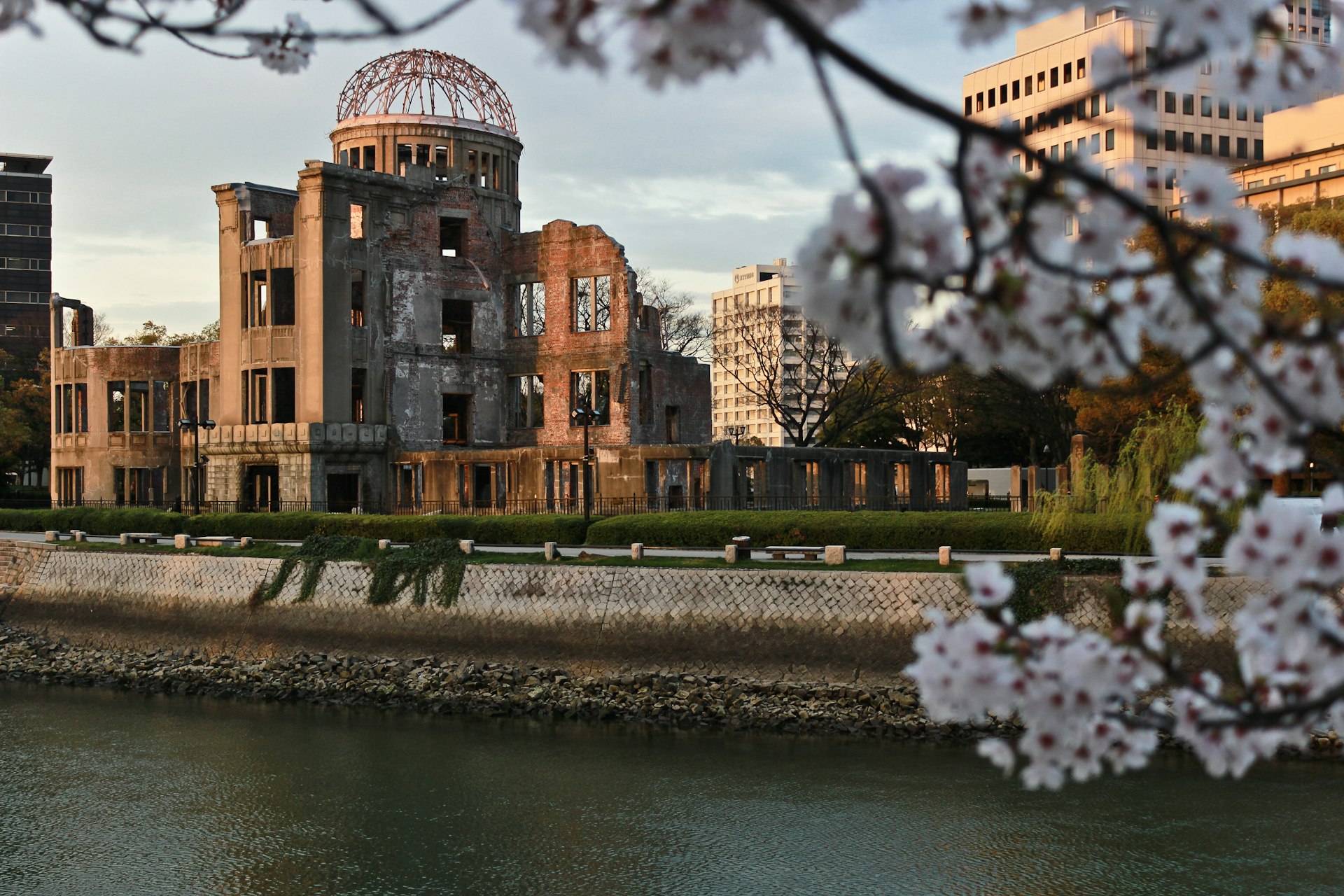
6. Reflect on peace in Hiroshima
Hiroshima may be synonymous with the devastating atomic bomb attack in 1945. But this leafy, laid-back city has much more to offer visitors these days than just its past. If you want to reflect on the preciousness of peace in the face of war, definitely start at the Peace Memorial Park , then take in the haunting Atomic Bomb Dome , one of very few buildings left standing near the epicenter, whose shell has been preserved as a memorial alongside the Hiroshima Peace Memorial Museum . Seeing the colorful garlands of origami paper cranes sent from schools across the world at the Children's Peace Monument is joyfully moving.
It's ambitious but possible to tackle Hiroshima as a day trip from Kyoto; we'd recommend lingering in the city and staying the night. That way, you can dig into a Hiroshima-style okonomiyaki (savory pancake), which adds a layer of yakisoba noodles for delicious heftiness. A fun way to taste it is by choosing one of the dozens of okonomiyaki restaurants at the multi-level Okonomimura food hall.
Another reason to stay into the late afternoon is the short trip over to the gorgeous island of Miyajima , home to Itsukushima-jinja , a bright red shrine rising out of the ocean – and one of Japan's most iconic views. From here, you can wander through streets lined with machiya (old wooden townhouses) and, if you have another spare hour, take a cable car up to the summit of Mt Misen for breathtaking views of the Seto Inland Sea.
How to get to Hiroshima from Kyoto: From Kyoto Station, take the Shinkansen Nozomi bullet train to Hiroshima (1 hour 40 minutes; this is not covered by JR Pass alone – an additional fee is required). Tourist loop buses and trams depart regularly from Hiroshima Station to the Peace Park. To reach the ferry port from Hiroshima Station, take the JR Sanyo line for 25 minutes to Miyajimaguchi Station.
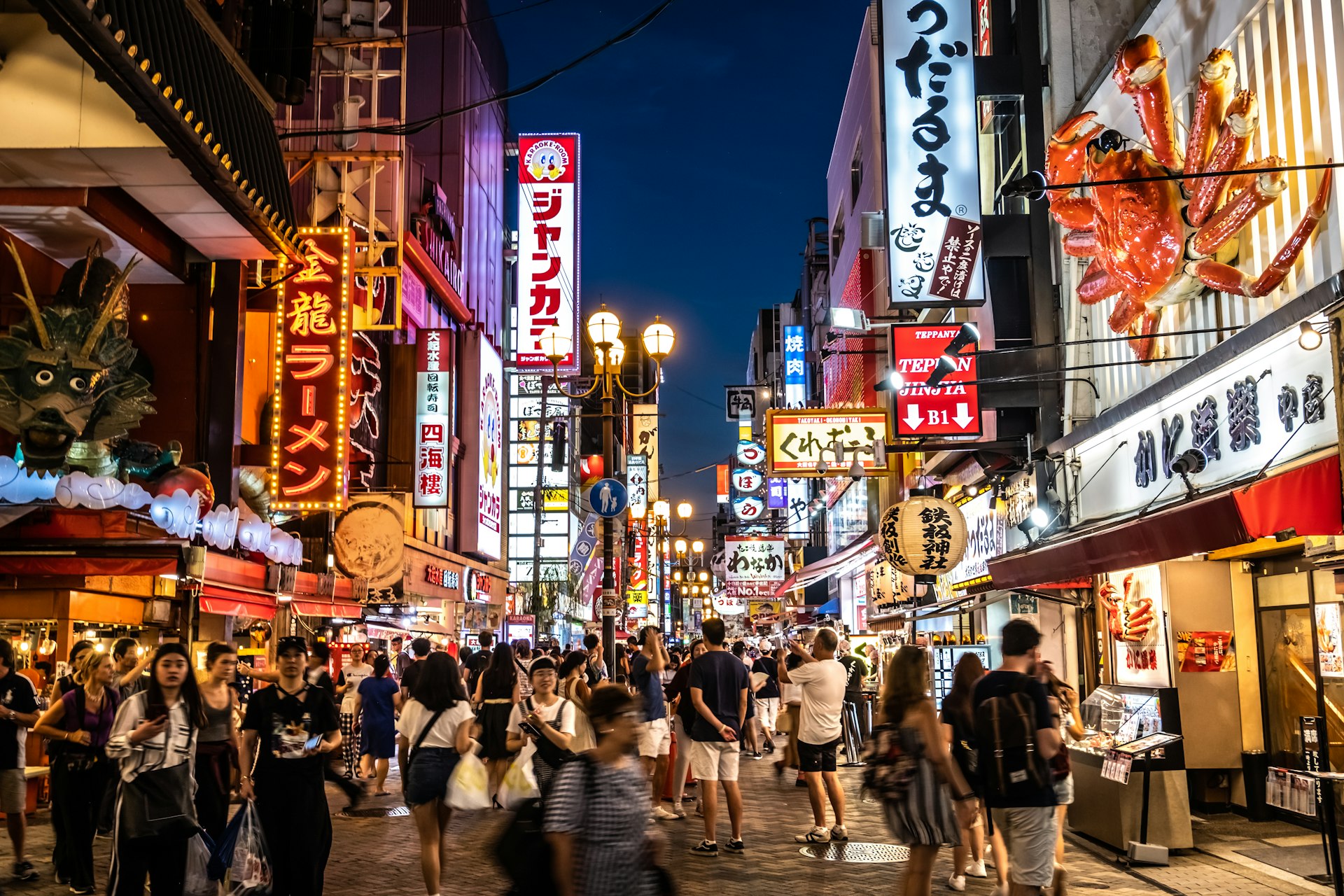
7. Taste the sizzle of street food in Osaka
Travel time: under 30 minutes
Osaka's street-food stalls are a festival of lanterns and delicious, sizzling smells, enjoyable day or night – easily done in a quick jaunt from Kyoto. Since the city is known as "Japan's kitchen," arrive hungry.
Its motto of kuidaore literally means "to eat oneself bankrupt." Which means you can expect to carve up okonomiyaki (savory pancakes) and devour takoyaki (fried octopus balls) along the canal in Dōtombori , peering up to see the iconic Running Man sign. Then try kushikatsu (crumbed meat and vegetables on sticks) near the Tsutenkaku Tower in the kitschy, retro neighborhood of Shin-Sekai .
As you wind through the alleyways of Ura-Namba to Torame Yokacho (Tiger Alley), you can try a range of favorite dishes under one roof. When full, walk off your excesses in the expansive grounds of Osaka Castle or browse boutique and vintage clothing shops in the hip neighborhoods of Amerika-Mura , Horie and Nakazakicho.
How to get to Osaka from Kyoto: From Kyoto Station, take a 28-minute JR Special Rapid train bound for Himeji to Osaka Station. Bullet trains also run between Kyoto and Shin-Osaka Station.
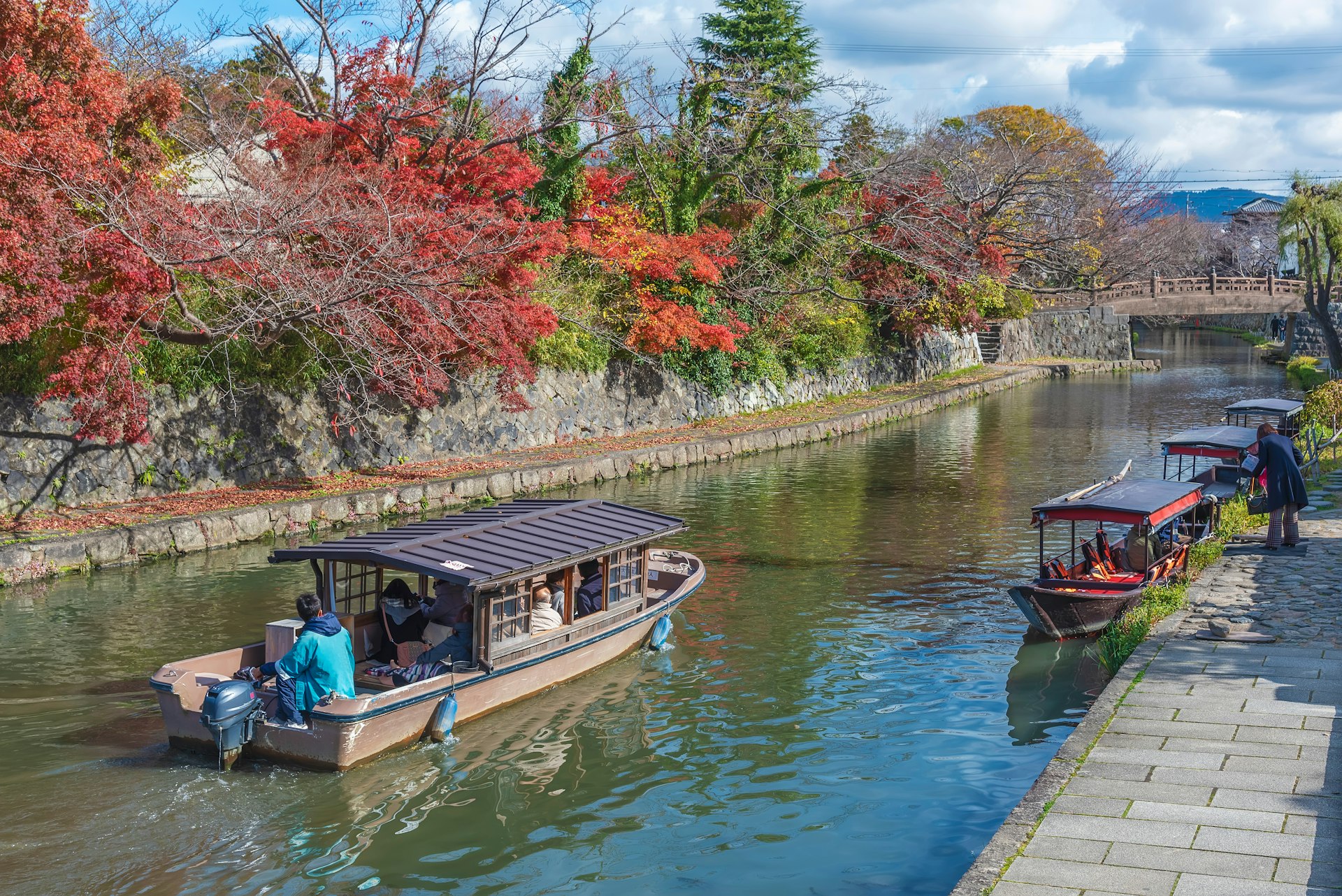
8. Cycle, swim, hike and ride canal boats around Lake Biwa
Travel time: 35 minutes
Japan's largest lake is rich with outdoor life. Along its shores, visitors find an almost overwhelming number of temples, castles, cities and activities spread hours apart. Start in the lake's most wonderfully preserved town, Ōmihachiman, far away from foreign crowds. From here, you can rent bicycles and follow the color-coded path markings for straightforward, self-guided cycling on a section around the lake. Or take it slow with a canal boat ride on the narrow waterways, gazing at the feudal-era merchant houses of Ōmihachiman, which once held goods brought across the Sea of Japan.
If you head up the Hachimanyama Ropeway, you'll be rewarded with great views across Lake Biwa, as well as short hiking trails. In summer, listen for the waves pattering the lake shore, inviting you for gentle beach swimming.
With more time, you can chase down the torii (gates) of Shirahige Shrine, which seem to float on the lake, or 17th-century Hikone-jō , shrouded in beautiful autumnal colors in mid- to late-November.
How to get to Lake Biwa from Kyoto: From Kyoto Station, take a Special Rapid train to Omi Hachiman Station.
This article was first published July 2019 and updated January 2024
Explore related stories
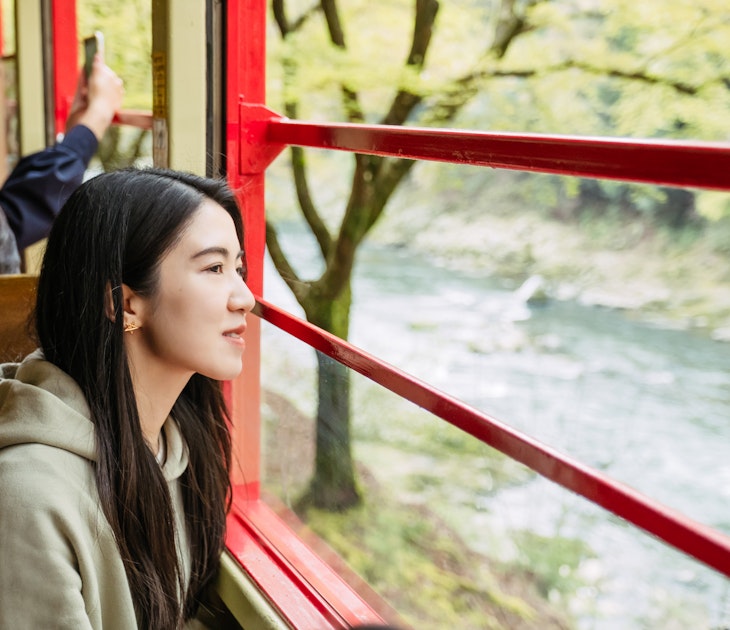
Destination Practicalities
Mar 25, 2024 • 9 min read
With its myriad islands, towering mountains and megacities, Japan can be a daunting destination to get around. We've got everything you need to know.

Dec 17, 2023 • 6 min read
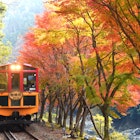
Mar 1, 2020 • 2 min read
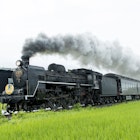
Jan 31, 2020 • 7 min read

Nov 7, 2016 • 1 min read

Apr 14, 2024 • 6 min read

Mar 31, 2024 • 7 min read

Mar 28, 2024 • 7 min read

Mar 28, 2024 • 6 min read

Mar 28, 2024 • 11 min read
Nomadic Matt's Travel Site
Travel Better, Cheaper, Longer
The Perfect 7-Day Japan Itinerary for First-Time Visitors

Japan captured my heart from the moment I firs visited. The delicious food, the rich culture, breathtaking landscapes, vibrant history, and the very friendly and polite people – it all blew my mind.
But Japan often feels impenetrable, especially to first-time visitors. While I think Japan deserves a minimum of 10 days, I get that some people might only have a week, so I wanted to write this, my ideal seven-day itinerary for Japan for a first-time visitor.
With only a week, there’s not much you can see unless you really rush it. And I don’t think you should do that.
So this itinerary only focuses on Tokyo and Kyoto (the most popular destinations) as well as some day trips from each. If you wanted to rush things a little, you could add in Osaka (more on that at the end).
(Note: If you purchased a Japan Rail Pass , activate it on arrival. That way, you can take advantage of the free JR trains throughout the city.)
Table of Contents
Japan Itinerary Day 1: Tokyo
Japan itinerary day 2: tokyo, japan itinerary day 3: tokyo, japan itinerary day 4: kyoto, japan itinerary day 5: kyoto, japan itinerary day 6: nara, japan itinerary day 7: tokyo, an alternative itinerary.

Tsukiji and Toyosu Fish Markets Cure your jet lag with some food! In 2018, Tokyo’s main fish market moved to Toyosu. It is now twice the size of Tsukiji (the old one), making it the largest such market in the world. Here you can eat fresh sushi for breakfast, just a few feet from where it was hauled in from the sea, while marveling at the chaotic atmosphere.
You can still head to the old market in Tsukiji to eat, shop, and wander as well. I like it a lot, because there are more food options! Food and drink tours of the Tsukiji Outer Market are available for around 15,000 JPY.
Toyosu Fish Market is open Monday-Saturday 5am-5pm, though most shops don’t open until 7am. Admission is free, but you have to pick up a visitor’s pass when you enter. Tsukiji Fish Market’s hours vary by shop (usually 5am-2pm). Admission is free.
teamLab Planets This digital art installation is a multi-sensory and immersive experience in which you become part of the artwork, walking barefoot through the four exhibition spaces and gardens as you interact with the installations’ elements in unique ways. It’s really fun! TeamLab is generally sells out in advance, so I recommend getting your tickets online ahead of time .
Take a walking tour Walking tours are a great way to get the lay of the land while connecting with a local guide. I always go on one or two when I arrive somewhere. Tokyo Localized offers many free tours, including a classic overview and ones of both the famed Harajuku and Shinjuku neighborhoods. Its Imperial Palace tour would be the most convenient one after teamLab.
The Imperial Palace Formerly Edo Castle, the Imperial Palace was built in the 15th century, and some of the walls and moats from that time are still in use to this day. When the emperor moved from Kyoto to Tokyo in 1869, he took Edo for his new palace and renamed it. While you can’t go inside, it is surrounded by beautiful grounds, a moat, and a park worth wandering through. You can also see the changing-of-the-guard ceremony (though it’s relatively low-key and unassuming). Admission to the grounds is free.
Shinjuku Gyoen National Garden This park is over 144 acres and home to some 20,000 trees. Most of the original park was destroyed in World War II but was rebuilt and reopened in 1949. During spring, it is one of the best places to see cherry blossoms. My favorite area is the landscape garden, which has several ponds with bridges and islands. It’s a peaceful oasis away from the urban hustle and bustle.
Depending on how you feel relative to your jetlag, you could fit a few more activities before you end your day. Check out this post for suggestions .

- Senso-ji – This is Tokyo’s most popular and famous temple. Beautifully painted, it sits in a scenic spot near a pagoda and the lovely Kaminari Gate. There’s a huge statue of Kannon, the goddess of mercy, inside the main hall. It’s very busy during the day, so maybe check out the grounds in the evening.
- Asakusa Shrine – This nearby Shinto shrine is much more peaceful, with fewer visitors, but with people praying, meditating, or performing traditional rituals. It was built during the Edo period (1603–1868) and survived the air raids of World War II.
Afterward, head to Ueno Park . Spanning over 133 acres, Ueno Park was established in 1873 on land formerly owned by a 17th-century Buddhist temple. It gets super busy in cherry blossom season, as there are over a thousand trees here. Throughout, you’ll find various stalls and vendors selling snacks, drinks, and souvenirs. On weekends, there are usually cultural events or festivals showcasing traditional arts, music, and dance. Four of Tokyo’s main museums are here:
- Tokyo National Museum – Established in 1872 on the north end, this massive building is the oldest and largest art museum in Japan. It houses one of the world’s largest collections of art and artifacts from Asia, particularly Japan.
- Tokyo Metropolitan Art Museum – This museum showcases rotating exhibitions of contemporary and traditional Japanese art.
- National Museum of Nature and Science – This museum features a wide range of permanent and temporary exhibitions covering natural science and history.
- Tosho-gu Shrine – This beautiful 17th-century Shinto shrine has carved gold doors and other ornate carvings. It’s worth seeing up close!
Afterward, walk down to Akihabara to explore the video game parlors, arcades, and anime shops. This very buzzy area is ground zero for all things electronic, and it’s fun to play many of the games. This is where you’ll find the famous maid cafés, where servers dress up as maids and serve you food and drinks. These range from big touristy ones to holes-in-the-wall (the girls on the street are promoting the latter, which are a lot more culturally fun). They aren’t cheap, though, as you have to buy drink packages and pay a fee, but they’re kitschy and fun.
In the evening, visit Shinjuku and then drink in Golden Gai . In Shinjuku, you’ll find a plethora of cool bars, bright lights, and tiny hole-in-the-wall eateries. Be sure to wander down Memory Lane (aka Piss Alley) for tiny izakaya joints and bars. Afterward, head over to Golden Gai, a warren of narrow alleyways with a bit of a red-light-district feel, flanked by diminutive backstreet bars. It’s quite touristy but also a lot of fun. I’ve had some wild nights here!
With Arigato Tours , you’ll learn about the neighborhood while stopping to sample Japanese classics like sushi, yakitori, and ramen. The 23,900 JPY cost includes a drink and dishes at four stops.

Kamakura Here you can see a 13-meter (43-foot) bronze statue of Buddha that was built in 1252. It was initially constructed within Kotoku-in Temple, but that has since been washed away by several storms, so it now sits in the open air. Admission to enter the temple grounds is 300 JPY, while it’s 20 JPY to go inside the statue. The journey there — around an hour — is free with a Japan Rail Pass .
Tokyo Disneyland I’m a sucker for Disney. You’ll find many of the same classic rides from Disney World here, like Splash Mountain, Big Thunder Mountain, The Haunted Mansion, and everyone’s favorite teacup ride, The Mad Tea Party. But there are several unique attractions as well, like Pooh’s Hunny Hunt and Journey to the Center of the Earth.
Ticket prices vary depending on the day and time, but full-day admission begins at 7,900 JPY for adults and 4,400-6,200 JPY for children. It’s best to book in advance .
Mount Fuji Mount Fuji is located an hour outside of Tokyo. An active stratovolcano (which last erupted in 1708) and covered in snow for almost half of the year, it stands an impressive 3,776 meters (12,389 feet) and provides one of the most iconic views in the country. One of the Three Holy Mountains of Japan, Mount Fuji is both a Special Place of Scenic Beauty and a UNESCO Cultural Site. In the summer, the mountain is open to hikers, who take 5-12 hours to reach the summit (traditionally, they depart at night to arrive at the top for the sunrise).
If you don’t want to hike, you can simply visit on a day trip. There are buses that can take you partway up, where you’ll be offered sweeping vistas of the surrounding area. Guided day tours from the city cost around 12,000 JPY.

Wander the Bamboo Forest For a relaxing break, head to Arashiyama and let the dense and towering stands of bamboo envelop you. Located near the famous Tenryu-ji temple, it’s one of the most beautiful places in the entire country. It’s not that big, but there are some hidden areas to explore. Just make sure to arrive early if you want to enjoy it without the crowds (it fills up fast after sunrise).
While there, I would also recommend visiting the Okochi Sanso Garden, which (along with the home) belonged to the famous Japanese actor Denjir? ?k?chi (1898–1962). It’s not free (it’s 1,000 JPY), but it’s really nice and has some wonderful views.
Visit the Golden Pavilion Originally built in the late 14th century as a retirement villa for the shogun (military governor), this iconic structure was later converted into a Zen Buddhist temple. The present-day edifice dates only to the 1950s, however, when a monk attempting to kill himself burned the historic original to the ground. The rebuilt temple is covered in brilliant gold leaf, symbolizing purity and enlightenment. Each of the three stories exhibits a different architectural style. Completing the scene are the serene reflecting pool and traditional Japanese gardens that contain lush foliage, manicured trees, and scenic walking paths.
1 Kinkakuji-cho, Kita-ku, Kyoto-shi, Kyoto, +81 075-461-0013, shokoku-ji.jp. Open daily 9am-5pm. Admission is 500 JPY.
Admire Ryoan-ji Temple This is my favorite temple in Kyoto. Originally established in 1450 as a residence for a high-ranking samurai, it was soon converted into a Zen temple and is now a UNESCO World Heritage Site, with a mausoleum that houses the remains of seven emperors. Its traditional rock and sand garden is considered one of the best in the country. There’s also a teahouse where you can experience the traditional Japanese tea ceremony ( chanoyu ) as you overlook the Kyoyochi reflecting pool.
There are other temples in the area to check out as well:
- Daitoku-ji Temple – This massive complex dating back to 1315 covers almost 60 acres. It contains several dozen temples and is a good place to see a variety of Zen gardens and architectural styles. It’s also deeply linked to the Japanese tea ceremony, as several of the country’s most noteworthy masters studied here.
- Toji Temple – This is home to Japan’s tallest pagoda (five stories high). Founded in 796, just after Kyoto became the capital, it was one of only three Buddhist temples allowed in the city.
Go on a sake brewery tour Kyoto has a sake (rice wine) brewing tradition going back 400 years and is known for some of the best in the world, due to using the area’s pure natural spring water in the brewing process. Arigato Tours offers an excellent three-hour tour of Fushimi (the brewing district) for 23,320 JPY, including stops at several breweries, a guided tour of the Gekkeikan Okura Sake Museum, and tastings.

See the Fushimi Inari Shrine This mountainside Shinto shrine, dating back to 711, is dedicated to Inari, the god of rice and prosperity. It’s known for its thousands of vibrant orange torii gates that form a network of trails leading up Mount Inari. You can hike the trails on your own while enjoying panoramic views of Kyoto below or join a guided hiking tour , on which you’ll get off the paved paths and into hidden bamboo groves. Get here as early as possible to avoid the crowds.
68 Fukakusa Yabunouchicho, +81756417331, inari.jp. Open 24/7. Admission is free.
Walk around Higashiyama Spend an afternoon walking along the narrow streets of one of the oldest and best preserved districts on your own or on a walking tour . The traditional machiya buildings (traditional wooden townhouses) are filled with small shops selling local specialties and handicrafts, as well as restaurants and teahouses. It’s a popular area in which to participate in a tea ceremony . Another nice place to stroll in this neighborhood is the Philosopher’s Path, which follows a cherry-tree-lined canal that’s beautiful and meditative even when the blossoms aren’t in season.
Visit Kiyomizu-dera One of a number of UNESCO sites in ancient Kyoto, Kiyomizu-dera (meaning “pure water temple”) is located in the foothills of Mount Otowa in the eastern part of the city. It’s one of the most famous temples in all of Japan. It was established in 778, but most of the existing buildings date to the 17th century. There’s not a single nail used in the construction, which becomes all the more impressive once you see how large the temple is, which is best known for its wooden terrace that juts out over the hillside. The temple’s name comes from the nearby waterfall whose waters (from which you can still drink today) are said to have wish-granting and healing powers.
1 Chome-294 Kiyomizu, +81 75-551-1234, kiyomizudera.or.jp. Open daily 6am-6pm. Admission is 400 JPY.
Explore Shorin-ji Temple This small temple dates back to the 16th century. What makes it worth visiting is its meditation classes. You’ll get to tour the temple and then be instructed in zazen , the Japanese style of meditation. It’s a very unique experience and something that I think will add a lot of depth and nuance to your visit (especially if you’ve seen a lot of temples). Just make sure to dress comfortably.
15 Chome-795 Honmachi, +81 75-561-4311, shourin-ji.org. Open daily 10am-4pm. Admission is 800 JPY.
Wander the Nishiki Market Nishiki Ichiba is now one of the biggest indoor markets in town. Known as “Kyoto’s Kitchen” and spanning over five blocks, it is full of vendors selling traditional dishes from the region, classic Kyoto souvenirs, and really just about anything else. There are over a hundred stalls here, many of which have been in the same family for generations. Opening hours depend on the shop but are typically from 9am to 6pm.
To dive deeper into Japanese food culture, you can take a food tour of the market . It’s the best way to learn about all the food you’ll see, as well as the market’s history.
Explore Gion Gion, the historic geisha district, is renowned as being one of the most iconic and atmospheric areas of town. It’s known for its traditional wooden machiya houses, narrow alleyways, cobblestone streets, and preservation of geisha (known locally as geiko) culture. Lining the main street are ochayas (teahouses where geishas entertain), small shops, and many restaurants, ranging from upscale kaiseki restaurants serving traditional Kyoto cuisine to casual eateries.
To really learn more about this amazing party of town and its past, take a walking tour of Gion . You’ll learn a ton and get a lot of context. They cost around 1,800 JPY.
At night, go to the Pontocho Row , a narrow street lined with restaurants, hole-in-the-wall bars, and jazz clubs. It’s one of the more lively areas in Kyoto.

Nara was the capital of Japan in the eighth century, so there are lots of buildings and temples here that are upwards of a thousand years old (which is rare in Japan, due to the prevalence of fires and earthquakes, as well as World War II). Some things to do:
- Frolic with deer – The real draw in Nara are the deer. Since the 17th century, those in and around the city have been considered sacred. You can buy crackers to feed them or just watch them stroll around carefree.
- See the Buddha – Don’t miss a visit to Todai-ji, the world’s largest wooden building, home to a 16-meter (52-foot) Buddha statue. It was built in 738 and is now a UNESCO World Heritage Site.
- Take a walking tour – This guided half-day walking tour for 11,500 JPY includes all of Nara’s highlights as well as a traditional lunch.

Ryogoku Kokugikan, Japan’s most famous sumo wrestling arena, hosts tournaments three times each year, in January, May, and September. Tickets sell out quickly, so book online in advance. Prices vary but start around 3,200 JPY for arena seats. You can book a ticket online here (you’ll be accompanied by a guide too, so you can learn more about the tradition as it unfolds before your eyes).
To learn more about the sport in in the off-season, book a tour of a sumo stable .

So, if you want to add another city to this itinerary you can follow this breakdown:
- Days 1 & 2: Tokyo
- Days 3 & 4: Kyoto
- Day 5: Nara
- Days 6 & 7: Osaka
Tokyo, Kyoto, and Nara are all covered above. As for Osaka, some of my favorite things to see and do:
Take a food tour Known as “the Kitchen of Japan,” Osaka boasts a diverse culinary scene. Mouthwatering sushi and sashimi, Kobe beef and Japanese BBQ, and flavorful ramen can all be found here in abundance. Plus, there are local specialties like okonomiyaki (a savory pancake with egg and vegetables) and kushikatsu (kebab skewers). You can take a food tour for around 13,000 JPY, a ramen and gyoza cooking class for 9,500 JPY, or just wander and eat.
Osaka Castle One of the most famous landmarks in the country, the castle was originally built in the late 16th century by Toyotomi Hideyoshi and played a pivotal role in the unification of Japan during the Sengoku period (1467-1615). Over the centuries, it has been destroyed and rebuilt multiple times due to wars, fires, and natural disasters. The current version dates to 1931. The castle is situated amid sprawling grounds and surrounded by a moat. It’s also home to a small but insightful museum and an observation deck that offers some picturesque urban views.
Dotonbori This is arguably Osaka’s most iconic district, known for its vibrant nightlife (bars, clubs, theaters, and music venues), colorful signage, and delicious food. It’s best seen at night due to the plethora of huge neon lights and signs lining both the canal and streets, which have become symbols of Osaka’s nightlife. A guided walking tour that includes Dotonbori as well adjacent neighborhoods is 6,500 JPY.
Shitennoji Temple This temple is one of the oldest Buddhist temples in Japan, founded in 593. The architecture is a blend of traditional Japanese and East Asian styles, featuring impressive pagodas, gates, and shrines set amid serene gardens. Stroll through the tranquil grounds, admire the beautiful architecture, and learn about the temple’s historical and cultural significance at the museum. The temple is 300 JPY to enter, the garden is 300 JPY, and the museum is 500 JPY.
Japan is one of my favorite countries. While it’s relatively small, it offers an amazing array of things to see and do (as well as some of the best food in the world). With seven days, you can easily see a good number of the main highlights and get a taste for the incredible history and culture. It will be a busy week, but this itinerary ensures you’ll still have some time to slow down, relax, and take in the local pace of life.
Just make sure you get a Japan Rail Pass before you go. While it’s not as cheap as it used to be, it will likely save you time and money!
Book Your Trip to Japan: Logistical Tips and Tricks
Book Your Flight Find a cheap flight by using Skyscanner . They are my two favorite search engines, because they search websites and airlines around the globe, so you always know no stone is being left unturned!
Book Your Accommodation You can book your hostel with Hostelworld as they have the most comprehensive inventory so they are best for booking a hostel. If you want to stay in a hotel or guesthouse in Japan, use Booking.com as it consistently returns the cheapest rates for guesthouses and hotels.
Don’t Forget Travel Insurance Travel insurance will protect you against illness, injury, theft, and cancelations. It’s comprehensive protection in case anything goes wrong. I never go on a trip without it, as I’ve had to use it many times in the past. My favorite companies that offer the best service and value are:
- Safety Wing (best for everyone)
- Insure My Trip (for those over 70)
- Medjet (for additional evacuation coverage)
Looking for the Best Companies to Save Money With? Check out my resource page for the best companies to use when you travel! I list all the ones I use to save money when I travel — and I think they will help you too!
Be sure to check out the Japan Rail Pass if you’ll be traveling around the country. It comes in 7-, 14-, and 21-day passes and can save you a ton of money!
Looking for More Travel Tips for Japan? Check out my in-depth Japan travel guide for more ways to save money, information on costs, tips on what to see and do, suggested itineraries and reading and packing lists, and much, much more!
Got a comment on this article? Join the conversation on Facebook , Instagram , or Twitter and share your thoughts!
Disclosure: Please note that some of the links above may be affiliate links, and at no additional cost to you, I earn a commission if you make a purchase. I recommend only products and companies I use and the income goes to keeping the site community supported and ad free.
Related Posts

Get my best stuff sent straight to you!
Pin it on pinterest.
- Car Rentals
- Airport Transfers
- Attractions & Tours
- Bundle & Save
- Destinations
- Trip.com Rewards
Tokyo & Kyoto in 5 Days: A Cultural Odyssey

April 18, 2024 · 3 min read

Embark on a 5-day cultural odyssey through the heart of Japan, exploring the historic streets of Kyoto and the vibrant cityscape of Tokyo. Begin your journey in Kyoto's Gion district, where traditional wooden machiya houses line the streets. Spend 2 hours soaking in the atmosphere before heading to the Yasaka-jinja Shrine, a spiritual haven for another hour. Wander through the charming lanes of Sannenzaka & Ninenzaka, and marvel at the architectural splendor of Kiyomizu-dera Temple. On day two, ascend the vermilion torii gates at Fushimi Inari Taisha, then indulge in local flavors at Nishiki Market. Nijō Castle's grandeur awaits you with its rich history and World Cultural Heritage status. Day three introduces the golden pavilion of Kinkaku-ji, the tranquil rock gardens of Ryōan-ji, and a picturesque journey aboard the Arashiyama Sagano Romantic Train. Transition to the bustling energy of Tokyo on day four, immersing yourself in the dynamic Shinjuku City and finding peace within the lush Shinjuku Gyoen National Garden. Your final day is a tech enthusiast's dream in Akihabara Electric Town, followed by the historic Sensō-ji temple and panoramic views from Tokyo Skytree. This itinerary promises a blend of tradition and modernity, ensuring an unforgettable experience in Japan.
- Day 1: Exploring the Timeless Charm of Kyoto's Gion and Historic Temples

Begin your Kyoto adventure by stepping into the historical district of Gion, known for its traditional wooden machiya houses and the exclusive teahouses where geiko and maiko entertain. As you wander through Gion's atmospheric streets, immerse yourself in the culture and history that permeate the air. This characteristic neighborhood, with its well-preserved architecture and ambiance, offers a glimpse into the Kyoto of old, making it a perfect introduction to the city's storied past.
Attraction Info
- Gion, Higashiyama Ward, Kyoto, Japan
- Suggested tour duration: 2 hour
Recommended Nearby Restaurants
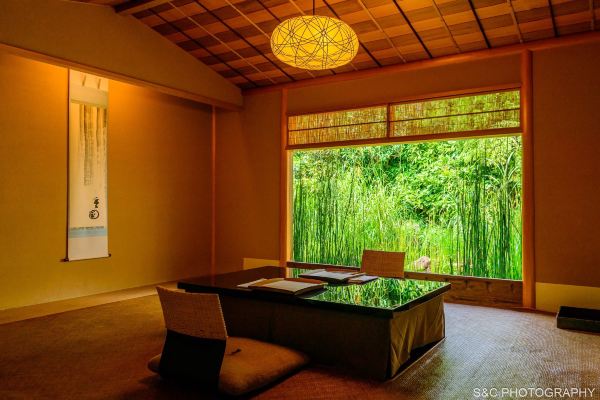
Yasaka-jinja Shrine
Just a short stroll from the enchanting streets of Gion lies the Yasaka-jinja Shrine, a spiritual cornerstone of Kyoto. This Shinto shrine, also known as Gion Shrine, is famous for its role in the Gion Matsuri, one of Japan's most renowned festivals. With its vibrant lanterns and serene atmosphere, the shrine provides a peaceful retreat and a chance to reflect amidst the bustling city. Spend an hour here to soak in the tranquility and admire the traditional architecture.
- 625 Gionmachi Kitagawa, Higashiyama Ward, Kyoto, 605-0073, Japan
- Suggested tour duration: 1-2 hour
- Open 24 hours
Sannenzaka & Ninenzaka
Continue your cultural journey to the picturesque lanes of Sannenzaka & Ninenzaka. These charming stone-paved streets, lined with quaint shops and inviting tea houses, are perfect for a leisurely exploration. As you meander through this historic area, you'll feel as though you've stepped back in time. The preservation of these neighborhoods allows you to experience the Kyoto of yesteryears, complete with the warmth and hospitality of its local artisans and shopkeepers.
- 2-chome, Masuya-cho, Higashiyama-ku, Kyoto 605-0826, Kyoto Prefecture
- Suggested tour duration: 1 hour
Kiyomizu-dera Temple
Conclude your day with a visit to the iconic Kiyomizu-dera Temple, a UNESCO World Heritage site that offers breathtaking views of Kyoto. The temple's veranda, jutting out from the hillside, provides a panoramic vista that is especially stunning during cherry blossom season or when the autumn leaves are ablaze with color. The temple's history, dating back to 780 AD, and its connection to the pure waters of the Otowa Waterfall make it a spiritual and historical treasure not to be missed.
- 1-294, Kiyomizu, Higashiyama-ku, Kyoto-shi, Kyoto, 605-0862, Japan
- Open from 01/01-03/22,6:00am-6:00pm;Open from 03/23-03/31,6:00am-9:30pm;Open from 04/01-06/30,6:00am-6:00pm;Open from 07/01-08/13,6:00am-6:30pm;Open from 08/14-08/16,6:00am-9:30pm;Open from 08/17-08/31,6:00am-6:30pm;Open from 09/01-11/17,6:00am-6:00pm;Open from 11/18-11/30,6:00am-9:30pm;Open from 12/01-12/31,6:00am-6:00pm
Where to Stay Tonight
Kiyomizu sannenzaka home in kyoto, kiyomizu sannenzaka.
- Day 2: Kyoto's Cultural Treasures and Culinary Delights
Fushimi Inari Taisha
Begin your second day in Kyoto with a spiritual start at Fushimi Inari Taisha, the head shrine of the god Inari, located at the base of a mountain also named Inari. Spend a couple of hours wandering through the thousands of vermilion torii gates that trail into the wooded forest of the sacred Mount Inari. This iconic site offers not only a mesmerizing walk through the gates, known as Senbon Torii, but also provides a glimpse into Shinto traditions and the opportunity to enjoy breathtaking views of Kyoto from the summit.
- 68 Fukakusa Yabunouchicho, Fushimi-ku, Kyoto, Kyoto Prefecture
- Suggested tour duration: 2-3 hour

Nishiki Market
After soaking in the tranquility of Fushimi Inari Taisha, make your way to the bustling Nishiki Market, a haven for food lovers. Known as 'Kyoto's Kitchen,' this narrow, five-block long shopping street is lined with more than one hundred shops and restaurants. With a history dating back several centuries, the market is the perfect spot to sample local specialties, such as pickled vegetables, fresh seafood, and Kyoto's distinctive sweets. Allow yourself to be tempted by the sights, sounds, and smells in this lively culinary heart of Kyoto.
- 609番地 Nishidaimonjichō, Nakagyo Ward, Kyoto, 604-8054, Japan
Nijō Castle
Conclude your day's exploration at Nijō Castle, a UNESCO World Heritage site that once served as the Kyoto residence of the Tokugawa Shogunate. With one hour to traverse its historical grounds, you'll marvel at the castle's ornate architecture, including its impressive gates and stone walls, surrounded by moats. Inside, the Ninomaru Palace is adorned with lavish paintings and carvings, while the 'nightingale floors' ingeniously chirp underfoot, designed to alert occupants of any intruders. The castle's expansive gardens are equally impressive, offering a serene setting to reflect on the day's journey through Kyoto's rich history.
- 541 Nijōjōchō, Nakagyo Ward, Kyoto, 604-8301, Japan
- Open from 8:45am-5:00pm,Castle closed days: December 29th to 31st at the end of the year. The specific business status is subject to the opening conditions on that day.
Toki No Yado Nijo
- Day 3: Temples and Trains - Kyoto's Cultural and Scenic Journey
As the sun climbs higher on our third day, we begin with a serene visit to Kinkaku-ji, Kyoto's golden pavilion that shimmers against the morning light. This Zen temple, adorned with gold leaf, reflects elegantly on its surrounding pond, creating a picture-perfect moment for any visitor. Spend an hour wandering the meticulously maintained gardens and soaking in the tranquil atmosphere of one of Kyoto's most iconic landmarks.
- 1 Kinkakujichō, Kita Ward, Kyoto, 603-8361, Japan
- Open from 9:00am-5:00pm

Continuing our temple trail, we delve deeper into Kyoto's spiritual heritage with a two-hour stay at Ryōan-ji, famous for its enigmatic rock garden. The simplicity of the stones set against raked gravel invites contemplation and calm, a stark contrast to the bustling city life. The temple grounds also boast a serene pond and lush greenery, offering a peaceful retreat to reflect and rejuvenate.
- 13 Ryōanji Goryōnoshitachō, Ukyo Ward, Kyoto, 616-8001, Japan
- Open from 8:00am-5:00pm
Arashiyama Sagano Romantic Train
After immersing in the tranquility of temples, we embark on a different kind of journey aboard the Arashiyama Sagano Romantic Train. This one-hour scenic ride takes you through the picturesque landscapes of rural Kyoto. As the train winds its way through the Hozugawa River valley, framed by seasonal beauty, be sure to capture the moments where nature's artistry and historical charm blend seamlessly, creating an unforgettable experience in the heart of Japan.
- Saga Tenryuji Kurodocho, Ukyo-ku, Kyoto City Torokko Saga Station to Torokko Kameoka Station
- Open from 9:02am-7:45pm,Train departure schedule is subject to change, please refer to the actual situation on site The official schedule: https://www.sagano-kanko.co.jp/jikoku.php

Hotel Binario Saga Arashiyama
Guest house atagoya.
- Day 4: Exploring the Vibrant Heart of Tokyo
Shinjuku City
Kickstart your fourth day by immersing yourself in the bustling energy of Shinjuku City, Tokyo's renowned district known for its dynamic urban atmosphere. As the sun rises, the streets of Shinjuku come alive, offering a full day's adventure amidst skyscrapers, shopping centers, and an array of dining options. This characteristic neighborhood is a microcosm of Tokyo's fast-paced culture and modernity, promising an unforgettable urban experience.
- Tokyo, Japan
- Suggested tour duration: 0.5-1 day

Shinjuku Gyoen National Garden
After the exhilarating buzz of Shinjuku City, find solace in the tranquil beauty of Shinjuku Gyoen National Garden. A mere stone's throw away, this sprawling oasis offers a serene retreat with its meticulously landscaped gardens blending Japanese, English, and French garden designs. Spend a couple of hours wandering through the lush greenery, beside the tranquil ponds, and under the shade of cherry blossoms, providing a picturesque contrast to the morning's metropolitan vibe.
- 11 Naitōmachi, Shinjuku City, Tokyo 160-0014, Japan
- Open from 10/1-3/14,Tue-Sun,9:00am-4:30pm;Open from 3/15-6/30,Tue-Sun,9:00am-6:00pm;Open from 7/1-8/20,Tue-Sun,9:00am-7:00pm;Open from 8/21-9/30,Tue-Sun,9:00am-6:00pm;Closed on Mon,*The park is open every Monday from March 25 to April 24 and November 1 to 15; Rest days: year-end and New Year holidays (December 29th to January 3rd).
Book Tea Bed Shinjuku-Gyoen
Toyoko inn tokyo shinjuku gyoemmae eki 3 ban deguchi.
- Day 5: Tokyo's Techno Vibes and Towering Views
Akihabara Electric Town
Begin your final day in Tokyo with a visit to the iconic Akihabara Electric Town, a buzzing hub that's a must-see for tech enthusiasts and pop culture aficionados alike. As you wander through Akihabara's vibrant streets, you'll be enveloped in a world where the latest gadgets, anime merchandise, and electronic wonders reign supreme. Dedicate your day to exploring the endless rows of shops and experience the unique otaku culture that has put Akihabara on the map.
- 1 Chome-12 Sotokanda, Chiyoda City, Tokyo 101-0021, Japan

After immersing yourself in modern marvels, step back in time with a visit to Sensō-ji, Tokyo's oldest and most significant temple. This historic monument, just a short journey from Akihabara, offers a serene contrast to the morning's high-energy exploration. Spend an hour marveling at the temple's grand architecture, the majestic Thunder Gate, and the vibrant shopping street of Nakamise, where traditional souvenirs and snacks provide a taste of old Tokyo.
- 2-chōme-3-1 Asakusa, Taito City, Tokyo 111-0032, Japan
- Open from 4/1-9/30,6:00am-5:00pm;Open from 10/1-3/31,6:30am-5:00pm

Tokyo Skytree
Conclude your Tokyo adventure on a high note with a trip to the Tokyo Skytree. As the day winds down, ascend to the observation decks of this towering structure, the tallest in Japan, and be rewarded with breathtaking panoramic views of the sprawling city below. Reflect on your journey as you gaze out over the skyline, spotting landmarks and the distant mountains, a fitting finale to your unforgettable five-day exploration of Tokyo and Kyoto.
- 1 Chome-1-2 Oshiage, Sumida City, Tokyo 131-0045, Japan
- Open from 04/01-04/06,10:00am-10:00pm;Open from 04/08-04/13,10:00am-10:00pm;Open from 04/16-04/20,10:00am-10:00pm;Open from 04/22-04/27,10:00am-10:00pm;Open from 05/07-05/11,10:00am-10:00pm;Open from 05/13-05/14,10:00am-10:00pm;Open from 05/16-05/18,10:00am-10:00pm;Open from 05/20-05/25,10:00am-10:00pm;Open from 05/27-05/31,10:00am-10:00pm;Open 10:00am-9:00pm on 04/15;Open 10:00am-9:00pm on 05/15;Open 9:00am-10:00pm on 04/07;Open 9:00am-10:00pm on 04/14;Open 9:00am-10:00pm on 04/21;Open from 04/28-05/02,9:00am-10:00pm;Open 9:00am-10:00pm on 05/12;Open 9:00am-10:00pm on 05/19;Open 9:00am-10:00pm on 05/26;Open from 05/03-05/06,8:00am-10:00pm,Last admission for the TOKYO SKYTREE Tembo Deck is 8 p.m. for the TOKYO SKYTREE Tembo Galleria is 8:30 p.m
Hotel Livemax Asakusa Sky Front
Entire typical japanese house1min walk to skytree.
* All user reviews in this article have been translated by machine.
* The information above is subject to change at any time. For the latest information, please check the websites of hotels and attractions.

<h3>Trending Searches</h3>
Popular Content
- Phuket 6 Days Itinerary
- Tangshan 2 Days Itinerary
- Wakayama 1 Day Itinerary
- Richmond Capital 2 Days Itinerary
- Linze 1 Day Itinerary
- Frankfurt Dresden 4 Days Itinerary
- Bergen Oslo 3 Days Itinerary
- Guigang Yulin 3 Days Itinerary
- Haixizhou 3 Days Itinerary
- New Taipei City 2 Days Itinerary
- Yingde 2 Days Itinerary
- Yantai 1 Day Itinerary
- Ji'an Nanchang 2 Days Itinerary
- Mengla 2 Days Itinerary
- Luxury Hotels in Paro
- Customer Support
- Service Guarantee
- More Service Info
- Website Feedback
- About Trip.com
- Terms & Conditions
- Privacy Statement
- About Trip.com Group
Other Services
- Investor Relations
- Affiliate Program
- List My Property
- Become a Supplier
Your browser is outdated
Please upgrade to a more modern version to fully experience JapanToday site and for security reasons

- Real estate
- Classifieds

New private rooms on Tokaido Shinkansen change the way we travel from Tokyo to Kyoto
Japan currently has 10 shinkansen (bullet train) lines to shuttle passengers around Japan at super high speeds, but the busiest by far is the Tokaido Shinkansen, which has been known to operate over 470 trains along the route in a single day. The Tokaido Shinkansen stretches from Tokyo to Kyoto and Osaka, making it the one that foreign tourists to the country are most familiar with, and soon there’ll be a new class of seat onboard that promises to be even more luxurious than the current first class-style Green Car option.
The Tokaido Shinkansen will soon have private rooms.
According to the operators of the line, Central Japan Railway Company (JR Central), the private rooms are part of the company’s desire to respond to the diversifying needs of customers’ changing life and work styles, and improve the business environment on board. Though they initially considered improving the Green Cars, which are predominantly used by business travellers, they decided to go above and beyond by creating private spaces that offer even higher quality facilities and services.
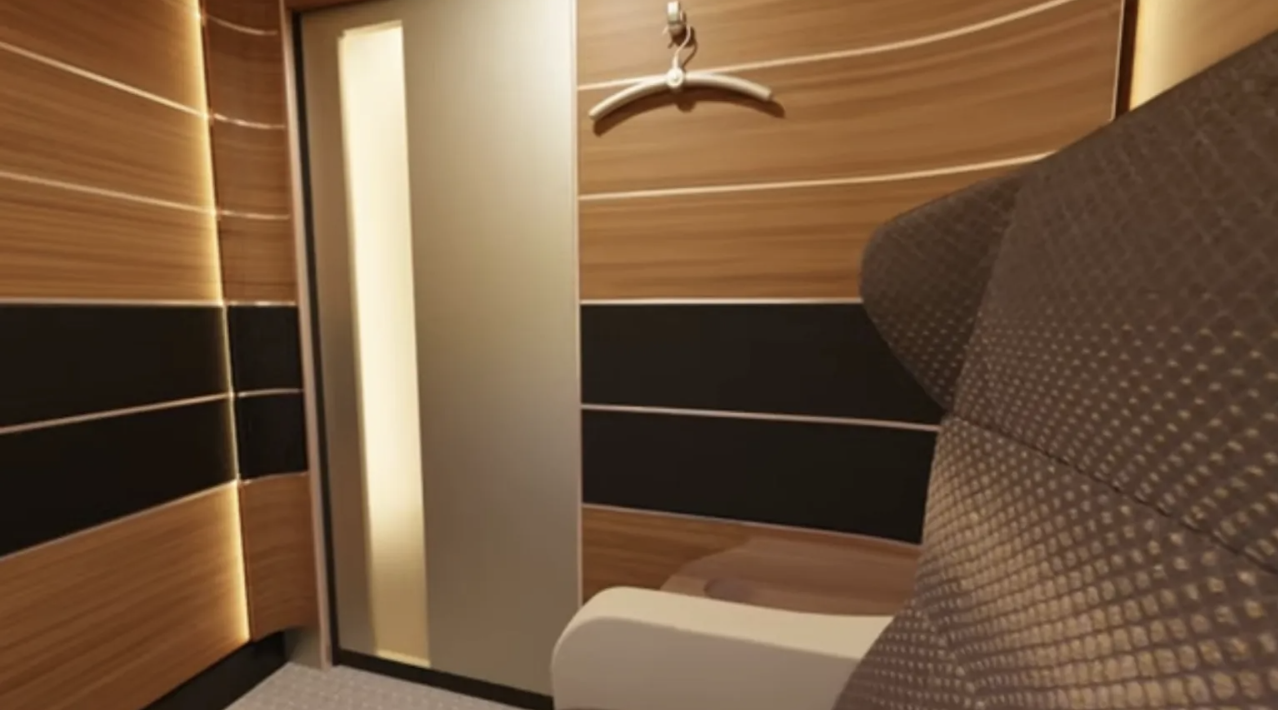
The new private rooms will be equipped on a number of N700S trains on the Tokaido Shinkansen route, with initially two per train. Each room will provide a high level of privacy, with some of the perks being free Wi-Fi, adjustable lighting, and a reclining seat with leg rest.
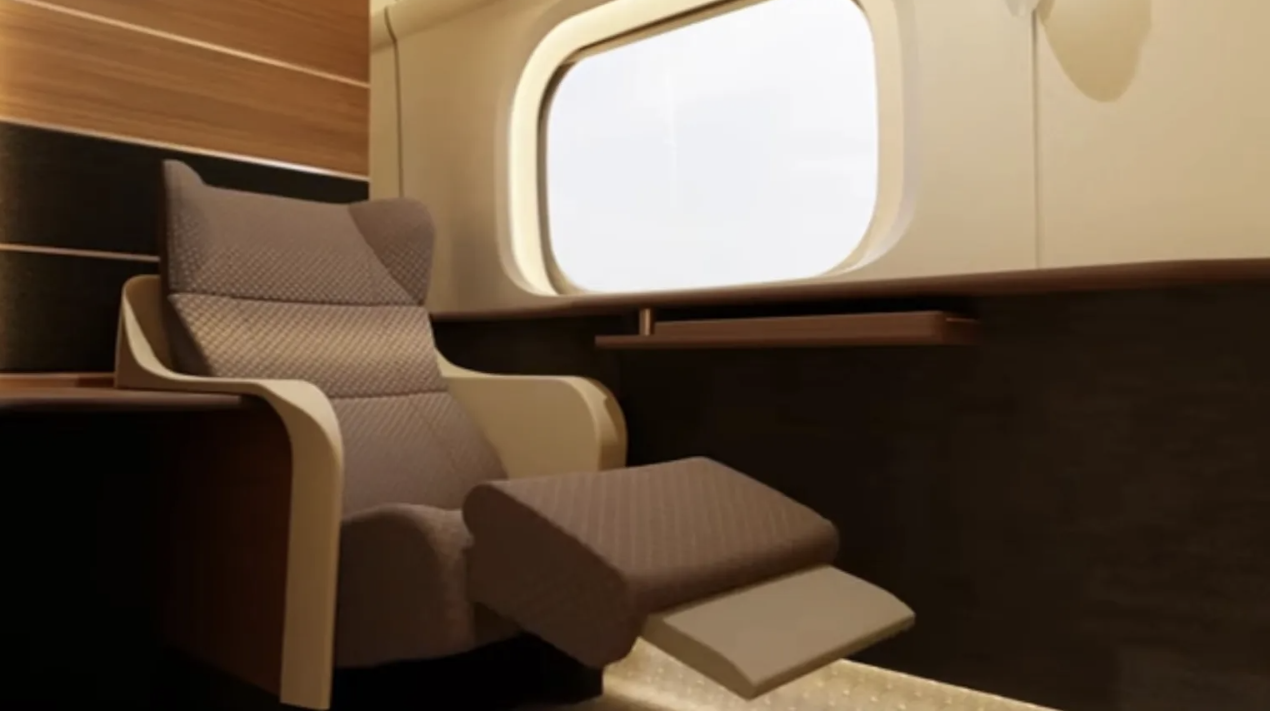
Other facilities planned for the rooms are an air conditioning panel and volume controls for the onboard announcements, allowing you to adjust the sound and temperature levels as well as the lighting to suit your personal needs.
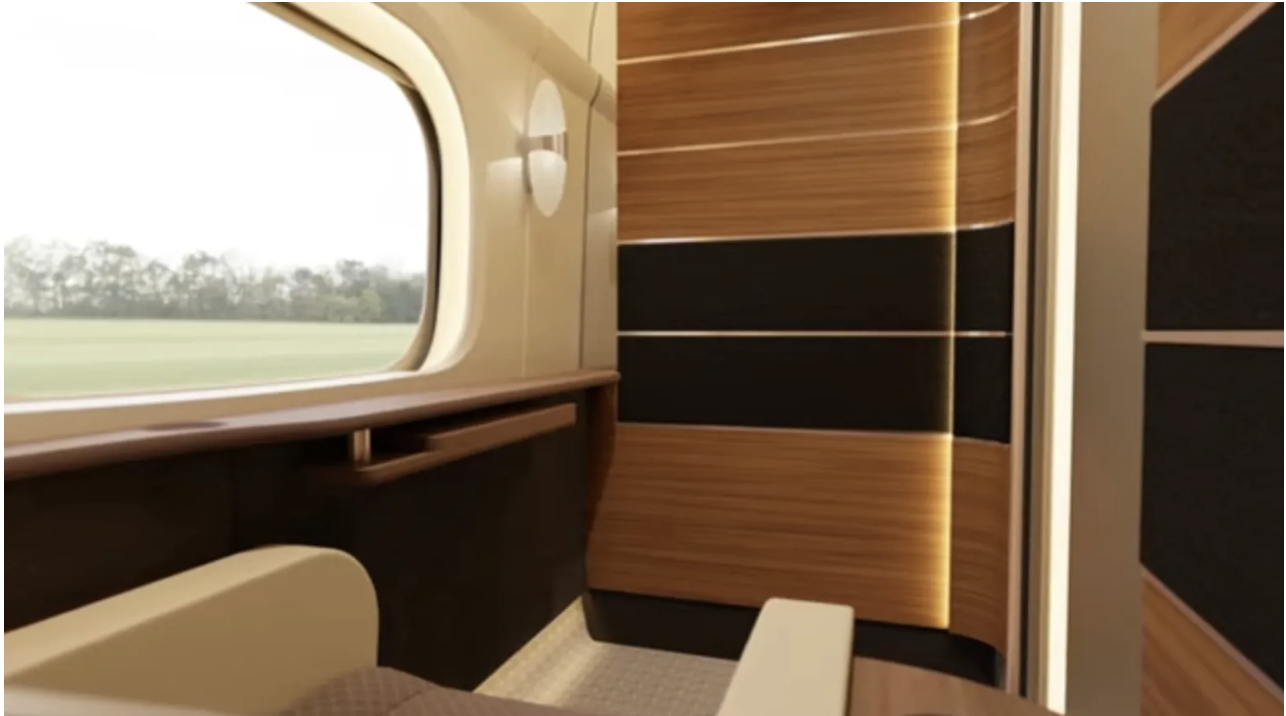
While the rooms are aimed at business travellers who might want to hold online meetings or make phone calls during their journey, anyone who wants to relax and enjoy some privacy will benefit from the new setup.
The private rooms will offer the highest level of comfort and privacy onboard a Japanese bullet train, and it’s one that’s set to be popular when it’s introduced in 2026. Further details regarding room specifications, services, operating zones and prices will be announced closer to the rollout date.
Source: JR East via Netlab
Insert images: YouTube/東海旅客鉄道株式会社
Read more stories from SoraNews24.
-- Tokaido Shinkansen ending in-train food/drink sales for all non-first-class-passenger cars
-- Nozomi Shinkansen bullet train abolishes low-priced unreserved tickets during peak travel seasons
-- Potentially dirty and broken used Shinkansen food/beverage carts on sale in Japan for 100,000 yen
- External Link
- https://soranews24.com/2024/04/22/new-private-rooms-on-tokaido-shinkansen-change-the-way-we-travel-from-tokyo-to-kyoto/

Superfast SIMs for expats & tourists
Explore Japan without limits with Mobal. Stay connected with reliable SIMs and eSIMs, with solutions for both expats and tourists. Get a real Japanese phone number from the best Japan SIM service for English-Speakers - it’s easy to use, there are no contracts, and delivery is free! Join Mobal today.
6 Comments Login to comment
Moonraker Apr. 26 07:49 am JST
anyone who wants to relax and enjoy some privacy will benefit from the new setup.
I can sense a new "must-do" in Japan coming.
wallace Apr. 26 07:51 am JST
DanteKH Apr. 26 09:54 am JST
Introverts paradise...
Probably they are going to cost 3 to 4 times the normal seat. Nice to travel Tokyo - Kyushu, if the company pays...
kohakuebisu Apr. 26 11:30 am JST
Another way to satisfy "the diversifying needs of customers’ changing life and work styles" would be to make the Shinkansen cheaper. For locals that is, not foreign tourists.
This room has only one seat, so its for posh people travelling alone. I've never got on the Shinkansen and thought "Jeez, I wish this was more like a private plane".
Hello Kitty 321 Apr. 26 12:28 pm JST
"New private rooms on Tokaido Shinkansen change the way we travel from Tokyo to Kyoto"
I do not know if "we" is the operative word in the headline, "they" would probably be more accurate as ordinary people won't be able to afford it.
Redemption Apr. 26 04:27 pm JST
That would be sweet, but how much?
Login to leave a comment
Facebook users.
Use your Facebook account to login or register with JapanToday. By doing so, you will also receive an email inviting you to receive our news alerts.
Login with your JapanToday account
Articles, offers & useful resources.
A mix of what's trending on our other sites

The 10 Best Things To Do in Hiroshima
GaijinPot Blog

25 Things to Do in Yokohama

The 10 Best Things To Do in Kawagoe

Understanding Mount Fuji’s New Fees and Rules

The 10 Best Things To Do in Shinjuku

The 10 Best Things to Do in Osaka

The 10 Best Things To Do in Saga

See Where Cherry Blossoms Are Blooming Now in Japan on GaijinPot Travel

Top 10 Nighttime Sakura Spots in Japan

The 10 Best Things To Do in Kobe

The Best 10 Things To Do In Kyoto

How to Visit Onsen With Tattoos in Japan for 2024
- Japan Tourism
- Japan Hotels
- Japan Bed and Breakfast
- Japan Vacation Rentals
- Flights to Japan
- Japan Restaurants
- Things to Do in Japan
- Japan Travel Forum
- Japan Photos
- All Japan Hotels
- Japan Hotel Deals
- Last Minute Hotels in Japan
- Things to Do
- Restaurants
- Vacation Rentals
- Travel Stories
- Rental Cars
- Add a Place
- Travel Forum
- Travelers' Choice
- Help Center
Tokyo to Kyoto Shinkansen train ticket online - Japan Forum
- Asia
- Japan
Tokyo to Kyoto Shinkansen train ticket online
- United States Forums
- Europe Forums
- Canada Forums
- Asia Forums
- Central America Forums
- Africa Forums
- Caribbean Forums
- Mexico Forums
- South Pacific Forums
- South America Forums
- Middle East Forums
- Honeymoons and Romance
- Business Travel
- Train Travel
- Traveling With Disabilities
- Tripadvisor Support
- Solo Travel
- Bargain Travel
- Timeshares / Vacation Rentals
- Asia forums
- Japan forum

What is the best way to buy high-speed train tickets from Tokyo to Kyoto?
Is there an online site where I can buy tickets?
If I don't buy online, are there many ticket offices in Tokyo?
4 replies to this topic

via the official website online.
https://smart-ex.jp/en/index.php
Physically in JR train stations via automated ticket vending machines or manned counters.
Have any JR station near Airport?
Airport train station.
- Pick up train passes 12:56 pm
- Best spots to watch skateboarding in Japan!? 12:52 pm
- Advise needed: Disneyland, Hakone.. how to plan 12:43 pm
- Welcome Suica from 2 years ago 12:09 pm
- Spending Money 13 days (Australia family) 12:00 pm
- Tax free shopping at Tokyo 11:58 am
- What else can we add for half day in Kyoto? 11:29 am
- Osaka Duck Tours 11:12 am
- Transiting through Haneda Terminal 2 to Terminal 3 10:59 am
- First time in Japan - Solo Traveller 10:55 am
- Transporting Tokyo to Kawaguchiko, Direct Train 10:27 am
- Buying a Kindle in Yokohama 10:06 am
- Parking to see Tenjinyama Fuji wisteria 9:50 am
- Fukuoka buses. Or stick with subway? 9:38 am
- 'semi double' rooms 5 replies
- Pocket WiFi Rental Experience? 315 replies
- kyoto-takayama JR or Lmtd express??? 6 replies
- Best Japan travel guide book? 29 replies
- Best/cheapest time of year to visit?? 3 replies
- Radiation danger in Tokyo? 37 replies
- Best Skiing in Japan? And When? 3 replies
- Japan in 10 days 3 replies
- How far is Nara from Kyoto 8 replies
- how to get to Hokkaido from Tokyo? confused..pls HELP. 5 replies
- 2024 public holiday chart in East Asian countries
- Where can I find more onsen in Japan?
- Driving Information
- Catholic mass in English and other languages
- How can we access tourist attraction from cruise port?
- Pocket WiFi Rental Experience?
- Halal Information
- Tokyo trip report here
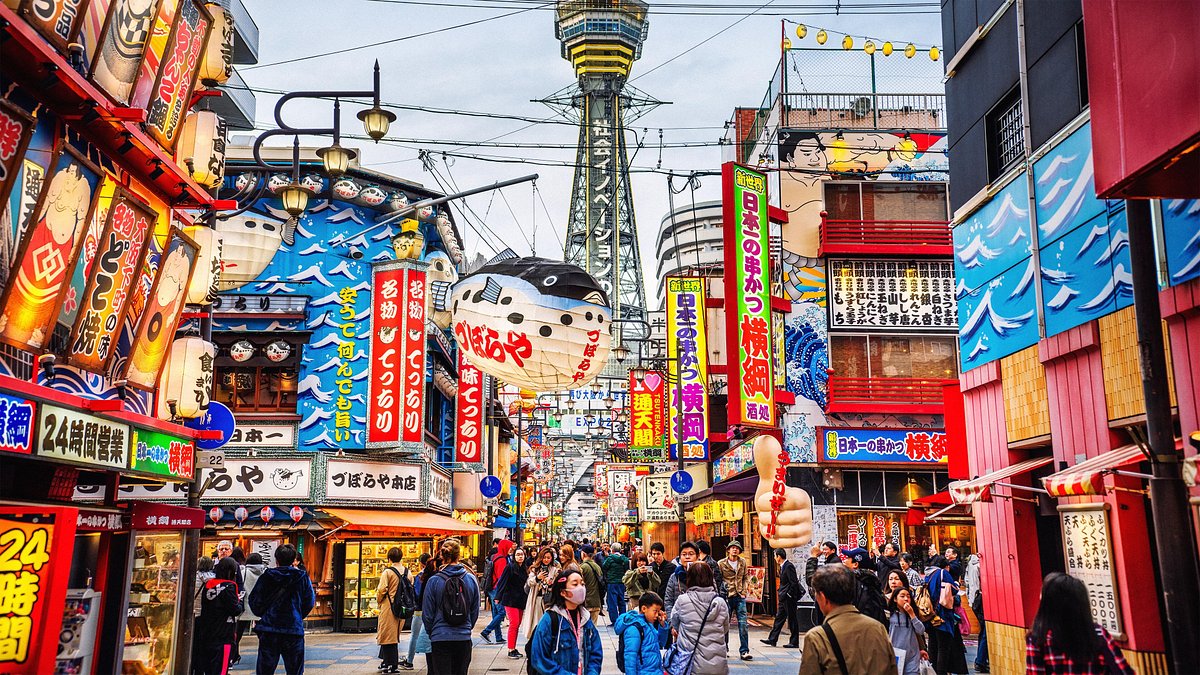
- Search Please fill out this field.
- Manage Your Subscription
- Give a Gift Subscription
- Sweepstakes
The Ultimate Japan Itinerary for LGBTQ+ Travelers
A-List travel advisor John Clifford shares a six-day itinerary to Japan.
:max_bytes(150000):strip_icc():format(webp)/john-clifford-lgbt-destination-ALISTJOHNC0718-2bf0123672ed4fa0851896a11d7a1dc0.jpg)
vladimir zakharov/Getty Images
John Clifford is a member of Travel + Leisure ’s A-List , a collection of the top travel advisors in the world, and can help plan your perfect getaway. Below is an excerpt from one of the many itineraries he creates — in this case, a food-focused sojourn through Japan.
Day 1: Arrival Into Tokyo
After arriving into Tokyo and checking in to the Trunk Hotel , you'll head to a half-day guided tour of the Outer Market and the Ginza shopping area, followed by a ramen dinner tour.
Outer Market
While the wholesale fish market has been relocated to its new Toyosu location, Tsukiji's Outer Market is as busy and bustling as ever. The Outer Market is a mixture of wholesale and retail shops selling everything from carrots to cakes, pottery to kitchen knives. It is also filled to the brim with restaurants serving the freshest sushi and sashimi. In contrast to Toyosu's new ultra-modern facility, Tsukiji's Outer Market retains an essence of traditional charm that makes it well worth a visit.
Manorath Naphaphone/Travel + Leisure
Ginza is Tokyo's most famous upmarket shopping, dining, and entertainment district, featuring numerous department stores, boutiques, art galleries, restaurants, night clubs, and cafes. One square meter of land in the district's center is worth over ten million yen, making it one of the most expensive real estate in Japan. It is where you can find the famous $10 cups of coffee and where virtually every leading brand name in fashion and cosmetics has a presence. From 1612 to 1800, today's Ginza district was the site of a silver coin mint, after which the district was eventually named. Ginza evolved as an upmarket shopping district following the 1923 Great Kanto Earthquake. Most shops in the Ginza district are open every day of the week. If you are feeling a bit hungry, or just interested in food, the depachika (basement floors) of department stores are filled with foods of all kinds. Most are already prepared and ready to take away and eat at home, which is exactly what many people do in order to balance busy work and home lives. A mouthwatering mix of Japanese and western dishes, sweets, and snacks await.
A Ramen Dinner Tour
During this personalized 2-3 hour ramen tour, your expert guide will take you to some of Tokyo's hidden ramen shops for lunch or late afternoon meal. He will take you to two ramen restuarants, one for a thick, rich bowl of ramen and one lighter bowl. Ask him any question about ramen and he will be able to answer. Meet your ramen expert in your hotel lobby.
Didier Marti/Travel + Leisure
Day 2: Touring Tokyo
Your guide will meet you in the hotel lobby for a private vehicle tour of Sensoji Temple and Kaminarimon Gate, and the Nakamisedori Sensoji Temple — possibly one of the most photographed structures in the city. An official temple was built in 645AD, making it not only the oldest temple in Tokyo, but among the oldest in Japan. Sadly, after standing for 1300 years, it fell to the bombings of WWII, only to be rebuilt during the aftermath as a symbol of peace and resurrection to the Japanese people. Today, millions of visitors pass through the Kaminarimon or Thunder Gate annually, known for the huge brightly painted lantern dominating the entrance. Just beyond Sensoji’s Kaminarimon you’ll find yourself on the Nakamisedori, a vibrant shopping street lined with souvenir shops selling everything from Samurai swords to paper fans, and all manner of snacks and trinkets. teamLab Planets One of Japan’s most creative spaces, this art encounter places you within large scale installations that combine digital and physical media. The variety here is impressive, with infinity rooms of digital light, knee-deep illuminated water, and mazelike cavernous halls of huge balloons. There are plenty of memorable surprises in this uniquely Japanese art space – and all highly Instagrammable.
Roppongi Hills
Roppongi Hills is one of the best examples of a city within the city. The building complex in the Roppongi district is home to an amalgamation of offices, apartments, shops, restaurants, a hotel, the Mori Art Museum , a view deck and more. The 238-meter Mori Tower at the center is one of the tallest buildings in the city. Just behind the tower and hotel is Mori Garden, and TV Asahi is also located on the site. The Mori Art Museum, located near the top of Mori Tower, shows innovative exhibitions of international contemporary art. At the heart of Roppongi's arts district, Tokyo Midtown feels almost like a city in itself. Home to a sophisticated mix of shops, galleries, and residences, it is a pleasant area to explore. The main shopping mall features international restaurants, a dining terrace, and a range of stores from everyday essentials to luxury boutiques. The complex also contains many museums and art galleries. Their top floor features interior design and houseware shops as well as the Suntory Museum of Art , a modern space with beautiful city views that displays traditional works.
In the Evening: Shinjuku
Shinjuku is one of the 23 city wards of Tokyo, but is often referred to as the huge entertainment, business, and shopping area around Shinjuku Station. Colorful signs decorate the narrow streets at all stories, blocking out the city sky and filling it with life. More than 2 million passengers go through Shinjuku Station every day, making it the busiest railway station in Tokyo, which effectively makes it the busiest railway station in the world. Shinjuku's skyscraper district is home to many of Tokyo's tallest buildings, including several premier hotels, the twin towers of the Metropolitan Government Office, and is also home to famous game companies, such as Square Enix (right outside Higashi-Shinjuku station). Dinner tonight is at Kaiseki Komuro for flavors of cha-kaiseki, a meal served during a traditional Japanese tea ceremony. Since opening in 2000, this two Michelin star restaurant has become a gem for urban gourmands that long to immerse themselves in the beauty of the seasons.
Day 3: Tokyo's Museums and Shopping
Your guide will meet you in the hotel lobby to head to the Nezu Museum , a collection that once belonged to Nezu Kaichiro, an industrialist and former president of the Tobu Railroad. Although he enjoyed everything from delicate calligraphy to Chinese bronzes, the center of the collection concerns “the way of tea.” There are several authentic teahouses scattered throughout the extensive gardens, as well as many lovely artifacts. A collection of painted folding screens in the Rinpa style is not to be missed. The museum’s grounds are a highlight as well. Designed by Kengo Kuma, one of Japan’s brightest architectural stars, the soaring roof and strategic use of glass and steel create a perfect setting for the works within.
Harajuku is the epicenter of Japanese street-fashion and fashion subcultures. The neighborhood's modern identity stems from the post-war history of the area, but its continuous development is heavily reliant on today's youth culture trends. The Harajuku area is divided by a boulevard called Meiji-dori, which separates its two main areas: Takeshita Street and Ura-Harajuku. The side most internationally associated with Harajuku is Takeshita Street, an extremely popular pedestrian street overflowing with fashion boutiques, sweet crepe stands, innovative snack shops, photobooths, and fast food outlets marketed to tweens and teens. Even though many of Takeshita Street's energetic trends are starting cross over to the other side, Ura-Harajuku has retained a more relaxed atmosphere. Its streets lie behind Omotesando and are filled with high-end vintage shops, street-fashion brands flagship stores, privately-owned boutiques, and cafes.
This area of Tokyo is just one station away from busy Shibuya, but has a very different atmosphere, with small high-end boutiques, restaurants and cafés sharing the space with embassies, high-class residential areas, and Hillside Terrace, the symbol of Daikanyama. The laidback vibe and trendy fashion found here has made it a hot spot among the hip crowds of Tokyo but remains a pleasant counterpart to the busy streets of Shibuya.
karimitsu/Getty Images
Tempura Cooking Class
This private cooking lesson from the head chef of one of Tokyo’s best tempura restaurants is the ideal way for travelers to experience Tokyo gastronomy at its finest. The tempura restaurant is located inside a former geisha house in a historical Tokyo district. You will learn cooking techniques from the head chef himself, and explore this Japanese specialty’s rich history by tasting and comparing Edo-period vs. contemporary tempura. As part of the class, participants enjoy a full course meal with a sake pairing personally selected by the chef.
Dinner at Sushi Saito
Chef Takahashi Saito is at the helm at this restaurant with 3 Michelin stars and near impossible to get seating. Booked in The Private Room, you will enjoy such delicacies as bonito sashimi, tender simmered octopus, kuruma-ebi shrimp, and more.
Day 4: Taking in Hakone
You'll take a bullet train to Kyoto, where you'll be staying at the Hakone Retreat Villa . Your guide will take you to the Old Tokaido road, a highway which once linked Tokyo and Kyoto during the feudal Edo Period. Today, you can enjoy a beautiful cedar-lined passage of the road along the shore of Lake Ashinoko. Even a short walk down the cobbled highway for a few minutes is a wonderful way to immerse yourself in the nature and history of the area. Visitors desiring a longer walk can continue deeper into the mountains towards the restored Amazakechaya Teahouse .
Hakone Shrine
Hakone Shrine stands at the foot of Mount Hakone along the shores of Lake Ashi. The shrine buildings are hidden in the dense forest but are well advertised by its huge torii gates, with one standing prominently in the lake and the other two over the main street of Moto-Hakone.
Hakone Open Air Museum
The Hakone Open Air Museum is a harmonious mix of nature and art. This museum allows visitors to experience the beautiful mountainous backdrop of Hakone while viewing numerous sculptures and art exhibits spread out across the museum’s grounds. The main building of the museum features works by various artists including Picasso.
Kaiseki Dinner at Nijo Yamagishi
Born from the near impossible-to-book the kaiseki favorite Tominokoji Yamagishi, Nijo Yamagishi is a chance to enjoy premium quality in a more casual setting, with hot pot cuisine from an exciting young chef.
tekinturkdogan/Getty Images
Day 5: Kyoto
You'll transfer for a stay at luxury royokan Yoshida-Sanso , the historical university villa of Prince Higashifushimi, then explore Gion. Gion is Kyoto's most famous geisha district located near Maruyama Park. The district has a number of traditional machiya townhouses where geisha and maiko (apprentice geisha) enter and exit in the evening when entertaining guests. Lucky visitors might catch a glimpse of a geisha on her way to her next appointment.
Tea with Maiko
Enjoy tea, conversation, and a short performance from one of the few professional maiko (geisha-in-training) still active in Kyoto. The teenage maiko will explain in detail about her life and what it takes to become a geisha – a rare opportunity that many travelers never have a chance to experience. This unique meeting is a great way to enjoy geisha culture in the former capital of Kyoto. You can take a photo with the maiko as well.
Dinner at Gion Nishikawa
Michelin-starred chef Masayoshi Nishikawa crafts unique, seasonal kaiseki dishes at this outstanding restaurant , and offers vibrant counter seating to interact and watch the chef's magic.
AwOiSoAk/Getty Images
Day 6: Temples and Culture in Kyoto
The Otagi Nenbutsuji Temple is one of Kyoto’s hidden gems due to its isolated location and a unique display of Buddhist art. Although the roots of this temple go back to the 8th century, the current grounds were revitalized in the modern era by Kocho Nishimura, a respected Buddhist artist and priest. In the 1980s, he invited worshippers to this small mountain temple to learn the techniques of stone carving to create 1,200 rakan (a disciple of Buddha) statues that are now on display at the temple. No two statues are the same, with many depicting lighthearted and comical features that you rarely find in Buddhist art. From singing priests and parents cradling babies to acrobats and surfers, all walks of life are present in stone at Otagi Nenbutsuji. Nishimura’s family continues to care for the temple and carry on his legacy of blending personal expression through art with the teachings of the Buddha.
Saga-Toriimoto Street
One of Kyoto’s best-kept secrets is this quiet district tucked away in the hills on the western rim of the city. A long street runs through a preserved village with rows of charming wooden houses below forested slopes. This is a rare chance to see a grouping of original thatched roof houses so close to the city. Many of these farmhouses are from the Meiji-era (late 1800s/early 1900s) and remain in their original state. At the top of the street is a lovely traditional teahouse with a mossy thatched roof and impressive torii gate. Along the road are several quaint shops selling regional crafts, including bamboo goods, pottery, and whimsical local folkart made from the cocoons of silkworms.
Arashiyama Bamboo Grove
The walking paths that cut through the bamboo groves make for a nice walk or bicycle ride. The groves are particularly attractive when there is a light wind and the tall bamboo stalks sway gently back and forth. The bamboo has been used to manufacture various products, such as baskets, cups, boxes and mats at local workshops for centuries. When you stop for lunch at Izusen Enjoy, you'll enjoy traditional vegetarian Buddhist cuisine ( shojin-ryori in Japanese) in a charming space on the backstreets of the quiet Sagano district. The vegetarian fare is sure to delight and surprise both your tastebuds and eyes.
Okochi Sanso Villa
This samurai-style villa is the former home and garden of the famous Japanese film actor Denjiro Okochi (1898-1962), known for his roles are fierce samurai in the early silent film days. The beautiful garden is dotted with rustic teahouses and hidden pathways that open onto expansive city views. One of the best spots for early autumn leaves in Arashiyama, the villa also has a rest area where matcha tea and unique sweets are served.
gyro/Getty Images
Kinkakuji Temple
Perhaps best known in English as the “Temple of the Golden Pavilion,” this icon of Kyoto rises above a quiet reflecting pond, shimmering in its layers of gold leaf regardless of the weather. A remainder of a former villa of the Shogun, the pavilion successfully incorporates three distinctly grand architectural styles: Shinden, Samurai, and Zen. Rebuilt in the mid-20th century, Kinkakuji remains the epitome of Kyoto's gilded past as the cultural capital of the nation. The layout of the garden is based on ancient Chinese writings, and the stones of the main pond serves as a representation of the Japanese islands themselves. As a whole, the entire landscape serves as a fine example of the magnificent villa that once occupied this space.
Candlelit Tea Ceremony and Ritual
As dusk falls and the city begins to settle, enter the traditional home of our in-house tea expert for a special experience. Candles light your way through the garden as you remove your shoes and step into a charming tea room. This special ocassion is multifaceted and focuses on more than just tea. You’ll begin with a glass of local sake paired with two light seasonal foods as a way to better understand the culinary culture of Kyoto. Purified by the sake, you are ready to move on to the main event: an informative tea ceremony served with sweets. Your host will explain the meaning behind the ritual and how it ties to both the mundane world and the spiritual realm. This is an ideal pre-dinner activity to whet the appetite and learn about an important element of Japanese culture.
To work with John or to read the complete version of his Japan LGBTQ+ culinary adventure itinerary, contact him at [email protected] .

IMAGES
VIDEO
COMMENTS
Shinkansen Bullet Train: fastest and comfortable. Bus: cheapest. Recommended itinerary for a day-trip to Kyoto from Tokyo. 1. Comfortable plan: Bullet Train round-trip. 2. Make the most out of your day: go by Bullet train and return by night bus. 3. Budget plan: round-trip by night bus.
A day trip from Tokyo to Kyoto can be made by taking an early Shinkansen to Kyoto and returning to Tokyo in the evening. The first Nozomi Shinkansen leaves at 6 a.m. and arrives in Kyoto shortly after 8 a.m. The last train back is around 9:30 p.m. and the round-trip costs about 26,000 yen per person. While it is possible to make a day trip to ...
Kyoto Access. By Shinkansen. The easiest way to go to Kyoto from Tokyo is by using the Shinkansen or bullet train. There are several types of Shinkansen, but you need to get on the "Nozomi", which only takes about 2 hours 20 minutes. And the cost is about 13,320 yen one way per person for free seating cars and about 14,000 yen for reserved ...
If you you're flying out of Haneda Airport, allow about 3.5 hours travel time from Kyoto to Haneda. The best way is a Hikari or Nozomi shinkansen to Shinagawa Station in Tokyo and then the Keikyu Line to Haneda. Japan Itineraries: Japan Itineraries Overview; 1 Week Japan Itinerary: Tokyo and Kyoto; 10 Day Japan Itinerary: Tokyo, Kyoto and ...
Our 3-day Tokyo to Kyoto itinerary breaks down the ancient capital by area (northwest, east & south Kyoto) so you can easily see all of the best sights. ... For your next trip, try our 2-day Tokyo to Kanazawa on 10,000 yen guide. Written by: Lily Crossley-Baxter. Lily's Tokyo favorites are: Shirohige Cream Puff Factory, ...
Taking the Shinkansen from Tokyo to Kyoto. From US$88.00 *. 2 hours and 15 minutes (fastest service) Buy a one-way ticket on Klook or Rakuten Travel Experiences, or a JR Pass in advance. The Tōkaidō Shinkansen connnects Tokyo and Kyoto (and terminates one stop further, at Shin-Osaka Station).
The Nozomi line takes approximately 3 hours one way and costs about 13,000 yen one way per person. Here are a couple of things you can do for your Kyoto day trip from Tokyo: 1. Visit Temples and Shrines. Kyoto is one of Japan's main religious centers with over 1,600 temples and shrines.
A day trip from Kyoto to Nara allows you to add a third city. Here is the perfect Tokyo-Kyoto 10-day itinerary. High-speed train Shinkansen: Michael von Aichberger / Shutterstock.com. Tokyo And Kyoto 10 Day Itinerary Summary. This itinerary includes three full days in Tokyo, four full days in Kyoto, a day in Nara and two travel days.
See the highlights of Kyoto on a full-day tour from Tokyo. Learn about the history of the region from your guide as you visit top attractions including Fushimi Inari Taisha, Sanjusangen-do Hall, and Kiyomizu-dera Temple. Enjoy a delicious lunch in Kyoto, and take a round-trip ride on the super-speed bullet train.
11:45: Travel to Downtown Kyoto. Exit Shoren-in and walk north (downhill) to reach Sanjo-dori Street. Walk a short distance west (left) on Sanjo-dori to reach Higashiyama Station on the Tozai subway line. Take it two stops west and get off at Kyoto Shiyakushomae (downtown). Noon: Lunch Downtown.
The Arashiyama Bamboo Forest entrance fee is FREE, which is another great reason to visit on your one day in Kyoto itinerary. Opening hours are Monday to Sunday from 5:30 am - 11:30 pm, and that is so convenient if you plan a day trip to Kyoto from Osaka. BOOK NOW: Arashiyama Bamboo Forest Tour. Arashiyama Bamboo Grove - Kyoto things to do.
Absolutely! From my numerous excursions, the blend of Tokyo's modernity with Kyoto's cultural capital essence is exhilarating. Boarding the train early from Tokyo station, it's a smooth ride to Kyoto, making it feasible even for a one-day trip. The key to a fulfilling Kyoto day trip is a well-planned Kyoto itinerary.
The only drawback of a single day-day trip to Kyoto from Tokyo is that if you prioritize the shrines and the temples it leaves little time for shopping if that's of interest. Helpful. A wonderful experience. Fahad_A, Dec 2023. This tour was the best for visiting amd exploring the beautiful city of kyoto in one day. The guide felt like a ...
This makes it a popular mode of transportation for tourists. So, let's talk travel specifics. From Tokyo Station, you're looking at a travel time of roughly 2 to 2.5 hours to Kyoto Station. The costs can vary, but a standard one-way trip usually sets travelers back around $100 to $120 during the off-season.
The one way trip from Tokyo to Kyoto by highway bus takes about 7-8 hours. There are daytime and overnight buses. Fierce competition on the Tokyo-Kyoto-Osaka route has produced a wide variety of comfort levels (from discount to super premium buses) and an abundance of low priced offers. ... Kyoto Subway One Day Card (800 yen) Unlimited use of ...
Below that, I've provided a Kyoto 1 Day itinerary that helps you see all of these attractions (except Nijo-jo Castle) in the most time-efficient manner possible: Kinkaku-ji Temple. Kinkaku-ji, the famed "Golden Pavilion," is Kyoto's most iconic sight, rising above its reflecting pond like an apparition. Fushimi-Inari-Taisha Shrine.
See our full Tokyo Two-Day Itinerary for details. Day 4: Travel to Takayama. Take the shinkansen from Tokyo to Nagoya and change to a Hida Wide View express train to Takayama. The total journey takes 4 hours, 20 minutes, and costs Y13,930. The Japan Rail Pass covers this leg.
A Trip to Immersive Journey through Timeless Traditions and Cultural Marvels of Japan. Begin in Tokyo, a dynamic metropolis where modernity meets tradition. Delve into the bustling streets, immerse in diverse neighborhoods, and explore historic landmarks. Then, venture to Kyoto, a city steeped in ancient traditions, boasting stunning temples ...
More Info. 5. Chichibu. Just an hour and a half from Tokyo by train, Chichibu is a great day trip destination to immerse yourself in nature. Enjoy a boat ride in Nagatoro river, or the breathtaking fields of pink mountain phlox, known as shibazakura in Japan. More Info. 6.
Kamakura has a great collection of Zen temples and an impressive shrine. Mt Fuji is a good trip if you want to climb it or just lay eyes on the famous mountain. Hakone is a good day trip or overnight trip if you like art museums and hot springs. Kyoto is 2.5 hours from Tokyo by comfortable shinkansen (bullet train) so you can visit it in one ...
7. Taste the sizzle of street food in Osaka. Travel time: under 30 minutes. Osaka's street-food stalls are a festival of lanterns and delicious, sizzling smells, enjoyable day or night - easily done in a quick jaunt from Kyoto. Since the city is known as "Japan's kitchen," arrive hungry.
This short but sweet five-day trip to Japan is filled with cultural experiences. Covering two major cities, Tokyo and Kyoto, the adventure takes you to see two completely different sides of Japan. In Tokyo, you'll experience modern art in Odaiba and dine at Robot Restaurant. In Kyoto, you'll learn about ancient Japanese traditions and geisha culture. Try your hand at sushi-making, then ...
Completing the scene are the serene reflecting pool and traditional Japanese gardens that contain lush foliage, manicured trees, and scenic walking paths. 1 Kinkakuji-cho, Kita-ku, Kyoto-shi, Kyoto, +81 075-461-0013, shokoku-ji.jp. Open daily 9am-5pm. Admission is 500 JPY. Admire Ryoan-ji Temple.
April 18, 2024 · 3 min read. Embark on a 5-day cultural odyssey through the heart of Japan, exploring the historic streets of Kyoto and the vibrant cityscape of Tokyo. Begin your journey in Kyoto's Gion district, where traditional wooden machiya houses line the streets. Spend 2 hours soaking in the atmosphere before heading to the Yasaka-jinja ...
Tokyo May 2nd 6:00 PM - May 9th 11:00 AM Food. Oyakodon Shoyu Ramen Tonkatsu May 2. Land at Narita Airport 4:25 PM Get to Shinjuku Station Check into my hotel ~ 6:00 PM Enjoy the nightlife and explore Golden Gai. May 3. Shinjuku Garden Tokyo Metropolitan Govt Building Godzilla Head 1:00 PM teamLab Planets Tokyo. Gundam Statue
Japan currently has 10 shinkansen (bullet train) lines to shuttle passengers around Japan at super high speeds, but the busiest by far is the Tokaido Shinkansen, which has been known to operate over 470 trains along the route in a single day. The Tokaido Shinkansen stretches from Tokyo to Kyoto and Osaka, making it the one that foreign tourists to the country are most familiar with, and soon ...
Japan forum. Japan forums. Parsa. 14 posts. Tokyo to Kyoto Shinkansen train ticket online. Apr 22, 2024, 5:28 AM. Hello. I have a 12 day trip to Jain and I want to go from Tokyo to Kyoto on April 30th.
The Ultimate Japan Itinerary for LGBTQ+ Travelers. A-List travel advisor John Clifford shares a 10-day itinerary to Japan. By. John Clifford. Published on April 20, 2024. A view of central Tokyo ...